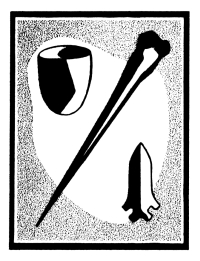
The Project Gutenberg eBook of Excavations at the LoDaisKa Site in the Denver, Colorado area, by H. J. Irwin
Title: Excavations at the LoDaisKa Site in the Denver, Colorado area
Authors: H. J. Irwin
C. C. Irwin
Release Date: December 20, 2022 [eBook #69574]
Language: English
Produced by: WebRover, Stephen Hutcheson and the Online Distributed Proofreading Team at https://www.pgdp.net
by
H. J. and C. C. Irwin

Supplementary Reports
by
W. C. Galinat, C. B. Hunt, G. E. Lewis,
R. Rodden, D. R. Whitehead
THE DENVER MUSEUM OF NATURAL HISTORY
Denver, Colorado
Proceedings, No. 8 October 1, 1959
LITHOGRAPHED BY
THE PEERLESS PRINTING COMPANY
DENVER, COLORADO
[Pg ii]

Figure 1—Area of Study.
[Pg iii]
This report, like most archaeological publications, was made possible only through the contributions and cooperation of many individuals. It is difficult to thank them all adequately.
Our greatest debt is to the editor of this publication, H. M. Wormington. She has provided an incalculable amount of information and assistance. More important, however, we have had the advantage of her knowledge and experience and have profited endlessly from her suggestions and criticisms. Without her guidance and encouragement this report could not have been prepared. We are also greatly indebted to Alfred M. Bailey, Director of the Denver Museum of Natural History, who made it possible for this report to appear in the Proceedings Series.
We are deeply grateful to the individuals who gave their valuable time and efforts to the preparation of the supplementary reports: Donald R. Whitehead, for his pollen studies; Robert J. Rodden, for the chemical and physical analyses of the soils; Edward Lewis, for his report on the identification of the fauna; Charles B. Hunt, for his description of the geology of the area; Walton C. Galinat, for identification and comments on the plant remains; and M. G. Towle, for her supplementary floral studies.
We are deeply indebted to James B. Griffin for his acceptance of carbon samples, which may ultimately provide an accurate chronology for the site. We owe a special debt of thanks to Jesse D. Jennings, Richard G. Forbis, Clyde Kluckhohn, Ruth M. Underhill, Evon Z. Vogt, Gordon R. Willey, and Stephen Williams. They contributed their valuable time and professional knowledge in their comments and criticisms of the paper. Paul C. Mangelsdorf provided helpful suggestions and important information on the maize section.
Others whose reading of the manuscript we have benefited from are J. O. Brew, J. B. Griffin, H. L. Movius Jr., and H. Smith.
J. O. Brew kindly made available to us collections in Peabody Museum, Harvard for study. We are grateful to Arminta Neal for her comments and suggestions on the illustrations. Photographic credits are as follows: Figure 2, T. S. Lovering (U.S.G.S.); Figure 3, F. M. Van Tuyl (U.S.G.S.); Figure 31 left and Figure 60, R. J. Rodden; Figure 76, R. F. Forbis. Within the supplementary reports, Figure 66 was drawn by C. B. Hunt (U.S.G.S.), and Figures 67 and 68 by R. J. Rodden. All other illustrations were prepared by the authors.
We are also grateful to LoDaisKa Bethel and her family. Her enthusiasm, knowledge of the area, and scientific spirit were ultimately responsible [Pg iv] for these excavations. To Otto Sanger we are indebted for the initial permission to excavate, for his friendship, and for the innumerable kindnesses which he and his family subsequently extended to us. Last, but by no means least, we wish to thank our mother, Eleanor C. Irwin, who has played a vital part in every stage of this operation, from field assistant and cataloguer, through to the final stages of typing and proofreading.
[Pg v]
| I. | Introduction | 1 |
| History of the Investigation | 1 | |
| Physiography | 1 | |
| Fauna and Flora of the Region | 3 | |
| Description of the Site | 5 | |
| Method of Excavation | 5 | |
| Preliminary Discussion of the Stratigraphy | 12 | |
| Objectives of the Monograph | 15 | |
| II. | The LoDaisKa Site: Features | 17 |
| III. | The LoDaisKa Site: Typology | 21 |
| Method | 21 | |
| Chipped Stone | 22 | |
| Projectile points | 22 | |
| Knives | 34 | |
| Scrapers | 42 | |
| Spoke-shaves | 43 | |
| Drills | 43 | |
| Perforators | 51 | |
| “Gravers” | 51 | |
| Other prismatic flakes | 51 | |
| Choppers or hammerstones | 54 | |
| Cores | 55 | |
| Ground Stone | 58 | |
| Milling stones | 58 | |
| Handstones | 58 | |
| Shaft-smoother | 66 | |
| Pigment stones | 67 | |
| Bone | 69 | |
| Beads | 69 | |
| Used bone fragments | 69 | |
| Notched bone | 69 | |
| Rib and scapulae cutting tools | 69 | |
| Gaming pieces | 69 | |
| Awls | 73 | |
| Cut bone | 74 | |
| Tools of antler and bone | 74 | |
| Flakers | 74 | |
| Problematical Objects | 78 | |
| Mica fragments | 78 | |
| Crystal | 79 | |
| Clay Ball | 79 | |
| Wood | 79 | |
| Leather | 79 [Pg vi] | |
| Cordage | 79 | |
| Pottery | 82 | |
| Plain | 82 | |
| Surface roughened | 83 | |
| IV. | Geology of the LoDaisKa Site by Chas. B. Hunt | 89 |
| V. | Mechanical and Chemical Analysis of the Soils | |
| of the LoDaisKa Site by R. J. Rodden | 91 | |
| Introduction | 91 | |
| Sampling | 92 | |
| Results and Discussion | 94 | |
| VI. | Faunal Remains in the LoDaisKa Site | |
| by Edward Lewis, et al | 100 | |
| Classification used in this report | 102 | |
| VII. | Plant Remains from the LoDaisKa Site | |
| by Walton C. Galinat: | ||
| additional identifications by M. C. Towle | 104 | |
| VIII. | Fossil Pollen and Spores from the LoDaisKa Site | |
| by Donald R. Whitehead | 114 | |
| IX. | Ethnographic Comparisons | 118 |
| The Ute | 119 | |
| The Pawnee | 124 | |
| X. | Dating the LoDaisKa Remains | 128 |
| XI. | Reconstruction and Interpretation | |
| Culture Complex A | 128 | |
| Typological Affiliations | 128 | |
| Cultural Reconstruction | 130 | |
| Culture Complex B | 132 | |
| Typological Affiliations | 132 | |
| Cultural Reconstruction | 134 | |
| Cultural Complex C | 135 | |
| Typological Affiliations | 135 | |
| Cultural Reconstruction | 138 | |
| Culture Complex D | 140 | |
| Typological Affiliations | 140 | |
| Cultural Reconstruction | 143 | |
| Other Remains | 145 | |
| XII. | Discussion | 146 |
| Traditions at LoDaisKa | 146 | |
| The Site in a Larger Context | 147 |
MAPS
| Figure | Page | |
| 1— | Area of study | ii |
| 66— | Geologic Map of the LoDaisKa Site | 90 |
| 74— | Location of principal sites referred to in text | 131 |
[Pg vii]
| Figure | Page | |
| 2— | Topography of the Morrison area | x |
| 3— | Morrison biome | 2 |
| 4— | LoDaisKa Site | 6 |
| 5— | LoDaisKa Site | 7 |
| 6— | Vertical section of overhang | 8 |
| 7— | Diagram of area excavated | 10 |
| 8— | Surface contours of LoDaisKa Site | 11 |
| 9— | Profile No. 1 | 13 |
| 10— | Profile No. 2 | 14 |
| 11— | Profile No. 3 | 15 |
| 12— | Block Diagram | 16 |
| 13— | Features of LoDaisKa Site | 18 |
| 14— | Cists | 20 |
| 15— | Projectile points, Type A | 23 |
| 16— | Projectile points, Type A, A₂; Type B | 24 |
| 17— | Projectile points, Type C | 25 |
| 18— | Projectile points, Type D | 26 |
| 19— | Projectile points, Type E | 27 |
| 20— | Projectile points, Type F; Type G | 28 |
| 21— | Projectile points, Type H | 29 |
| 22— | Projectile points, Type H | 30 |
| 23— | Projectile points, Type I | 31 |
| 24— | Projectile points, Type J | 32 |
| 25— | Projectile points, Type K | 33 |
| 26— | Projectile points, Type aa; Type bb | 35 |
| 27— | Projectile points, Type bb; Type xx; Type cc | 36 |
| 28— | Knives, Type one | 38 |
| 29— | Knives, Type two; Type three | 39 |
| 30— | Large knife, Type two | 40 |
| 31— | Large knives, Type two | 41 |
| 32— | End scrapers, Type one | 44 |
| 33— | End scrapers, Type three; Type two | 45 |
| 34— | Side scrapers | 46 |
| 35— | Discoidal scrapers | 47 |
| 36— | Uncompahgre scrapers | 48 |
| 37— | Serrated scrapers; spoke-shave | 49 |
| 38— | Drill types one-four; gravers | 50 |
| 39— | Perforators; flake knife, hafted knife | 52 |
| 40— | Prismatic flakes | 53 |
| 41— | Prismatic flakes | 54 |
| 42— | Choppers and hammerstones | 55 |
| 43— | Large milling stones | 62 |
| 44— | Flat granite milling stone | 63 [Pg viii] |
| 45— | Sandstone milling slabs | 64 |
| 46— | Handstones | 65 |
| 47— | Atlatl weight; abrader | 66 |
| 48— | Pigment stones | 67 |
| 49— | Bone beads; awls, type four | 68 |
| 50— | Rib-scapula cutting implements | 70 |
| 51— | Problematical pieces; worked mica; gaming pieces | 71 |
| 52— | Gaming pieces | 72 |
| 53— | Awls, type one | 75 |
| 54— | Awls, type one; type two; type three | 76 |
| 55— | Miscellaneous bone tools | 77 |
| 56— | Quartz crystal | 78 |
| 57— | Clay ball | 80 |
| 58— | Wood fragments | 81 |
| 59— | Plain Pottery bowl | 82 |
| 60— | Plain Pottery sherd | 83 |
| 61— | Surface roughened Pottery, Class I | 84 |
| 62— | Surface roughened Pottery, Class I; Plain Pottery | 85 |
| 63— | Surface roughened Pottery, Class II | 86 |
| 64— | Surface roughened Pottery, Class II | 87 |
| 65— | Surface roughened Pottery, Class III | 88 |
| 67— | Soil Analysis: Size distribution | 95 |
| 68— | Soil Analysis: | |
| Relative importance of fines; | ||
| Concentration of calcium carbonate; | ||
| Concentration of soluble iron | 97 | |
| 69— | Floral remains | 108 |
| 70— | Floral remains | 109 |
| 71— | Maize, Chapalote | 111 |
| 72— | Maize, “Popcorn” | 112 |
| 73— | Maize, Dent | 113 |
| 75— | Artifacts from nearby Woodland sites | 133 |
| 76— | Projectile points from Signal Butte | 137 |
| Table | I— | Projectile point provenience | 37 |
| Table | II— | Artifacts exclusive of projectile points and ground stone | 56, 57 |
| Table | III— | Milling slabs, complete specimens | 59 |
| Table | IV— | Milling slabs, fragmentary specimens | 60 |
| Table | V— | Handstones | 61 |
| Table | VI— | Soil Analysis: Distribution of particle-size fractions | 93, 94 |
| Table | VII— | Faunal remains | 103 |
| Table | VIII— | Floral remains | 107 |

Figure 2—Topography of the Morrison Area, just north of Site (Looking North). Center, Dakota Sandstone (Hogback). Left of center, light colored broken rocks, Fountain Sandstone. Left, Rocky Mountain Foothills.
[Pg 1]
The foothills of the Rocky Mountains, although readily accessible, are archaeologically almost unknown. Geographically they lie between two culture areas—the Desert Culture of the Great Basin to the west and the Plains cultures to the east. Environmentally the region preserves a special character unlike either the Basin or the Plains. The area around the town of Morrison, Colorado, some fifteen miles west of Denver, seemed to offer unusual potentialities for archaeological investigation because of the prominent rock formations and the possibilities of overhangs. Very little previous work had been done in the vicinity.
Dr. E. B. Renaud undertook the first archaeological reconnaissance of the area in 1931 and 1932. His survey was brief, but indicated the presence of several sites. However, the Morrison area is not ideal for the location of archaeological remains, principally because its mesophytic environment gives rise to little erosion. Since 1931 the only investigation was carried out by amateurs of the region. The most extensive survey was done by LoDaisKa Bethel, to whom we owe the discovery of the present site. The authors became aware of the importance of the area after a surface survey, and after the excavation of two rockshelters containing the remains of the Plains Woodland Culture (Irwin and Irwin, n.d.). Subsequent contact with Mrs. Bethel led to the excavation of the LoDaisKa Site.
The LoDaisKa Site is located beneath an outcrop of Fountain Sandstone, about a mile south of Morrison, on the ranch of Otto Sanger. Physiographically the Morrison area is part of the Southern Rocky Mountain Province. Broad elevated strips of granite, running north and south, are flanked by dipping sedimentary rocks. The latter are generally lower and form foothills. Both once formed continuous anticlinal structures, now deeply eroded (Fenneman, 1931). The granite masses are usually mountainous, but occasionally form vast plateaus such as South Park. Locally they are capped by remnant sedimentaries. [Pg 2]

Figure 3—Morrison Biome, looking west. Central Ridge is the Hogback. Note encroachment of trees along watercourses and at higher elevations.
[Pg 3] For over half the mountain frontage of this Province, a very resistant formation, the Dakota Sandstone, creates a “hogback”. A valley of weaker sedimentaries lies between it and the foothills, beginning about two miles to the west. The Fountain Sandstone, locally known as the “Red Rocks” formation, outcrops in this depression.
Mountain streams collecting in the inter-ridge valley form a trellis drainage pattern. Master streams cut through the Dakota Formation creating watergaps. The LoDaisKa Site lies in the shelter of an outcrop of the Fountain Sandstone which rises some 60 feet above the valley. The site lies at an elevation of about 6200 feet.
Climate
| Precipitation | Temperature | |||||
|---|---|---|---|---|---|---|
| Av. Ann. | Max. | Min. | Mean Ann. | Mean Ann. Max. |
Mean Ann. Min. |
|
| Morrison | 14.20″ | 22.96″ | 7.51″ | [1] | ||
| Denver | 15.70±″ | 23.10″ | 7.84″ | 50.3° | 63.2° | 37.3° |
| Av. Ann. Snowfall | ||||||
| 55.6″ | ||||||
The Morrison area as a floral biome is characterized by its transitional nature, from the plains to the east and the mountains to the west. Harrington (1954) has designated the environment as the Mountain Shrub Subdivision of the Mountain and Plateau Area.
Especially characteristic of the zone are the following plants:
From the Ponderosa Pine-Douglas Fir Subdivision the following characteristic plants overlap:
[Pg 4]
These distinctive plants have invaded from the prairie fringe:
The nature of the faunal belt characteristic of the Transition Zone is varied. Both boreal and austral mammals are represented. Only six species appear restricted to it, two squirrels of the Sciurus aberti group, three pocket gophers of genus Thomomys and a small brown bat. The following mammals are not restricted to the Transition Zone but are characteristic of it in the eastern foothills:
Mammals common to the Transition and Upper Sonoran Zones include:
The following are common to the Transition and Canadian (mountain) Zones:
[Pg 5]
Common to the Transition, Canadian and Upper Sonoran Zones are:
The above lists were drawn mainly from Meritt Cary’s Biological Survey of Colorado (1911). Though this is the most complete work available, it is somewhat out of date and contains certain species names that have been superseded. An effort was made to check this with more modern works, such as Warren’s Mammals of Colorado (1942), but this was not always possible.
The rockshelter itself is now a moderately large overhang, measuring some 40 feet in width and 15 feet in depth. As Fig. 6 indicates, the ceiling slopes upward rapidly and only the inner yard or so is completely protected from rain or drizzle. When first inhabited, the floor of sand and gravel sloped up to the mouth (west), and presumably continued into the flat valley outside. At the time of excavation, however, the surface sloped to the north. This difference appears to have been due to the collapse of a considerable portion of the adjacent cliff face, creating an enormous mound of dirt and sandstone, which washed in from the north during the latest stages of occupation.
The small intermittent stream, Strain Gulch, flows in front of the shelter on a southwest-northeast axis. It has cut down its bed to a gravelly-bouldery layer corresponding to the lowest level at LoDaisKa. The fill between the stream and the site is of a wet limey nature. Excavation was extended in this direction as far as was feasible. Beyond the stream lies a valley about one-half mile wide, bounded on the west by the foothills of the Rocky Mountains.
In preparation for excavation, a vertical rod was driven in the southern sector and the datum point established twenty inches above the ground surface at this spot. A second stake was located on a north-south line from the first (using magnetic north) at the opposite end of the shelter. A horizontal line connecting these stakes at the level of the datum point was considered the baseline. The area of the rock shelter to be excavated was then laid out in one yard squares. Letters were assigned to the grid lines running east-west, and numbers to those running north-south. Each square was designated by the grid lines intersecting at its northeast corner. To facilitate exact measurement, a series of stakes was set up along the baseline at intervals of two yards. From locations on the stakes on the same horizontal plane as the datum point, lines were extended to corresponding pitons driven into the rear wall of the overhang. A second series of connecting lines formed a suspended grid of two yard squares. [Pg 6]

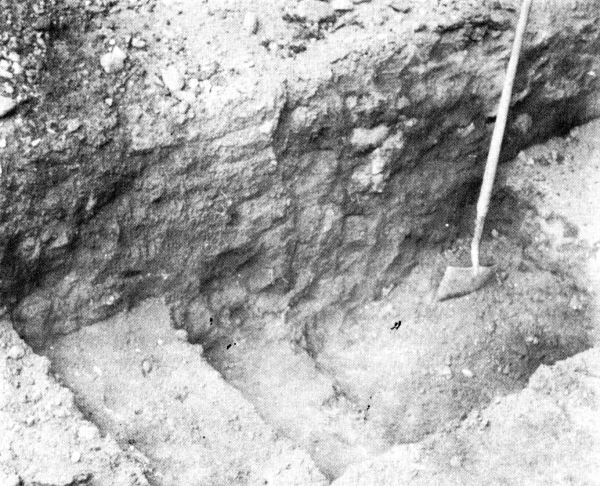
Figure 4— LoDaisKa Site. Above, prior to excavation (Looking North). Below, preliminary test trench. Note homogeneous character of deposit.
[Pg 7]
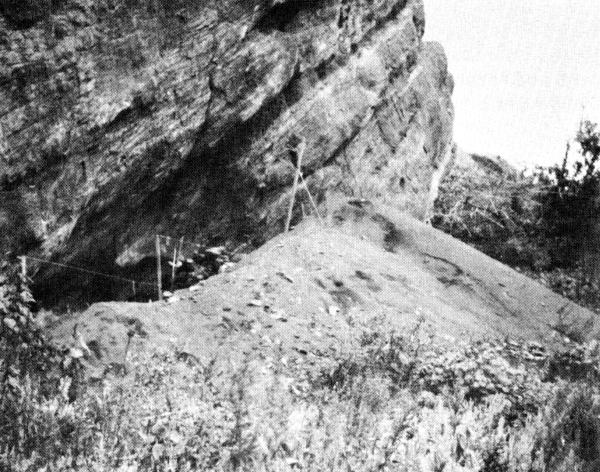
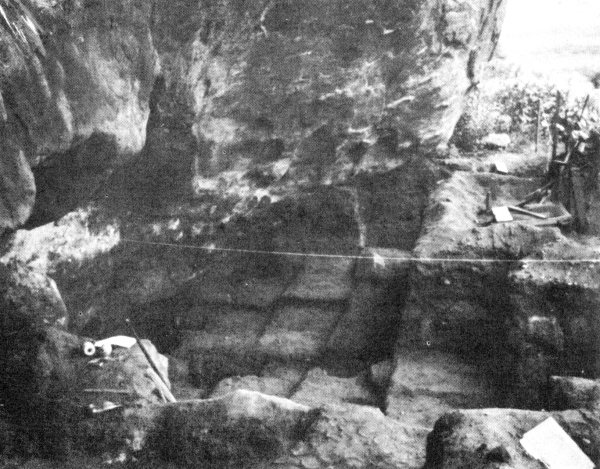
Figure 5— LoDaisKa Site. Above, during excavation (Looking South). Below, just prior to completion, all but one strand of aerial grid removed. (Looking North).
[Pg 8]

LODAISKA SITE
Figure 6— Vertical section of Overhang
[Pg 9] A preliminary test trench one yard wide and four yards long, was dug in squares M6-9 to determine whether complete excavation was warranted. Subsequent yard square test pits were sunk at P 7-8 and K 8. It was hoped that these would indicate the nature of the geologic stratigraphy and at least suggest the range of cultural materials which might be expected. Since excavation seemed warranted, the entire area to be worked was cleared of the surface layer of manure.
As set forth in the description of the site, the recent floor sloped up toward the northwest (Fig. 8). Test excavations indicated that the basal layer was approximately horizontal in a north-south direction, but sloped gently up toward the west. There seemed to be no significant correlation between geologic stratigraphy (see below) and typology in any except the lowest layer, which had not yet been extensively investigated. Because the evidence was as yet so scanty, it was decided to excavate with reference to both the surface and the datum point. Each square was treated as a separate unit and, except where natural levels were apparent, excavation proceeded in four inch levels measured from the surface at the northeast corner. Each level was also correlated with the datum point.
Both typological provenience and the position of the basal layer indicated that the major portion of the deposit had been laid down horizontally. To test this hypothesis a careful watch was kept for fragmentary specimens, in the hope of finding corresponding pieces from separate locations. The relative positions of these would suggest the nature of the surface on which they were deposited. Ten such fragments found comprised five artifacts: three potsherds, one handstone and one fragmentary grinding slab. Though some occurred as much as twelve yards apart, each pair fell within the same vertical level. From this analysis it appeared that the occupation levels were in fact approximately horizontal.
Stepped excavation seemed advisable in view of the unconsolidated nature of the deposit (Fig. 5). Vertical exposures more than two feet high collapsed as soon as the lower portions became thoroughly dry. These conditions made stratigraphic columns or balks impractical in most instances. However, by the use of rip-rapping, it was possible to leave a reference balk one foot wide on the north side of line N 5-11.
All material recovered was sifted through quarter inch mesh screens. Since it was fairly loose and dry, most of the earth was removed with shovels. Trowels, brushes and a flexible baby bottle for blowing were employed when features or artifacts in situ were encountered. The location of the screening dump was determined by test augering of the area between the site and the creek. This dump was separated from the excavation by a catwalk and low earthworks. The latter served the dual purpose of guarding against sliding from the dumps, and keeping out water which often poured over the edge of the overhang in the extremely rainy season of 1957. [Pg 10]

LODAISKA SITE
Figure 7— Diagram of area excavated at the LoDaisKa Site.
[Pg 11]

Figure 8—
Surface contours of LoDaisKa Site,
prior to excavation.
[Pg 12] Artifacts were sacked and later marked by level and square. Floral remains were similarly treated. Faunal material was rather sparse, and was therefore segregated by twelve inch levels measured from the datum point. All features were recorded and located on the map by means of a transit, and located vertically by measurements from the baseline.
The method and objectives of this monograph can best be understood in relation to the nature of the stratigraphic situation. Therefore, it appears desirable to present first a basic and unelaborated view of the stratigraphy which will be discussed more fully later. As shown in Figs. 9, 10, 11 and 12, there were four levels of natural stratigraphy. When excavation of the test trench and adjoining pits was finished, it appeared that only the lowest could be correlated with any single culture. However, the others were useful in intra-site correlation. This lowest level (four) was a bed of indefinite depth, composed of gravel and boulders of Late Wisconsin age (Hunt, this report). Above it lay a homogeneous deposit (level three) consisting of sand and silt mixed with cultural debris, from 54 to 63 inches thick. About three-fourths of the way up there was a scatter of rather large rocks and gravel, which appears to represent some kind of maximum inwash or roof-fall into the site. The next natural level (two) is of reddish sand, a maximum of one foot thick, with very sparse cultural materials. This red sand layer is considerably thicker in the southern end of the site than elsewhere, tapering off gradually to the north till it disappears about on line H. The same is true of the top layer (one), a bed of dusty brown fill about four inches thick in the main part of the site, showing a slightly greater intensity of occupation. Together these produce a floor sloping down toward the north. The whole unit finally was overlain by a layer of cow dung.
The authors recognize several occupations or cultural units at the site. The first is confined to the lowest geological layer, and appears to represent remnants of an Early Lithic stage on the Plains. The second has roots in the Great Basin and is confined to the third geological layer. It is represented in its purest form from the beginning of the third natural level to about 72 inches below the baseline. However, some types characteristic of this occupation continue upwards, tapering off slowly and disappearing at about 53 inches below baseline. The third unit represents a Plains oriented culture, beginning at about 72 inches below the baseline and extending to about 53 inches. The fourth occupation is a variant of Plains Woodland Culture extending from about 53-30 inches below baseline. The final occupation begins at about 48 inches and extends to the surface. The authors feel that it represents a variant of the Fremont Culture of Utah and western Colorado. [Pg 13]
Legend

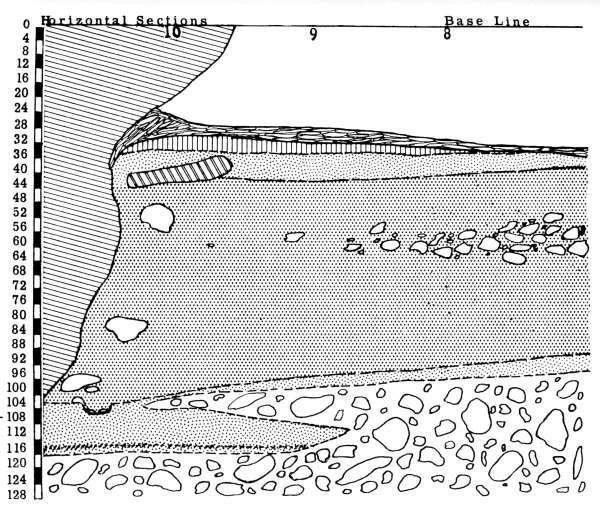
PROFILE No. 1
LODAISKA SITE
Figure 9— Profile of Face of J 7-11.
[Pg 14]

PROFILE No. 2
LODAISKA SITE
Figure 10— Profile of Face of M 6-11.
[Pg 15]

PROFILE No. 3
LODAISKA SITE
Figure 11— Profile of Face of Q 6/7—9/10.
These divisions are arbitrary and based on typology. There is some degree of overlap. Since the fill is shallow compared to the time range represented, there was undoubtedly a considerable amount of mixing, plus the ever present chance of re-use. Characteristically, as Jennings (1957) found at Danger Cave, the beginning of any cultural type is more apt to be a synchronic affair than its end.
The bulk of the present monograph will be devoted to a description of the cultural remains uncovered at the LoDaisKa Site, and delineation of [Pg 16] the circumstances of their discovery. However, an accumulation of facts loses much of its significance if no attempt at organization and interpretation is made. “The archaeologist must make some effort to integrate as well as observe his material, or he becomes a technician rather than a scientist.” (Heizer, 1958). It is realized that cultural units must be defined primarily on the basis of typology, because of the general lack of corresponding geological units. In this connection, the present state of flux in Great Basin taxonomy renders the results less absolute than might be desired. For this reason considerable emphasis has been placed on making as much as possible of the raw data available.

BLOCK PROFILE, LODAISKA SITE
EXCLUDING COW DUNG LAYER
Figure 12— Block Diagram showing relation of the strata.
The object of the interpretive study will be twofold: 1) to make a comparative analysis of the typology of the LoDaisKa artifacts in relation to both the Plains and Great Basin Culture areas (see Kroeber, 1939); 2) to make some attempt, on the basis of the archaeological remains and analogies with ethnologically observable data, to provide some insight into the total culture of the inhabitants as it existed at the time of occupancy. Of course, as one progresses further from the empirical evidence, to higher levels of interpretation the reliability of the conclusions decreases proportionately (MacWhite, 1956).
The primary difficulty, as indicated, is the absence of stratigraphically isolated culture units. Because of this a certain amount of overlap is to be expected: a small geologic unit represents a long and apparently uninterrupted occupational continuum. The resultant telescoping would increase the effects of trampling and other disturbance. However, it became increasingly apparent during excavation that, on the basis of typology and overall stratigraphic relationships, at least four complexes should be recognized; a broken point and a few flakes found in the lowest geologic stratum suggest a fifth. Two of these cultures appear to be affiliated with the Great Basin, three with the Plains.
[Pg 17]
Eleven hearths were found; they may be characterized briefly as follows:
Hearth A. Location: south edge square P8-9, top 36 inches below baseline. Simple pit excavated into underlying soil, filled with charcoal and ash, seven inches deep and ten inches in diameter.
Hearth B. Location: center at axis of lines 0 and 8-9, top 56 inches below baseline. Concentration of charcoal and ash, no pit, nine inches thick, eight inches wide and 13 inches long.
Hearth C. Location: square L9, top 48 inches below baseline. Concentration of charcoal and ash: rock-filled. Twelve inches thick, 15 inches wide, 28 inches long.
Hearth D. Location: square J9, top 40 inches below baseline. Concentration of charcoal and ash six inches thick. Almost circular, 12 inches in diameter.
Hearth E. Location: square K9, top 60 inches below baseline. Rock-filled, charcoal and ash mixed in. Six inches thick, almost circular, 12 inches in diameter.
Hearth F. Location: between squares 08-9 and 07-8, top 61 inches below baseline. Charcoal and ash; rock-filled. Nine inches thick, almost circular about 16 inches in diameter.
Hearth G. Location: square N7-8, top 30 inches below baseline. Charcoal and ash interspersed with small rocks. Sixteen inches thick, 27 inches long, 18 inches wide.
Hearth H. Location: square J8, top 40 inches below baseline. Charcoal and ash and rock. Thickness nine inches, length 20 inches, width 15 inches. This hearth was oriented with its length parallel to the rear wall of the shelter, while all other oblong hearths lay with their length at right angles to it. [Pg 18]

Figure 13— Features.
[Pg 19] Hearth I. Location: square E7, top 49 inches below baseline. Charcoal and ash rock-fill. Ten inches thick, 16 inches long, 12 inches wide.
Hearth J. Location: square L7, top 72 inches below baseline. Charcoal and ash concentration interspersed with rocks somewhat larger than those found in other hearths. Eight inches thick, 15 inches wide, and 28 inches long.
Hearth K. Location: square L7, top 40 inches below baseline. Charcoal and ash with a few rocks. Eight inches thick, 15 inches long and 12 inches wide.
Hearth L. Location: center at axis of Lines 0 and 6-7. Top 42 inches below baseline. Charcoal and ash, rock-filled. About eight inches thick, more or less circular, approximately nine inches in diameter.
In addition to these hearths the whole shelter had minor concentrations of charcoal and ash in every level. Such debris was, in fact, found throughout the soil in varying quantities.
Three features encountered were termed cists. All were located in the rear of the shelter in the center section. All were flat-bottomed basins dug into the sand underlying the Piney Creek alluvium (see C. B. Hunt’s report below). Around the sides of these were set small rocks with more or less flat surfaces. Within Cists A and C were found remains of seeds.
Cist A. Location: square J11, top 102 inches below baseline. Almost circular, inside diameter at top 14 inches, bottom eight inches. Five inches deep. Contents: Dirt covering cache of acorns decomposed except for a thin shell. No ash or charcoal.
Cist B. Location: square L11, top 100 inches below baseline. Circular. Inside diameter at top, 17 inches, at bottom 11 inches. Depth 7 inches. No contents but dirt. This differs from the other two, also, in that it is more basin-shaped with less steep walls.
Cist C. Location: square L11 overlapping into K11, top 90 inches below baseline. Circular. Inside diameter at top 13 inches, at bottom, 8 inches. Depth 6 inches. Contents: Graminae (spp.), Grayia brandegei, Lithospermum boraginaceae ruderale, all in small quantities (see botanical report below). [Pg 20]
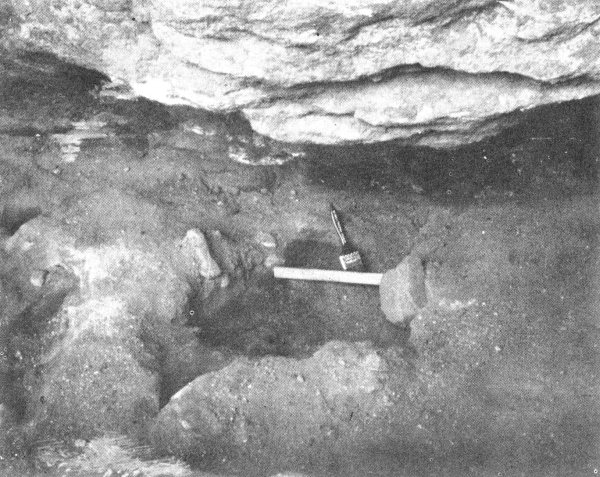
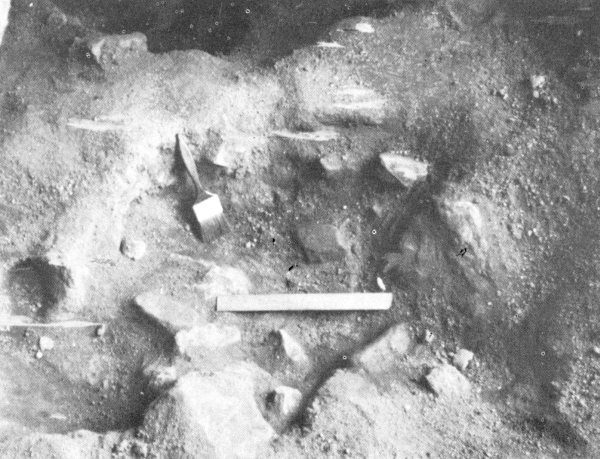
Figure 14— Features. Above, Cist C. Below, Cist A.
[Pg 21]
One often notices an emphasis on projectile points in archaeological reports, especially in studies of non-ceramic or pre-ceramic cultures. Archaeology as a historical science must integrate all the data with their own context and with events which preceded and followed. In searching for data that provide such chronological and geographical correlation (e.g. horizon styles in the sense of Willey and Phillips), there are certain basic needs. Though any cultural element could be used in correlations of this kind, some are less useful because their forms are governed by function, and others are fundamentally common and form traditions rather than horizon styles (e.g. grinding stones in some parts of the United States). A horizon marker must have some kind of stylistic development which allows variation outside of function. In cultures without pottery, as Willey and Phillips have pointed out (1958), projectile points become the most important artifacts in classification and integration because, 1) the usual economic mode of subsistence of people at this level renders a plentiful supply of such artifacts, and 2) as artistic representations they are sensitive to styles yet remain stable for adequate periods of time.
Projectile points from the LoDaisKa Site are therefore treated differently from certain other artifacts. We have illustrated all of the projectile points from pre-ceramic levels. Where these make up a type all of the artifacts of this type, even though it may extend into ceramic times, are so treated. This has been done for two reasons: 1) A major portion of the material is apparently affiliated with the Great Basin. Great Basin types are extremely variable and difficult to classify. 2) Cultures of that area have been, until recently, little investigated and cultural patterns which are not now recognized may some day be distinguished; the authors hope to create a record which will be useful even when new data come to light. For ceramic periods we forgo such detail for two reasons: 1) Pottery is present as a more sensitive marker. 2) The points found are usually uniform enough to fit into a few internally consistent categories.
We have divided projectile points into 16 categories, 8 major ones. This is primarily for convenience; secondly because some categories probably do represent cultural types; and thirdly because there are morphological ranges which may be described briefly in terms of a basic pattern. We believe with Cressman (1956) that some form existed in the minds of their makers and that a certain amount of variation is consistent within a type. It is worth noting the testimony of certain Ute informants who claimed that each tribe made its own recognizable form of point. (See below, p. 122.)
[Pg 22]
PROJECTILE POINTS: CLASSIFICATION
A Blade wide, leaf-shaped, edge usually convex, stem straight or contracting, leaving pronounced shoulder, no barb, base concave. Largest 1½34? × ¹⁵/₁₆ inches, smallest ⅞ × ⁹/₁₆ inches, (Fig. 15).
A1 Blade wide, leaf-shaped, edge convex, stem expanding, shoulder, no barb, concave base. Two specimens, ¾ × ½, 1? × ½ inches, (Fig. 16).
A2 Blade triangular, straight edge, lateral barb, stem straight—slightly contracting, base deeply concave. Two specimens, ⅞ × ⅝, 1¼ × ⅞ inches, (Fig. 16).
B Blade leaf-shaped, edges convex, stem contracting but no shoulder, base concave. Largest 1½? × ⅝, smallest 1? × ½ inches, (Fig. 16).
C Blade triangular, edge straight or slightly convex, all serrated, pronouncedly expanding base as wide or wider than blade giving the impression of high corner notches, definite barb rare. Largest 1⅜ × ⅝, smallest ⅞? × ⅝ inches, (Fig. 17).
C1 Blade triangular, two specimens straight sides, one shouldered, all deeply serrated, two concave based, one straight. Three specimens, 1½? × ¾, 1¼ × ½, 2? × ¾ inches, (Fig. 17).
D Blade triangular, length three to four times the width, edge sinuous: tapering from barb to center, expanding toward point, then tapering off; stem expanding, narrower than blade, base concave or straight. Largest 2¼? × ⅞, smallest 1½ × ¾ inches, (Fig. 18).
E Blade triangular to leaf-shaped, edges straight or convex, shallow to deep side notches, base concave or convex, expanding or contracting. Largest 1¾? × ¾, smallest ¾ × ½ inches, (Fig. 19).
F Blade triangular to leaf-shaped, straight to curving edges, stem nearly as wide as blade, giving almost the appearance of side-notching, base straight to slightly convex, two specimens serrated. Largest 1⅞ × ¾, smallest 1¼ × ¾ inches, (Fig. 20).
G Blade triangular, edge concave, stem narrow, straight or slightly expanding and rather small, barbs projecting to level of base giving impression of double basal notch, base convex. Largest 1 × 1, smallest ⅞ × ¾ inches, (Fig. 20).
H Blade triangular to leaf-shaped, rounded shoulders, stem narrower than blade, base rounded, serrated. Largest 1½ × ½, smallest ⅞ × ½ inches, (Figs. 21, 22).
I Blade triangular, curving edges, stem narrower than blade, expanding, giving the appearance of corner notching, barbs straight, distinct, base convex. Largest 1½? × 1, smallest ¾ × ⅝ inches, (Fig. 24).
J Blade triangular to leaf-shaped, edges straight or slightly convex, four serrated, base expanding, corner-notched, barb pronounced, base straight or convex. Largest 1¼ × ⅞, smallest 1 × ⅝ inches, (Fig. 24).
K Blade triangular, sides straight or slightly convex, distinct down-curving barbs, base expanding narrower than blade, gives appearance of corner notching, base straight or slightly concave, four serrated. Largest 2 × 1, smallest ⅞ × ⁵/₁₆ inches, (Fig. 25).
L Two specimens of quartzite, both shown in Fig. 25. Blade leaf-shaped, indented bases, oblique parallel flaking, edges ground on first specimen in Fig. 23 about one inch up from base. The second specimen also has ground edges.
[Pg 23]

Figure 15— Projectile Points,
TYPE A
[Pg 24]
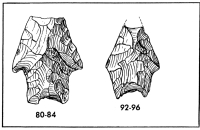
TYPE A1
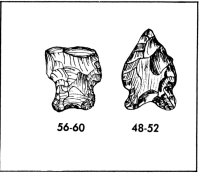
TYPE A2
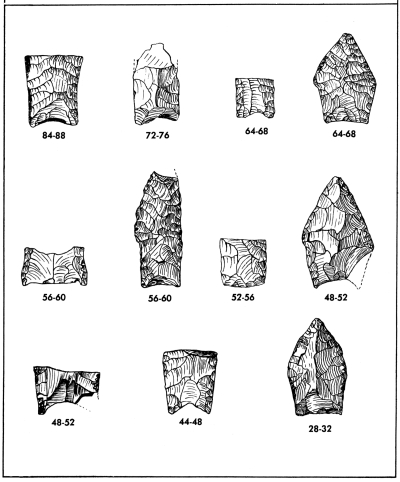
TYPE B
Figure 16— Projectile Points, Types A1 A2 B.
[Pg 25]
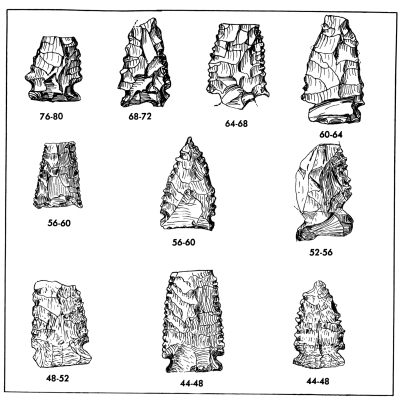
TYPE C1
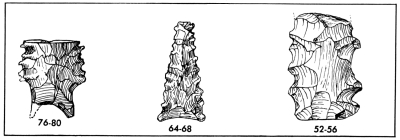
TYPE C2
Figure 17— Projectile Points, Types C and C1.
[Pg 26]

Figure 18— Projectile Points, Type D.
[Pg 27]

Figure 19— Projectile Points, Type E.
[Pg 28]
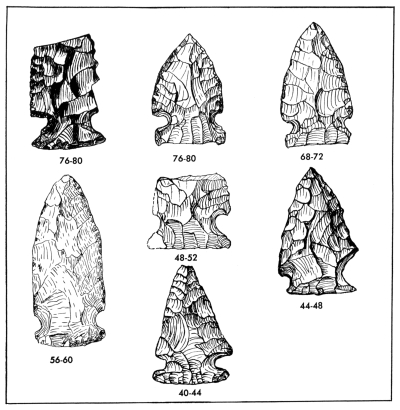
TYPE F
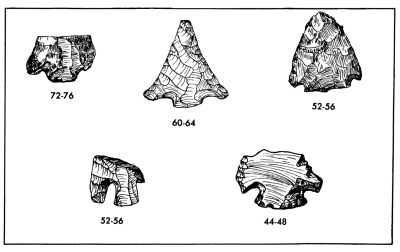
TYPE G
Figure 20— Projectile Points, Types F and G.
[Pg 29]

Figure 21— Projectile Points, Type H.
[Pg 30]
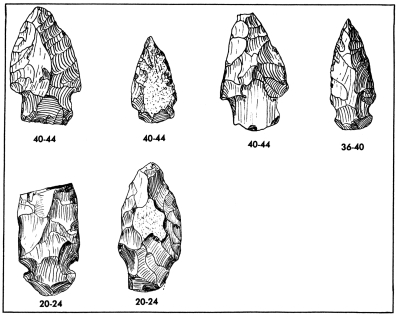
TYPE H
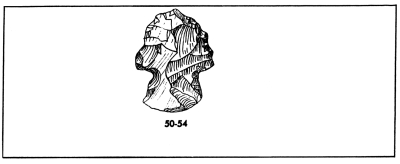
UNIQUE SPECIMEN
Figure 22— Projectile Points, Type H and Unique Specimen.
[Pg 31]

Figure 23— Projectile Points, Type L.
[Pg 32]
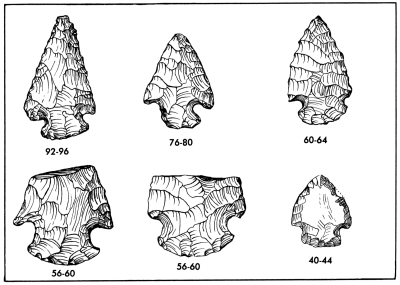
TYPE I

Figure 24— Projectile Points, Types I and J.
[Pg 33]

Figure 25— Projectile Points, Type K.
[Pg 34]
Arrow Points
aa Blade triangular, corner-notched, length 1¼ times the width, base generally convex, expanding, often just slightly narrower than blade. Largest 1⅛ × ½, smallest ⅝ × ½ inches. Points of this type are generally much lighter and thinner than those above, (Fig. 26).
bb Blade triangular, edges either convex or concave, specimen’s length generally twice width, almost all serrated, stems usually straight, generally ½ width or less. Largest 1 × ½, smallest ¾ × ⅝ inches. A variation of this type is less long in relation to width, but has its base located a-centrally. Careful examination reveals no differential of wear on the sides such as would be expected if they were used as knives. (Fig. 26).
cc These points are located morphologically between types aa and bb and do not fit into either category. Largest 1¼ × ⅜, smallest ⅝ × ½ inches, (Fig. 27).
Other Projectile Points
x A blunt point, large expanding base, shoulders pronounced, blade semi-ellipse shaped. One point 1 × ⅞ inches, (Fig. 27).
xx Four specimens, located stratigraphically in pre-pottery levels. All are flake points, rather small and light, in general fit into category H. Largest 1 × ½, smallest ¾ × ⅝ inches. These may have been children’s toys? (Fig. 27).
A “grainy” quartzite was used for 85 percent of the dart points. For the arrow points, the preference was not as marked, for it constituted only 55 percent of the total. The remainder were of crypto-crystalline or “flinty” quartz.
There are four types of knives or bifacially worked cutting implements. All are relatively thin, less than ¼ inch thick, and flaked on both sides, often with broad shallow chipping. The first type consists of small ovoid bifaces. The largest of these measures 2¼ × 1 inch, the smallest ⅞ × ⅝ inches with most being about 1 × ¾ inches. The majority resemble Fig. 28, being slightly asymmetrical although some are more triangular. They were probably used as small knives, possibly hafted. Since the point is usually off-center, and they are generally thick in relation to their size, they do not appear to be projectile point blanks, though a few of the finest may have been. They are usually of a crypto-crystalline quartz. One is of obsidian. There is a total of 41 pieces. [Pg 35]
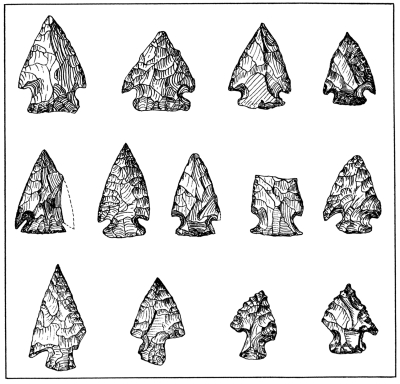
aa
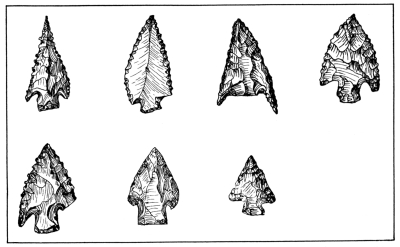
bb
Figure 26— Projectile Points, Types aa and bb.
[Pg 36]

bb
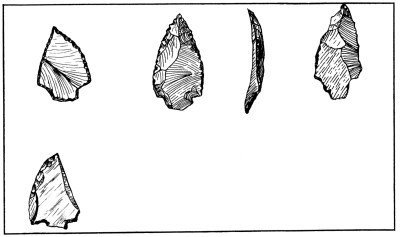
xx
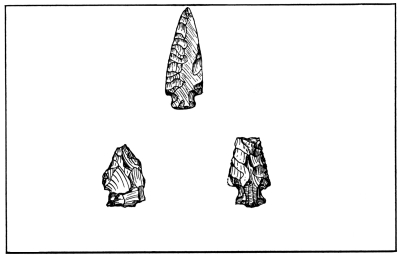
cc
Figure 27— Projectile Points, Types bb, xx, cc.
[Pg 37]
PROJECTILE POINT PROVENIENCE
(Notice Overlap)
| Depth in inches |
A | A1 | A2 | B | C | C1 | D | E | F | G | H | I | J | K | L | aa | bb | bb1 | cc | xx |
|---|---|---|---|---|---|---|---|---|---|---|---|---|---|---|---|---|---|---|---|---|
| 4-8 | ||||||||||||||||||||
| 8-12 | ||||||||||||||||||||
| 12-16 | ||||||||||||||||||||
| 16-20 | ||||||||||||||||||||
| 20-24 | 1 | 2 | ||||||||||||||||||
| 24-28 | ||||||||||||||||||||
| 28-32 | 1 | 4 | ||||||||||||||||||
| 32-36 | 3 | |||||||||||||||||||
| 36-40 | 1 | 1 | 3 | 4 | 1 | 4 | ||||||||||||||
| 40-44 | 2 | 1 | 1 | 4 | 4 | 8 | 3 | 2 | 5 | |||||||||||
| 44-48 | 1 | 2 | 1 | 1 | 1 | 2 | 5 | 6 | 3 | 2 | ||||||||||
| 48-52 | 2 | 1 | 2 | 1 | 1 | 3 | 10 | 2 | 2 | 2 | ||||||||||
| 52-56 | 2 | 1 | 1 | 1 | 1 | 1 | 2 | 1 | 2 | 6 | 2 | 1 | ||||||||
| 56-60 | 3 | 1 | 2 | 2 | 1 | 1 | 2 | 5 | 4 | 2 | ||||||||||
| 60-64 | 4 | 1 | 1 | 1 | 1 | 1 | 4 | |||||||||||||
| 64-68 | 1 | 2 | 1 | 1 | 2 | 1 | 1 | 2 | ||||||||||||
| 68-72 | 5 | 1 | 1 | 1 | 1 | 3 | 1 | 1 | 1 | |||||||||||
| 72-76 | 1 | 1 | 1 | 1 | 1 | |||||||||||||||
| 76-80 | 1 | 1 | 1 | 2 | 2 | 1 | 1 | 2 | 1 | |||||||||||
| 80-84 | 1 | 1 | 2 | 1 | 1 | |||||||||||||||
| 84-88 | 1 | 2 | 2 | |||||||||||||||||
| 88-92 | 2 | 1 | 2 | |||||||||||||||||
| 92-96 | 1 | 1 | ||||||||||||||||||
| 96-100 | 1 | |||||||||||||||||||
| 100-104 | ||||||||||||||||||||
| 104-108 | 1 | 1 | 1 | |||||||||||||||||
| 108-112 | ||||||||||||||||||||
[Pg 38] There are 25 specimens of the second type. These are characterized by an asymmetrical triangular form, usually with one gently curving side, a second more rounded side, and straight or slightly rounded base (Fig. 29). In general they show flat broad flakes at right angles to the edges with short retouch flakes and usage scars all around. The largest is 3¾ inches long, and two inches wide, and is made of obsidian (Figs. 30, 31). Another example is 3¾ inches long and 1½ inches wide (Fig. 31). The smallest is 1¾ × 1 inch.

Figure 28— Knives, type one (Small ovoid bifaces). Actual size.
[Pg 39]

Figure 29— Knives. A-F, type two. G-K, type three. Actual size.
[Pg 40] The third group includes 14 examples. The construction of these is similar to group two, but they are generally thicker, more symmetrical and usually longer and narrower. The largest is 2½ × 1, the smallest 1½ × ¾ (Fig. 29).
There are in addition 15 broken pieces belonging to one or the other of the last two categories.
Eleven pieces were classified as flake knives. These are characterized by manufacture on a flake, with flaking on both faces but only along one edge. Shape is variable, but the cutting edge is generally curved. Largest, 2 × 1¾ inches, smallest 1½ × 1 inch.
One large stemmed artifact with straight sides and a blunt point is felt to have been a hafted knife. The base is broken. Estimated length, 2 inches, width 1⅓ inches. The material is quartzite.
For all the categories of cutting implements, approximately 70 percent were made of flinty or crypto-crystalline quartz; a rather large number were of fossilized wood, not commonly used for other artifacts.
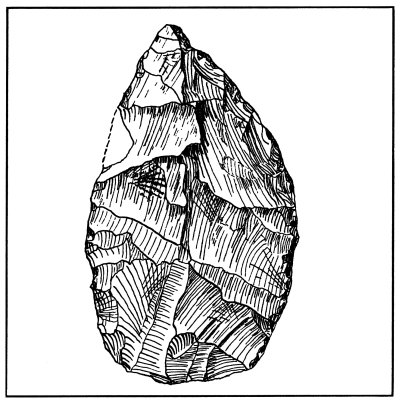
Figure 30— Large obsidian knife, type two. Actual size.
[Pg 41]

Figure 31—
Large Knives, type two.
Slightly larger than actual size.
[Pg 42]
The end scrapers are divisible into three categories. The first form is a flat scraper, generally triangular to oval in outline. The working end is often thin. There are a few true snub-nosed scrapers in this category. The second type is generally fan-shaped with a wide thin bit. The opposite end usually tapers to a sharp edge which could have had secondary use as a cutting tool. The third variety includes rougher forms, though there are a few well made specimens. All have a distinct keel. There are 31 of the first type, the smallest ½ × ⁷/₁₆; the largest 1¼ × 1½ inches. Of the second group there are 17 specimens, the smallest 1¼ × ¾; the largest 1½ × 1¼ inches. There are 10 of the third form, the smallest 1 inch square, the largest 2½ × 1½ inches. Seventy percent of the scrapers are of crypto-crystalline quartz.
Twenty-three specimens are classified as side scrapers. In general, as with discoidal scrapers, it is hard to draw a line between these and utilized flakes. An arbitrary division was made because, when the material was laid out, some specimens consistently showed more regular work or flaking than others. The largest of these is 2½ × 1 inch, the smallest 1¼ × 1 inch. In general, they are long flakes with considerable flat flaking and/or retouch along one face, usually on only one edge. Quartzite and crypto-crystalline quartz were about equally popular.
Twenty-five artifacts are classified as discoidal scrapers. Again, as noted in the case of side scrapers, the dividing line between some of these and certain utilized flakes is somewhat arbitrary. Generally these artifacts are steeply flaked, by percussion, on both faces and all edges, giving them a rather rounded appearance. The largest is 2½ × 2¼ inches, the smallest ¾ × 1½ inch. Quartzite and flinty materials show about equal usage.
There are 21 serrated scrapers. These are usually serrated on one edge only, but other sides often show secondary usage. The serrations appear to have been made in the course of the primary flaking, by blows dealt at intervals, with the remaining protrusions left instead of being chipped off. Some with steep sides would have been useful as scrapers, but several small thin specimens could have been used as saws. Flinty materials were preferred. The largest is 2 × 1¼, the smallest 1 × ¾ [Pg 43] inches. From the ethnographic data (see below) it is interesting to note that the Ute used serrated scrapers for taking the hair off hides.
Six complete and one broken artifact are included in this category. They conform in general to Wormington and Lister’s (1956) description of those found at the type locality. Those at LoDaisKa are smaller. Specifically they are flakes, usually triangular, although one is rectangular. One edge is flaked on one face alone, one or more edges are flaked on both faces. The butt, generally the striking platform of the flake, is usually unflaked and thick. They appear to have been serviceable without hafting, and are probably a multiple purpose tool, possibly with a specific combination of uses. The largest is 2 × 1¾ inches; the smallest, 1¼ × ⅞ inches. All but one are quartzite.
One artifact was found that could be described as a hafted scraper. It is 1 × 1¼ inches, with a semicircular working bit, straight barbs, expanding stem, narrower than a blade, and a rounded base. It could have been made from a type H projectile point.
Two artifacts are designated spoke-shaves. One is combined with a perforator; the other is made from a large flake. Both exhibit simple steep flaking. The working surfaces are arcs of about 100° on small circles, ½ inch in diameter.
Though only five specimens were recovered that can be classified as drills, they comprise four types. The first, represented by one [Pg 44] specimen, is of the expanding base T-shaped variety. The base is flattened and the point is diamond-shaped in cross-section; the flakes were struck from either side to meet in the middle and form the central ridge. The second type, possibly a variant of the first, comprises two specimens, one fragmentary. The bases expand but are thick and irregular, rather than flat. The point of the complete example is biconvex to diamond-shaped in cross-section and exhibits fine workmanship. The third type differs from the first two in having a straight base. It is biconvex in cross-section, with rather fine flaking meeting along the midline. The fourth variety has the outline of a small side-notched projectile point. Upon examination, however, the edges of the lower one-third of the point show signs of extensive abrasion and polishing. It is very probable that such a tool was hafted for use. The method of usage is less certain for the others. All five were made from varieties of flinty quartz.
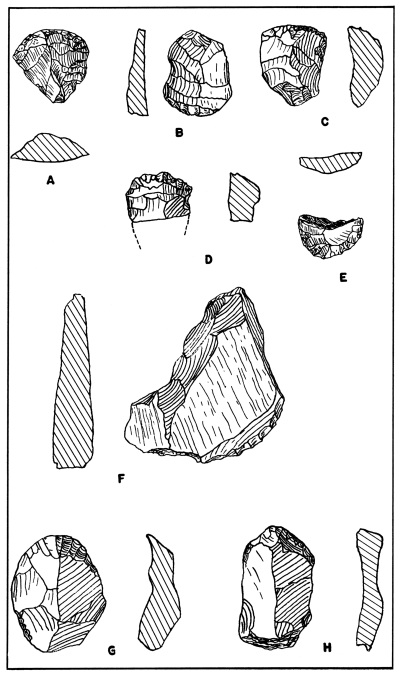
Figure 32—
End scrapers, type one. A-E snub-nosed.
Actual size.
[Pg 45]
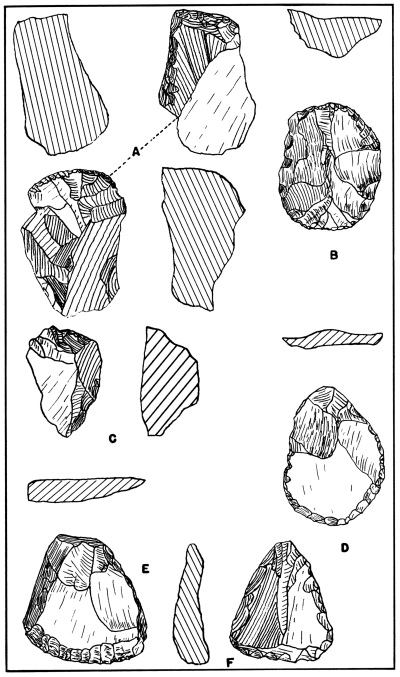
Figure 33—
End scrapers. A-C, type three. D-F, type two.
Actual size.
[Pg 46]
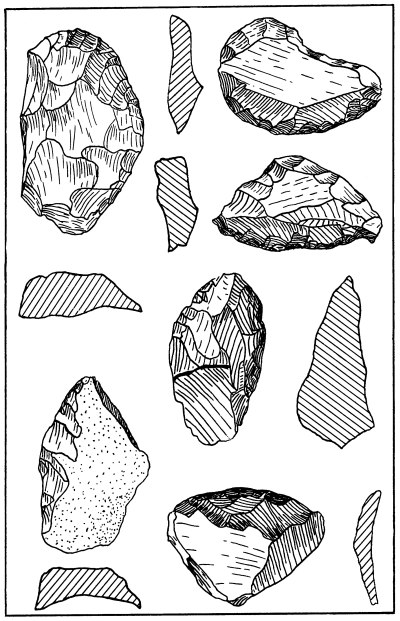
Figure 34— Side scrapers. Actual size.
[Pg 47]
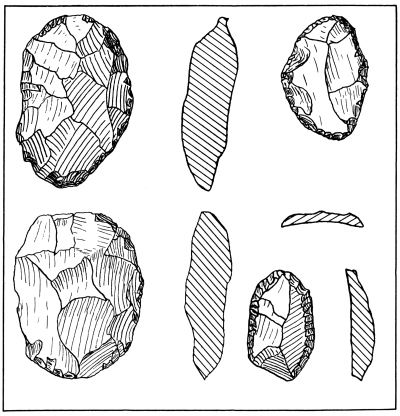
Figure 35— Discoidal scrapers. Actual size.
[Pg 48]
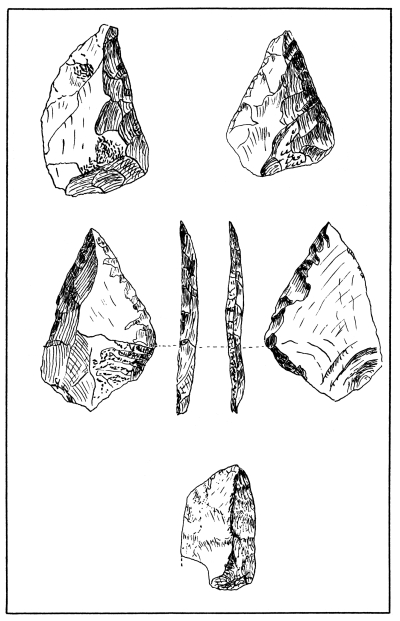
Figure 36— Uncompahgre scrapers. Actual size.
[Pg 49]
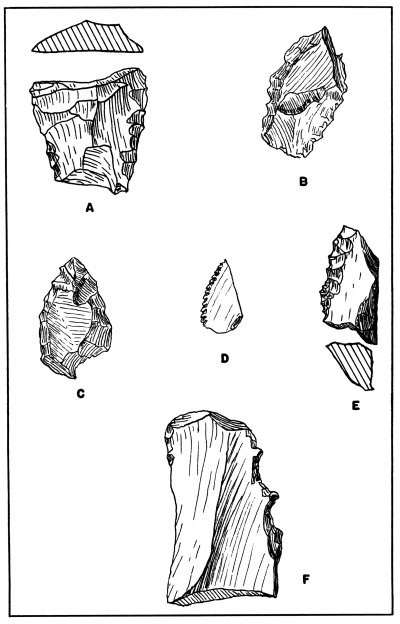
Figure 37—
A-E, serrated scrapers. F, spoke-shave.
Actual size.
[Pg 50]
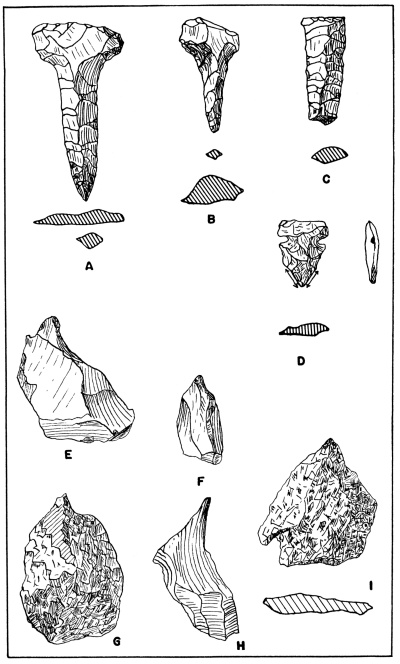
Figure 38—
A-D, drill types one-four. E-I, gravers.
Actual size.
[Pg 51]
Twenty-one specimens are considered to have been used as awls or perforators. Though individual form varies greatly, most are made on plano-convex or concavo-convex flakes. Flaking is concentrated on the short point, though it sometimes extends further on one or both faces. Occasionally, one or more of the edges have seen secondary use as a scraper. Of the total, nine specimens are of flinty material, one of obsidian. The remainder are quartzite (8) or quartz (3). They range in length from ¾ to 2½ inches, and from ½ to 1½ inches in width.
The term “graver” is not especially desirable since 1) it implies function, and 2) it is generally applied to a special form associated with the Upper Paleolithic of Europe. Nevertheless, the term is also used in connection with sharp-pointed flakes employed in making incisions, and as such is well entrenched in the literature. These tools were divided into two categories. The first contains 16 specimens. These were all made from irregular flakes, the largest 1⅜ × 1⅛ the smallest ¾ × ½. There are one or more points on each. Usually the point shows evidence of usage on one or two sides only. Some show scars all around. The second class, comprising 14 specimens, is distinguished by the fact that all are made from prismatic flakes (see below). Usually there is only one point on each. Despite their diminutive size (the largest 1½ × ⅝ inch, smallest, ¾ × ¼), tests made by the authors involving cutting bone, showed even the smallest to be an efficient tool.
Most of these artifacts are of the flinty variety of quartz, often fossilized wood.
Of the total number of flakes recovered certain appeared technologically distinctive and were classified as prismatic. The primary characteristics of these are a length exceeding twice the width, a striking platform at one end with a small bulb of percussion and ripple marks radiating from it. In addition, most of these exhibit a longitudinal ridge or ridges formed by facets intersecting at a low angle, representing the intersection of former flake scars. Most of the striking platforms are plain, but about 30 percent show a series of tiny flake scars which may be evidence of preparation. They range in length from 2¼ to ⅝ inches and in width from ³/₁₆ to ¾ inches.
Sixty-two of these show signs of use. Thirty had apparently served as gravers (see above). Thirty-two show usage marks caused by cutting, and 14 of these had served secondarily as small scrapers. About 80 percent of the utilized prismatic flakes are of a flinty material. The remainder are of quartzite. Of the unmodified specimens, about 65 percent were of flinty quartz, 30 percent of quartzite, and 5 percent of quartz. [Pg 52]
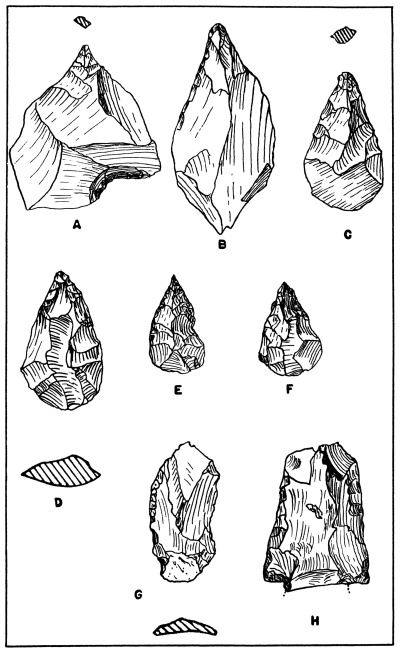
Figure 39—
A-F, perforators. G, flake knife. H, hafted knife.
Actual size.
[Pg 53]
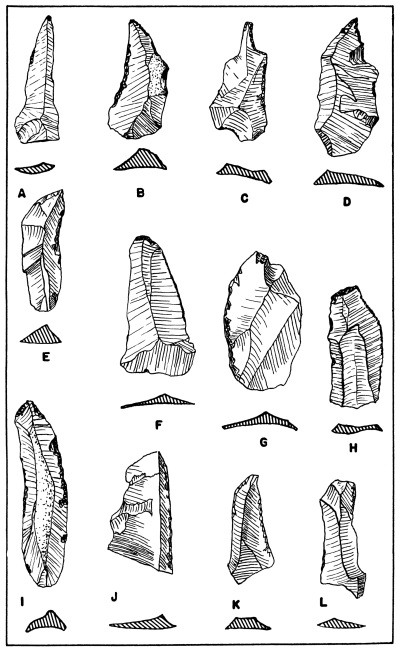
Figure 40—
Prismatic flakes. A-I, gravers. J-L, cutting edges.
Actual size.
[Pg 54]

Figure 41— Prismatic flakes, cutting implements. Actual size.
Forty-one implements are classified as choppers or hammerstones. Seventy percent of these are of rock quartz, 20 percent of a metamorphic rock, usually schist, and 10 percent of a grainy quartzite. Due to the nature of the material it is extremely difficult to determine whether such artifacts were used primarily as hammerstones or choppers. There are no small round heavily battered specimens which could be considered as hammerstones only. The pieces usually exhibit one sharp edge and one or more blunt battered edges. The first two lithic materials mentioned fracture rather easily, and the tools were probably used and discarded at will. Rock quartz and various metamorphic rocks are plentiful in the area, making such careless use practical; quartzite and flinty materials are rather scarce, (see below). The largest of these tools measures 5 × 5½ inches, the smallest 1¼ inches square. [Pg 55]
Only eight specimens are considered to have been cores. Three are of quartzite, three of agate and two of fossilized wood. The largest is about 3 × 3 × 2 inches, the smallest about a one inch cube. All are irregular, none fluted or prismatic. Since there were so few cores it is believed that the primary work of preparing flakes took place elsewhere, perhaps at the source of the material.
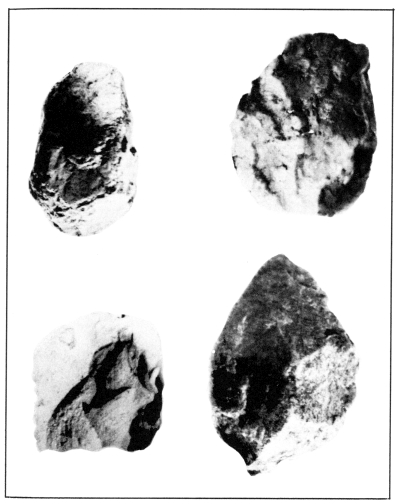
Figure 42— Choppers and hammerstones, ½ actual size.
[Pg 56]
Artifacts exclusive of projectile points and ground stone
| Unique Artifacts | 16-20 | 20-24 | 24-28 | 28-32 | 32-36 | 36-40 | 40-44 | 44-48 | 48-52 | 52-56 | 56-60 | 60-64 |
|---|---|---|---|---|---|---|---|---|---|---|---|---|
| Knives, leaf-shaped | 1 | 2 | 1 | 2 | 3 | 1 | 1 | |||||
| triangular | 2 | 1 | 1 | 4 | ||||||||
| flake | 1 | 2 | 2 | |||||||||
| Scrapers, end | 3 | 5 | 4 | 9 | 6 | 5 | 7 | 8 | 3 | |||
| side | 1 | 1 | 1 | 1 | 4 | 4 | 2 | 3 | 1 | |||
| discoidal | 1 | 5 | 3 | 1 | 2 | 3 | 2 | 4 | ||||
| serrated | 1 | 4 | 4 | 1 | 3 | |||||||
| “Uncompahgre” | 2 | |||||||||||
| Spoke-shaves | 1 | 1 | ||||||||||
| Projectile point | ||||||||||||
| drills | ||||||||||||
| expanded base | 2 | 1 | ||||||||||
| straight shafted | ||||||||||||
| Perforators | 1 | 2 | 2 | 6 | 2 | 1 | 2 | |||||
| Prismatic flakes, | ||||||||||||
| unmodified | 1 | 4 | 8 | 5 | 6 | 3 | ||||||
| cutting | 1 | 2 | 3 | 2 | 6 | 2 | ||||||
| engraving | 1 | 1 | 2 | 1 | 2 | |||||||
| Gravers, others | ||||||||||||
| Small ovoid bifaces | 1 | 1 | 1 | 3 | 7 | 5 | 5 | 1 | 4 | 3 | ||
| Utilized flakes | 1 | 1 | 5 | 4 | 8 | 9 | 10 | 9 | 11 | 10 | 14 | 1; |
| Chopper/hammerstones | 1 | 2 | 2 | 4 | 3 | 3 | 5 | 6 | 1 | |||
| Cores | 2 | 1 | 2 | 1 | ||||||||
| Small stone ornaments or gaming pieces |
2 | 1 | ||||||||||
| Paint stones | 1 | 1 | 1 | |||||||||
| Bone awls, splinter | 1 | 1 | 1 | 3 | ||||||||
| with head | 1 | 1 | ||||||||||
| sliver | 1 | 1 | 1 | 1 | 2 | |||||||
| undetermined | 1 | 1 | 1 | 1 | 1 | 2 | ||||||
| Rib/scapula knives | 1 | 1 | 1 | |||||||||
| Used bone splinters | 1 | 1 | 1 | |||||||||
| Flakers, antler | 1 | 1 | 1 | |||||||||
| bone | 1 | |||||||||||
| Gaming pieces | 1 | 2 | 1 | 1 | ||||||||
| Beads, tubular | 1 | 1 | 1 | 4 | 2 | 2 | ||||||
| Ornaments, tooth | 1 | |||||||||||
| bone | 1 | 1 | ||||||||||
| Mica, worked | 1 | 1 | 1 | |||||||||
| Leather fragments | 2 | |||||||||||
| Wood shafts | 1 | 1 | 1 | |||||||||
| Pottery, cordmarked, | ||||||||||||
| a | 2 | 2 | 3 | 7 | 8 | 10 | 6 | |||||
| b | 1 | 2 | 3 | 2 | ||||||||
| c | 2 | 1 | 1 | 2 | 1 | 2 | ||||||
| Plain | 1 | 1 | 1 | 3 | 2 | 1 | ||||||
| A | B | C | D | |||||||||
[Pg 57]
| Unique Artifacts | 64-68 | 68-72 | 72-76 | 76-80 | 80-84 | 84-88 | 88-92 | 92-96 | 96-100 | 100-104 | 104-108 |
|---|---|---|---|---|---|---|---|---|---|---|---|
| Knives leaf-shaped | 1 | ||||||||||
| triangular | 2 | 5 | 2 | 4 | 1 | 1 | 1 | 3 | 1 | 1 | |
| flake | 1 | 2 | 1 | ||||||||
| Scrapers, end | 7 | 2 | 1 | ? | ? | ? | |||||
| side | 2 | 2 | 1 | ||||||||
| discoidal | 2 | 1 | 1 | 1 | |||||||
| serrated | 1 | 3 | 3 | 1 | |||||||
| “Uncompahgre” | 3 | 2 | |||||||||
| Spoke-shaves | |||||||||||
| Projectile point | |||||||||||
| drills | 1 | ||||||||||
| expanded base | |||||||||||
| straight shafted | 1 | ||||||||||
| Perforators | 3 | 1 | 1 | 1 | 1 | ||||||
| Prismatic flakes, | |||||||||||
| unmodified | 6 | 1 | 1 | 1 | 1 | 1 | 1 | ||||
| cutting | 2 | 4 | 7 | 2 | |||||||
| engraving | 1 | 4 | |||||||||
| Gravers, others | |||||||||||
| Small ovoid bifaces | 9 | 1 | |||||||||
| Utilized flakes | 9 | 6 | 6 | 5 | 2 | 1 | 1 | 1 | 1 | ||
| Chopper/hammerstones | 2 | 1 | 2 | 1 | 2 | 1 | |||||
| Cores | 4 | 1 | |||||||||
| Small stone ornaments or gaming pieces |
|||||||||||
| Paint stones | 1 | 3 | 1 | 1 | |||||||
| Bone awls, splinter | 1 | 1 | 1 | 1 | 1 | ||||||
| with head | 2 | 1 | |||||||||
| sliver | |||||||||||
| undetermined | 1 | 1 | 1 | 1 | |||||||
| Rib/scapula knives | |||||||||||
| Used bone splinters | 1 | 1 | |||||||||
| Flakers, antler | 1 | ||||||||||
| bone | |||||||||||
| Gaming pieces | 1 | ||||||||||
| Beads, tubular | 1 | 1 | 1 | ||||||||
| Ornaments, tooth | 1 | ||||||||||
| bone | |||||||||||
| Mica, worked | 1 | 2 | |||||||||
| Leather fragments | |||||||||||
| Wood shafts | 1 | 1 | |||||||||
| Pottery, cordmarked, | |||||||||||
| a | ?1 | ||||||||||
| b | |||||||||||
| c | ?1 | ||||||||||
| Plain | |||||||||||
| E | F | G | H | ||||||||
[Pg 58]
Characteristics of grinding stones at LoDaisKa are largely summarized in Tables III and IV. These are presented in the hope that future studies will make it possible to distinguish cultural associations from such tools, although as Haury (1950) and Jennings (1957) reiterated, metates or grinding stones are often so nondescript as to defy cultural interpretation. Dealing for the most part with complete examples, there seem to be two general types: large worn boulders, and flat slabs often with a slight depression. The former are usually of an igneous material. Either type may be intentionally shaped. Most were more or less rectangular. The largest of the first type weighs about 120 pounds, and is 2 feet 3 inches long × 14 inches wide. The smallest is 11 inches × 12 inches and weighs about 20 pounds. Of the second type the maximum is 1½ feet × 14 inches, the minimum 10 inches × 12 inches. Shaping, when present, is confined to percussion and smoothing around the edges. Pecking probably served to roughen the surface.
A number of specimens in the ½ to ¾ inch thick class were made of hard fine sandstone. On some of the large fragments both faces appear parallel with no concavity. Only one fairly complete example of this type was found. This (Fig. 45) is a roughly triangular section about 5 inches on a side. It was found in Hearth B. It shows no basin and is very smooth. Two sides appear to have been the original edges of the complete specimen. These are roughly shaped. The smoothing extends all the way to these edges. There is ethnological evidence, (see below Lowie, 1924; R. M. Underhill, p.c.) that stones similar to this specimen were used for cooking stones. Since most of the artifacts of this type are small pieces, it would be hard to distinguish definitely between a small section of a cooking stone and a section of a slab metate. Lacking further proof, these have been treated as grinding stones, with this possible reservation.
One hundred and four specimens are classed as handstones or handstone fragments. Of these 50 could not be classified further except that 40 were of igneous rock and 10 of sandstone. The general data pertaining to handstones is summarized in the chart. The largest of these is 8 × 4 inches, the smallest 4 × 3 inches. All appear to have been used in one hand. Seventy-five percent are made of igneous rock, usually of a metamorphic type such as schist. This choice was probably due to the scarcity of good sandstone in the area. There are two basic types, those used on one and those used on two sides. For both these groups there is a variant which has a center ridge formed by the meeting of two grinding surfaces on each face. Probably the simple motion of pushing forth, rocking, and then pulling back caused this. One of these has the ridges on its two sides at right angles to each other. Some specimens are pecked. These forms seem to lack distributional significance.
[Pg 59]
Grinding Slabs, Complete Specimens
| Igneous | Sandstone | |||
|---|---|---|---|---|
| Flat Boulder |
Shaped | Slab | Shaped | |
| 24 | ||||
| 28 | ||||
| 32 | ||||
| 36 | ||||
| 40 | ||||
| 44 | ||||
| 1 | 48 | |||
| 52 | ||||
| 56 | ||||
| 60 | ||||
| 3 | 1 | 1 | 64 | |
| 1 | 1 | 1 | 68 | |
| 3 | 1 | 1 | 72 | |
| 3 | 1 | 76 | ||
| 2 | 1 | 80 | ||
| 84 | ||||
| 88 | ||||
| 1 | 92 | |||
| 96 | ||||
| 100 | ||||
| 1 | 104 | |||
| 108 | ||||
| 112 | ||||
[Pg 60]
Grinding Slabs, Fragmentary Specimens
| Igneous | Sandstone | ||||||||||||||||||||||||
|---|---|---|---|---|---|---|---|---|---|---|---|---|---|---|---|---|---|---|---|---|---|---|---|---|---|
| Two Sides Used | One Side Used | Two Sides Used | One Side Used | ||||||||||||||||||||||
| Pecked | Pecked | Pecked | Pecked | ||||||||||||||||||||||
| Thickness in inches | |||||||||||||||||||||||||
| ½ - ¾ | ¾ - 1½ | 1½ - 3 |
½ - ¾ | ¾ - 1½ | 1½ - 3 |
½ - ¾ | ¾ - 1½ | 1½ - 3 |
½ - ¾ | ¾ - 1½ | 1½ - 3 |
½ - ¾ | ¾ - 1½ | 1½ - 3 |
½ - ¾ | ¾ - 1½ | 1½ - 3 |
½ - ¾ | ¾ - 1½ | 1½ - 3 |
½ - ¾ | ¾ - 1½ | 1½ - 3 |
||
| 20 | |||||||||||||||||||||||||
| 24 | |||||||||||||||||||||||||
| 1 | 2 | 1 | 1 | 1 | 28 | ||||||||||||||||||||
| 1 | 1 | 2 | 1 | 2 | 4 | 32 | |||||||||||||||||||
| 3 | 4 | 1 | 1 | 1 | 36 | ||||||||||||||||||||
| 2 | 3 | 5 | 1 | 2 | 1 | 1 | 1 | 1 | 40 | ||||||||||||||||
| 4 | 4 | 1 | 1 | 1 | 1 | 1 | 44 | ||||||||||||||||||
| 1 | 2 | 2 | 2 | 2 | 2 | 1 | 1 | 1 | 1 | 2 | 48 | ||||||||||||||
| 1 | 1 | 1 | 3 | 2 | 2 | 1 | 1 | 1 | 52 | ||||||||||||||||
| 1 | 2 | 3 | 3 | 2 | 3 | 1 | 56 | ||||||||||||||||||
| 2 | 3 | 3 | 3 | 2 | 1 | 1 | 1 | 1 | 3 | 60 | |||||||||||||||
| 1 | 1 | 1 | 4 | 1 | 3 | 1 | 1 | 64 | |||||||||||||||||
| 4 | 2 | 2 | 5 | 2 | 1 | 1 | 2 | 2 | 68 | ||||||||||||||||
| 1 | 2 | 2 | 72 | ||||||||||||||||||||||
| 1 | 3 | 1 | 1 | 2 | 76 | ||||||||||||||||||||
| 1 | 4 | 2 | 2 | 2 | 80 | ||||||||||||||||||||
| 1 | 1 | 1 | 2 | 1 | 1 | 84 | |||||||||||||||||||
| 2 | 1 | 88 | |||||||||||||||||||||||
| 2 | 3 | 1 | 92 | ||||||||||||||||||||||
| 1 | 96 | ||||||||||||||||||||||||
| 1 | 1 | 100 | |||||||||||||||||||||||
| 1 | 1 | 104 | |||||||||||||||||||||||
| 108 | |||||||||||||||||||||||||
| 112 | |||||||||||||||||||||||||
| 116 | |||||||||||||||||||||||||
[Pg 61]
Handstones
| Igneous | Sandstone | ||||||||||||
|---|---|---|---|---|---|---|---|---|---|---|---|---|---|
| Biface | Uniface | Biface | Uniface | ||||||||||
| Four Plane |
Four Plane |
Four Plane Pecked |
|||||||||||
| Pecked | Pecked | Pecked | Pecked | ||||||||||
| 28 | |||||||||||||
| 32 | |||||||||||||
| 36 | |||||||||||||
| 1 | 1 | 1 | 40 | ||||||||||
| 2 | 44 | ||||||||||||
| 48 | |||||||||||||
| 6 | 1 | 3 | 52 | ||||||||||
| 2 | 2 | 56 | |||||||||||
| 1 | 2 | 2 | 1 | 1 | 2 | 60 | |||||||
| 1 | 1 | 64 | |||||||||||
| 1 | 1 | 4 | 68 | ||||||||||
| 1 | 1 | 1 | 72 | ||||||||||
| 76 | |||||||||||||
| 1 | 80 | ||||||||||||
| 1 | 84 | ||||||||||||
| 2 | 2 | 88 | |||||||||||
| 1 | 2 | 92 | |||||||||||
| 1 | 96 | ||||||||||||
| 1 | 100 | ||||||||||||
| 104 | |||||||||||||
| 108 | |||||||||||||
| 1 | 112 | ||||||||||||
[Pg 62]
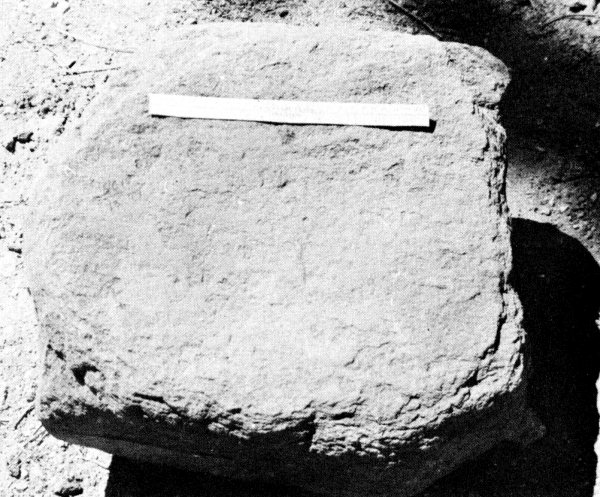
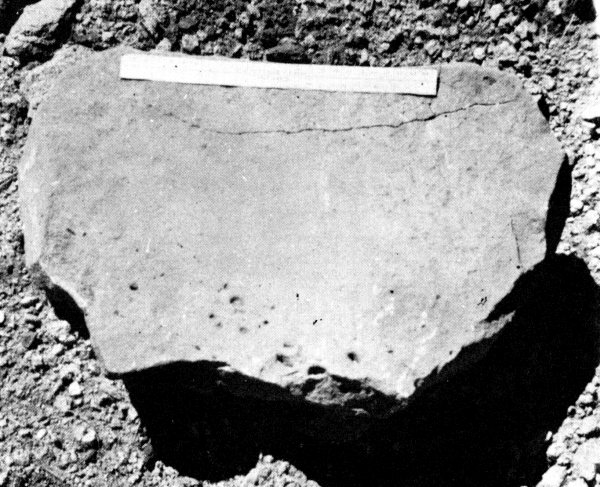
Figure 43—
Large milling stones.
Above, granite. Below, sandstone.
[Pg 63]
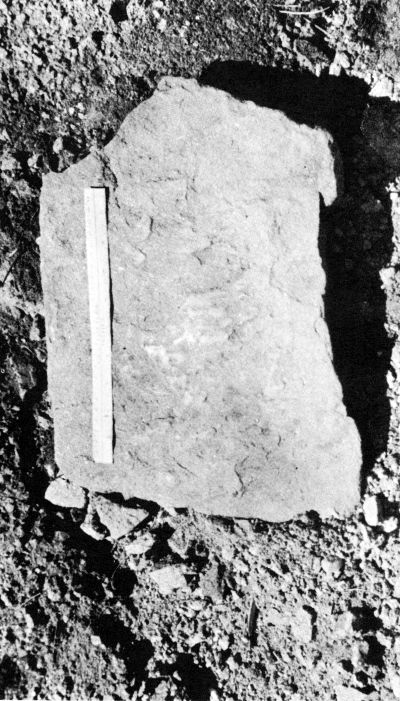
Figure 44— Flat granite milling stone.
[Pg 64]
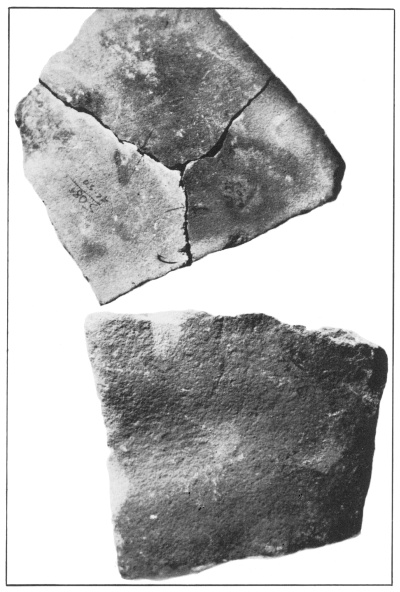
Figure 45—
Sandstone milling slabs, ½ actual size.
Above, flat without depression. 1 inch thick.
Below, with depression.
[Pg 65]
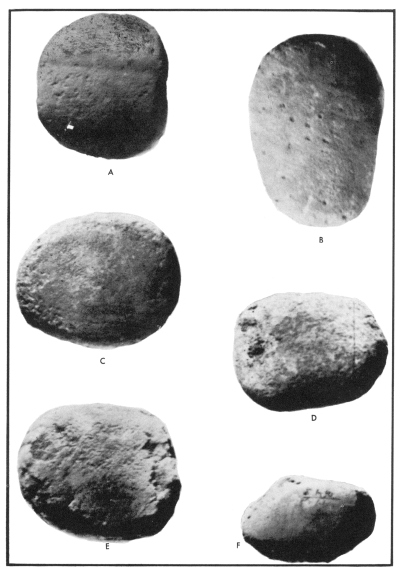
Figure 46— Handstones. A-B, four-plane. ½ actual size.
[Pg 66]
One shaft-smoother was found, with lengthwise grooves on both faces. The lower is very shallow; the upper is clearly formed, and measures ³/₁₆-⁴/₁₆ inches wide and ⅛ inch deep (see Fig. 47).
Eleven objects are classified as pigment stones. Four are lumps of red ochre. There is no proof that they were used for paint, but as Coon (1950) has noted, the use of some sort of paint is practically universal among primitive people. The largest weighs about three ounces, the smallest about two. Three pieces of yellow ochre were found. One is a great lump weighing about two pounds. The other two are flat ground palettes, slightly irregular, one about 1 × 2, the other 3 × 4 inches and both about ¼ inch thick.
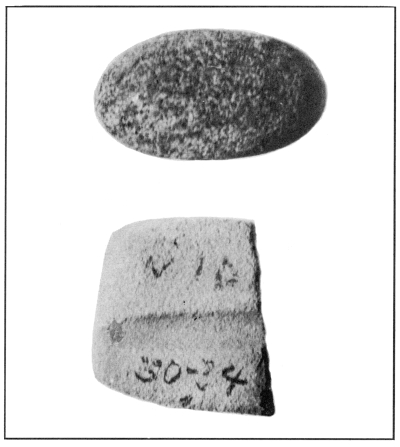
Figure 47—
Above, “Atlatl weight”. Below, abrader.
Actual size.
[Pg 67]
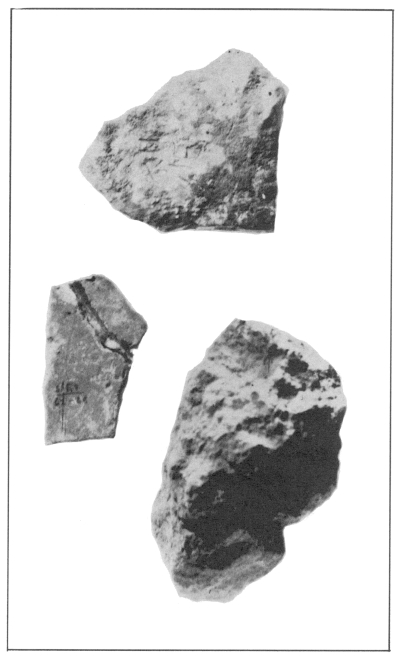
Figure 48— Pigment stones, ½ actual size.
[Pg 68]
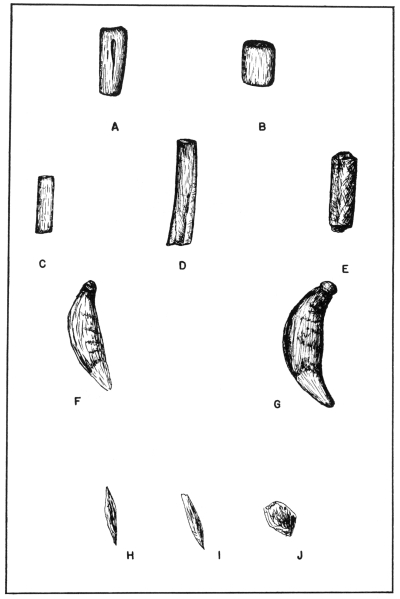
Figure 49— A-G, Beads. H-J, Awls type four.
[Pg 69]
There are numerous tubular beads of bird and small mammal bones. These range in length from 1⅜ inches to ½ inch; most are of the shorter variety. Apparently the bone was polished and prepared, then a groove or series of grooves was cut, the sections broken out, and the ends smoothed.
Two lower canine teeth, (one of badger, taxidea, the other unidentified), were evidently used as ornaments. Both show a lustrous polish. At the end of the root a small groove, or series of parallel incisions, was cut out for suspension. One is ¼ inch, the other 1 inch in length. A small (1 inch × ½ inch) piece of bone (Fig. 51, top left) with a groove cut at the top may have been used as a pendant.
There are ten other fragments of bone which show use. The largest of these measures 4¼ × ¾ inches, the smallest, 3¼ × ⅝ inches. One or more edges are worn, suggesting use as a scraper or cutting edge. Bones of large animals, probably long bones, appear to be represented. On most, the working edge is concave, although on a few it is flat.
One bone is similar to those described above but has a series of notches along one edge. It is 4 inches long and ⅝ inches wide.
There are nine rib and one scapula fragment that show wear along a sharp edge. These appear to have been used as cutting implements. Some are polished along the flat face, perhaps from use in some kind of smoothing. Many Southwestern tribes, e.g. the Papago, use similar tools to remove hair from fresh hides. It is difficult to know whether these represent complete tools or fragments. The largest is 7 inches long, the smallest 2½ inches long. The identifiable specimens are of bison or mule deer (Odocoileus hemionus).
Seven specimens of worked bone are thought to have been used as gaming pieces. For three of these, this designation is relatively certain. These are small flat oblong objects with a series of parallel striations on the edges of one face. In addition, two have a line of indentations running up the center. These depressions were probably drilled (see Fig. 52). [Pg 70]

Figure 50— Rib-scapula cutting implements. ¾ actual size.
[Pg 71]
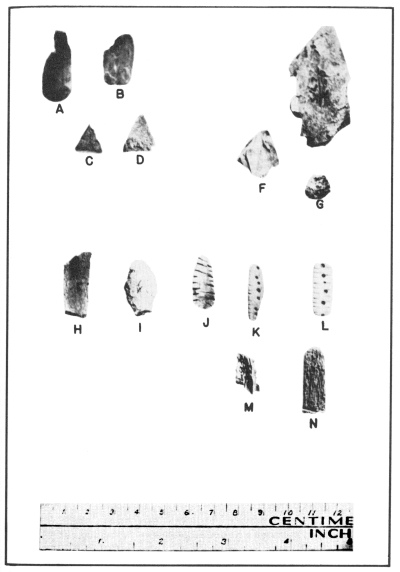
Figure 51—
A-D, problematical pieces.
E-G, worked mica. H-N, gaming pieces.
[Pg 72] A fourth piece appears to be an unfinished example, and provides some data on the method of manufacture. Apparently, the length of bone (rib?) to be utilized was cut to the desired width and partially smoothed; the ends were rounded and also partially finished; then several sections of the length of the proposed gaming piece were cut off by grooving and fracturing. The piece was then smoothed to the proper shape, the striations cut, and the indentations drilled.
The other three specimens included here are somewhat problematical. One approximates the shape of the unfinished gaming piece. The second is a piece of skull cap, (species unidentified) of the same general shape as the above; two of the sides are formed by suture lines, the ends by polishing. The third fragment is in the same size range and has serrated edges. The dimensions of the gaming pieces can be seen in Fig. 51.
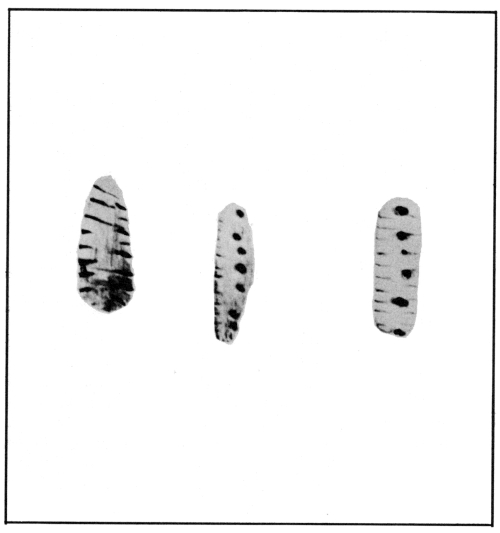
Figure 52— Gaming pieces, 2× actual size.
[Pg 73]
Forty-one specimens, fragmentary and complete, were classified as awls. These were segregated into four principal types, classified on the basis of form, type of bone utilized, size, and extent of polish. The most numerous type are those which retained the head or epiphesis of the bone (see Kidder, 1932). It is probable that two subtypes of this category may be recognized on the basis of size and extent of polish. The first comprises one complete and seven broken specimens (see Fig. 53). The former is a long slender implement of deer metatarsal, tapering to a fine point with a circular-section. It is 8⅜ inches in length and ¾ inches in its greatest diameter. Polish extends the full length and circumference, and the “head” has been altered by four intersecting V-shaped grooves, forming a cross. The remaining seven include two with the head intact, and five points and midsections classified with the above because of the overall workmanship. The most complete measures 6¼ inches in length without the head. Technologically this group is marked by primary abrasion parallel to the long axis and secondary work at right angles to it. There are numerous instances of the transverse cutting across the longitudinal striae, suggesting that the former was the finishing process. Though positive identification is in several instances impossible, most appear to have been made from deer metatarsals. All except one were located below 84 inches. The exception is of interest. It is a specimen about three inches long, subjected to calcination and subsequent patination all over, except for a section midway along its length that retains its natural color. It seems possible that this area had been bound with leather or some foreign substance which affected the weathering of the specimen.
The second subdivision of the type retaining the head is characterized by a greater width relative to length, and the more restricted extent of polish. The three complete specimens range from 3⅞ to 5¼ inches in length, and up to 1⅛ inches in greatest diameter. Polish extends only a short distance beyond the point, which has an oval flattened cross-section. All abrasion scratches are parallel to the short axis. These were manufactured respectively from a bison rib, a metapodial and metatarsal of mule deer (Odocoileus hemionus).
The second major type is that of “splinter awls”; it also may be subdivided. The first subdivision consists of 5 splinters of large mammal bone, sharpened at one end. Complete pieces range from 3½ to 4⅜ inches in length and from ⅜ to ¾ inches in greatest width. The second group of six pieces is similar, but the working end is rounded and flattened rather than sharp. They range from 2⅞ inches to 3½ inches long and from ⅜ to 1 inch in width. Abrasion in both groups was at a high angle to the long axis, and in some cases produced a faceted appearance. [Pg 74]
The third type comprises three awls made of small mammal bones, two retaining the heads, the third without. These exhibit sharpened points. The longest is 4 inches, the smallest, one inch long.
The final type comprises five very small splinters of bone from ⅝ to one inch in length. One is of bird bone, the others of small mammal bones. Each is sharpened on one end, blunted or rounded on the other. It is possible that these were hafted. Their size and shape makes it unlikely that they could have been employed in the hand alone.
There was undoubtedly some difference in the use of these different types of tools. Perhaps the longer finer ones were employed in the manufacture of basketry, while the sharpened splinters served best as hide perforators.
There is one fragmentary bone about 7 inches long, that was evidently left over from the production of a splinter awl. It illustrates the technique of bone cutting that was probably employed for producing tools. A groove about ¹/₁₆ of an inch deep was cut encircling the bone, and it was shaped into two pieces. Apparently some preliminary smoothing had already been done, as suggested by additional scoring marks. The authors tested various tools to determine which might be most efficient in cutting such a groove. Flat sharp flakes or knives could be used, but usually not enough pressure could be brought to bear without breaking the tool. However, certain implements, called “gravers” in this paper, were rather well adapted for such work. The tool could be used as a plane for cutting. The two techniques mentioned, in fact, could be compared to the cutting of wood with a knife and with a saw whose teeth act as a multiple plane.
A problematical artifact is the base of an elk (Cervus canadensis) antler shown in Fig. 55. The working end of this is a tapering blade which ends in a flat chisel-like tool about ¾ inch broad.
There are four fragments of horn that appear to have been flakers. Two are pointed implements 1¼ inches long, two are fragments that lack tips. These are about 3½ inches long. All are of deer antler (Odocoileus hemionus), and show various gouges and worn places.
One bone 7¼ inches long also appears to have been used as a flaker. The blunt point has been shaped, but other modification seems to have been unintentional and consists of irregular worn and scored areas. Distribution of this scoring suggests that the tool was used in the left hand. [Pg 75]
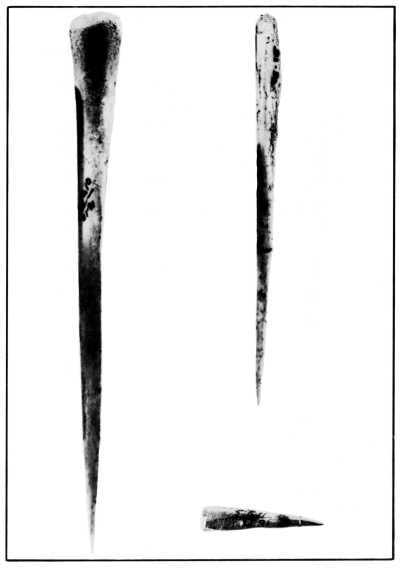
Figure 53— Awls, type one, ¾ actual size.
[Pg 76]
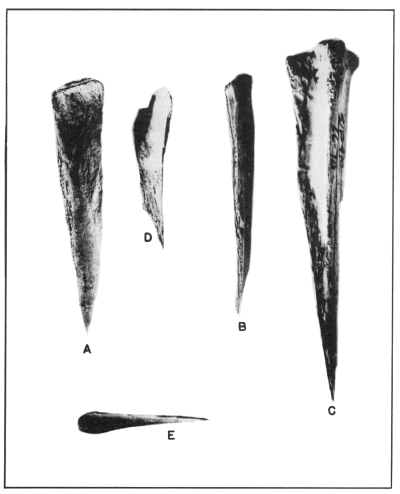
Figure 54—
Awls, A-C, type one. D, type two. E, type three,
⅔ actual size.
[Pg 77]
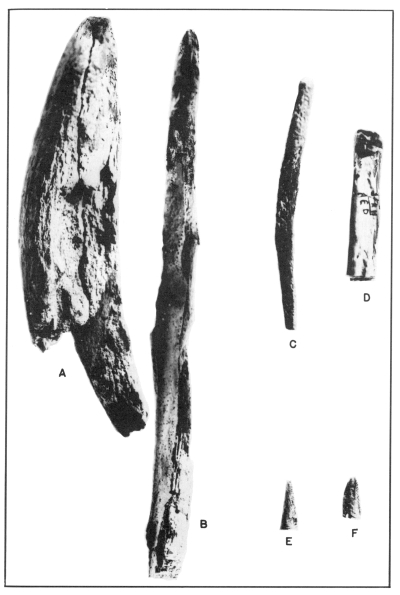
Figure 55—
A, elk antler tool. B, long bone flaker.
C, antler flaker. D, cut bone. E-F, antler flaker points.
½ actual size.
[Pg 78]
MISCELLANEOUS ARTIFACTS
There are four stones of problematical use. Three of these have the form of an isosceles triangle. The two smallest measure about ½ inch on a side. Perhaps these were gaming counters or ornaments. The larger piece is about 1¾ inch on a side with one broken corner, and has 2 small notches on either side of the apex. This was very probably a pendant. The fourth specimen in this class is more or less oval, very thin, with ground edges. It is about 1½ inches long and may have been an ornament or gaming counter. The first two pieces are of sandstone, the third of limestone, and the last of feldspar.
An ovoid piece of granite measures 2⅛ × 1¼ inches, and appears to have been ground into its present shape. It has a smoothed flattened area on one side, and may well have been an atlatl weight. This cannot be proven since there are no further indications, such as a groove. However, there are similar ungrooved stones in place on atlatl throwers from the Southwest, in the Peabody Museum collections, which the authors have examined.
There are six fragments of mica that apparently were shaped for some reason. Four of these were cut into figures more or less like arrow points. The largest is 2 × 1 inch, the smallest complete piece, ¾ × ¾ inch. They may have had ceremonial significance. A fifth specimen is square, ¾ × ½ inch in width and length; and the sixth more or less round, about ½ inch in diameter. There were other pieces of mica found at the site, but these were unshaped.
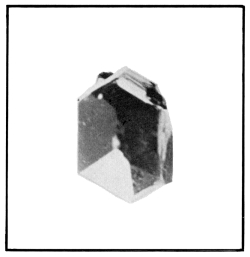
Figure 56—
Quartz crystal.
Actual size.
[Pg 79]
A well formed quartz crystal was found; it is topaz in color and about an inch square in cross-section. Such crystals have an extensive history in some Archaic sites, such as those in California. They probably had some ceremonial purpose perhaps as a part of a shaman’s paraphernalia.
A small round ball of clay about 1¼ inches in diameter was recovered. Around the circumference is a raised ridge such as would have been produced if the clay had filled a skin sack with the seams on the outside. If such were the case it might have served as a bolas weight.
There are several fragments of wood that appear to have been modified by the inhabitants. Two of these could easily have been pieces of arrow shafts. One is ³/₁₆ inch in diameter, 2½ inches long; the other ¼ inch in diameter, and 1¾ inches long. Both show no remnants of bark and appear to have been scraped smooth. There are two similar specimens, 1 and 2 inches long, and ⁵/₁₆ and ⁷/₁₆ inch in diameter respectively. Observations of ethnological materials suggest that these were too large and heavy to shoot with an ordinary bow and arrow. Perhaps these are fragments of atlatl foreshafts. The fifth specimen is also ⁷/₁₆ inch in diameter, 2¼ inches long, and is pointed. It was probably the butt end of a foreshaft. Ethnologic parallels indicate that it was too sharp to be the point of a firedrill (see Fig. 58).
A sixth wood specimen is a flat piece 3½ × ³/₁₆ inches in maximum dimensions. Its use is unknown.
A seventh specimen is a short piece 2 inches long, shaped all around, and tapering to a point at one end. It was cut from a tree gnarl, and probably served as an awl.
There are two small pieces of leather. One is probably part of a thong or cord; the use of the other is unknown.
A piece of twisted fiber was found. It appears to have been one strand of a multi-strand cord. The fiber is made from yucca leaves.
[Pg 80]
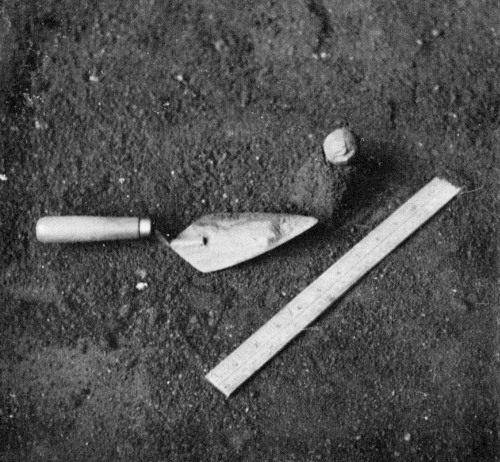
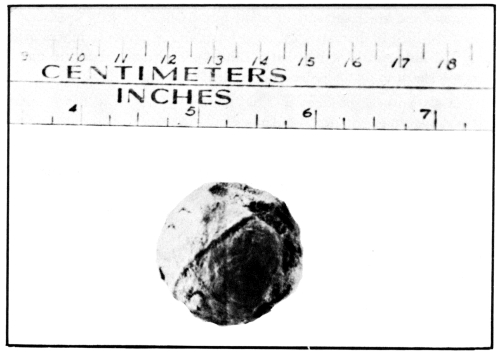
Figure 57—
Clay ball. Above, in situ.
Below, note raised central ridge.
[Pg 81]

Figure 58—
Wood fragments. A-D, arrowshaft fragments(?)
E, butt end of dart foreshaft. F, dart shaft fragments(?)
Actual size.
[Pg 82]
Plain pottery includes one restorable bowl and eight additional sherds. Construction is hard to determine from so small a number of sherds, but indications suggest coiling and scraping. Coils were fairly wide (see Fig. 60). Core color is usually grey to black though one sherd is oxidized to a brick red. Firing was done in a “reducing atmosphere”, with some scattered spots oxidized. The temper is angular with occasional mica fragments visible; it is probably crushed granite. Some sherds may contain a small amount of quartz sand. The size of the temper is variable, usually fine with a few large granules mixed in. Vessel walls are usually fairly strong. The pottery is friable, not flaky. Both surfaces are unslipped, and smoothed on all specimens. The exterior is a brownish black, the interior is black. One sherd, however, is dull grey. Thickness is from ¼-⁵/₁₆ inch, one sherd ³/₁₆ inch. The only partially complete form observed is a bowl. However, another large sherd (about 8 inches square) suggests part of the wall of a pot, perhaps with an incurving shoulder. The bowl has a mouth diameter of 5½ inches, and in vertical cross-section resembles a parabolic curve 3¼ inches high. Rims in general are gradually tapered.
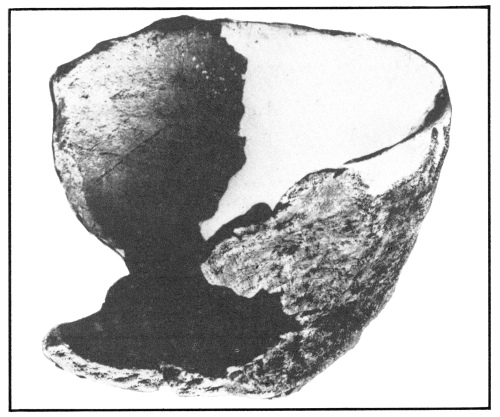
Figure 59—
Plain pottery bowl.
White portions restored,
⅔ actual size.
[Pg 83]
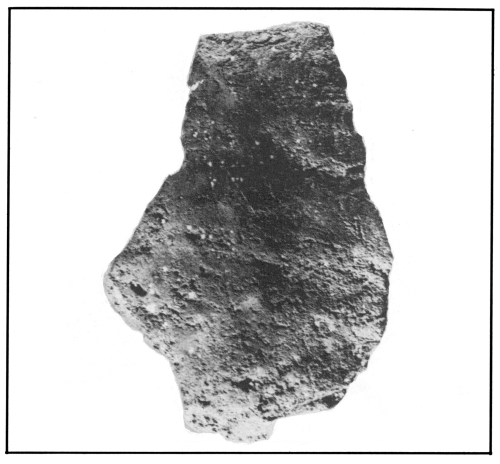
Figure 60—
Plain pottery sherd, showing coiled construction.
Actual size.
Pottery in this category is divided into three classes. Pottery of Class I includes 7 sherds. These were manufactured by the paddle and anvil technique. Temper is sand, and is not too abundant. The clay is micaceous and the texture somewhat granular, tending to shatter along fairly regular lines. Hardness is 3.5-4.5; color grey to brownish continuous all the way through. Exterior surfaces all show parallel lines of cord-marks, about five to the inch. Impressions of individual strands can be seen in the clay, somewhat flattened and slightly smoothed. Interior surfaces were smoothed and scraped. One rim sherd has diagonal impressions that extend to ¼ inch of the flattened lip. There is no decoration. Vessel size cannot be determined. Thickness is from ⁵/₁₆-⁶/₁₆ inch. One sherd from near the base suggests a conoidal bottom.
Two sherds of this class have different exterior treatment. One of these appears to have been impressed by basketry, apparently coiled with a simple rod foundation. The other has been impressed with an unknown fabric. [Pg 84]
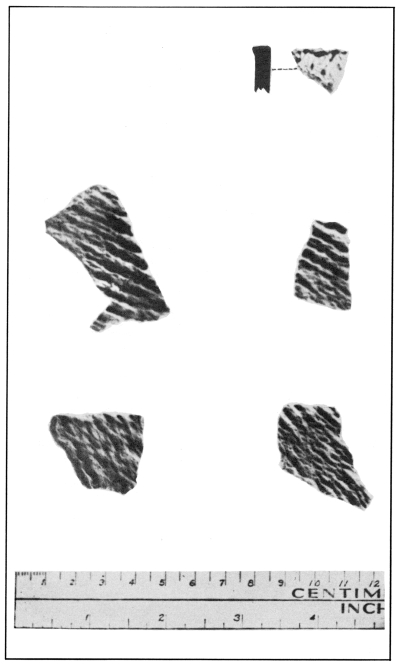
Figure 61— Surface roughened pottery, Class I.
[Pg 85] Class II includes 15 sherds. These resemble those of I in many respects: The manufacture was by paddle and anvil; the temper is of sand or possibly crushed rock, generally fine and not too abundant, and the clay is micaceous. The texture, however, is flaky with a tendency to fracture along irregular lines. Hardness is about 3.5, color grey to brown generally continuous through the sherd. A few have blacker cores. Exterior surfaces were treated with parallel lines of cord impressions 10-15 to the inch with very little smoothing. Interiors were smoothed, but do not show the evidences of scraping as with I. There is one rim sherd; vertical impressions on this extend over the lip which has been flattened. No decoration occurs. The thickness ranges from ³/₁₆-⁴/₁₆ inch. One large sherd about 4 × 3 inches suggests vessels of considerable size.
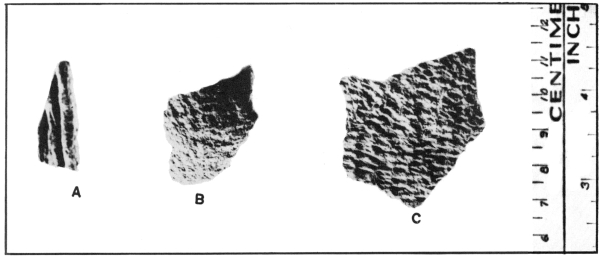
Figure 62— Surface roughened pottery, A, Class I. B and C, Class I variant.
Pottery of Class III in most aspects resembles that of Class II: paddle and anvil technique in manufacture, temper of sand or crushed rock, fine, not abundant, micaceous clay. The texture is very flaky tending to fracture along irregular lines. Color grey to brown, usually the latter, generally continuous through the sherd; some, however, have blacker cores. Exterior surfaces were treated with two sets of parallel cord marks one extending vertically from the rim, the other at an angle of about 45 degrees. This gives a sort of criss-cross effect, different, however, from the random application of Upper Republican sherds (see Wedel 1934, Strong 1935). Interior surfaces were smoothed. On one large rimsherd cord marks extend over the flattened lip. No shoulder is in evidence, and indications suggest fairly large pots with mouth diameter of about 10 inches, height 12 inches. The camber of the sherds indicates forms with pointed bottoms. Thickness is from ³/₁₆-⁴/₁₆ inches. There is no decoration. Hardness is about 3.5. [Pg 86]
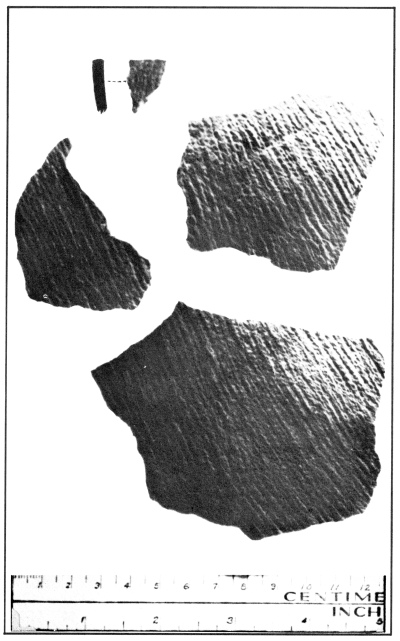
Figure 63— Surface roughened pottery, Class II.
[Pg 87]
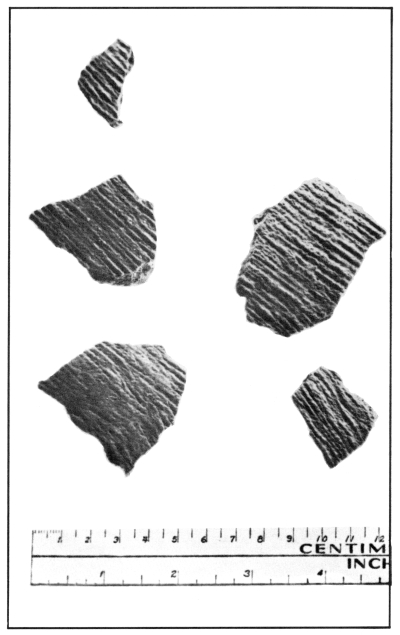
Figure 64— Surface roughened pottery, Class II.
[Pg 88]
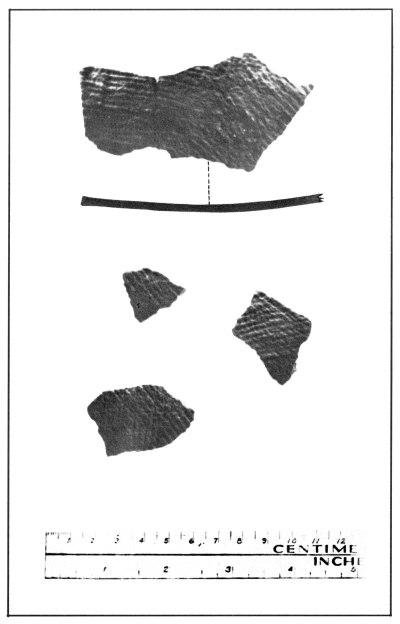
Figure 65— Surface roughened pottery, Class III.
[Pg 89]
By Chas. B. Hunt
The LoDaisKa (Sanger) Site, about a mile and half south of Morrison, Colorado, is a rockshelter under a projecting ledge of Paleozoic (Pennsylvanian) sandstone that dips steeply east. The pre-ceramic occupation layers at this site are believed to correlate with the Piney Creek alluvium (Hunt, 1954, p. 114). The accompanying map (Fig. 66) illustrates the general geologic setting of the site; it shows the general distribution of one upper Pleistocene and two Recent units.
The upper Pleistocene unit (Qg on the map) is a bouldery gravel with which is included some variegated, silty and clayey alluvium. This bouldery gravel is exposed in Strain Gulch upstream from the site, and it covers much of the upland northwest of that part of the Gulch. Downstream from the site this bouldery gravel is southeast of the Gulch and forms the high terrace extending from the site to the highway. Because the deposit is bouldery, and because the boulders are little weathered the deposit is assumed to be Wisconsin in age.
The alluvium with variegated colors mapped with this bouldery gravel is exposed in Strain Gulch about 700 feet northeast of the site, and in the tributary from the west that joins Strain Gulch about 200 feet upstream from the highway. In this latter tributary the alluvium rests on strata of Paleozoic age. At both localities the variegated alluvium is overlain by dark-colored, sandy and silty alluvium.
The variegated alluvium has a distinct, lime-enriched zone, probably representing the alluviated layer of an old soil from which the upper layers have been eroded. The lime-zone is comparable in thickness to that found in soils in Wisconsin age in the Denver area. Moreover, at the outcrop in Strain Gulch, the lower part of the alluvium is stained with iron oxide about the way deposits of Wisconsin age are stained in the Denver area. However, the dating of the deposits is uncertain because it has not been established whether the layers enriched in lime and iron are the result of surficial weathering or ground-water action.
Probably, though, these deposits are late Pleistocene in age, and fossils in them probably will include the Pleistocene forms. [Pg 90]
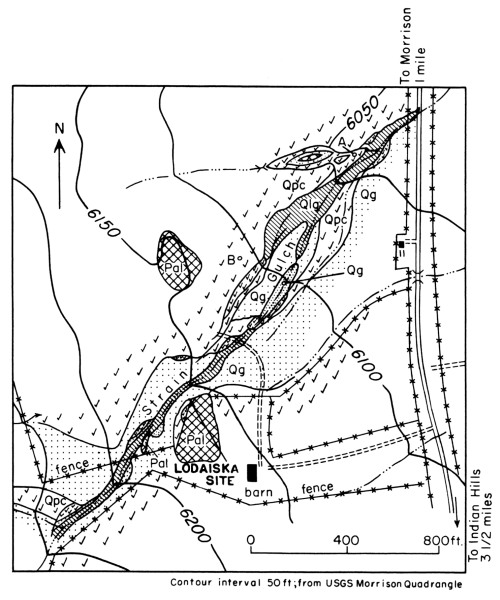
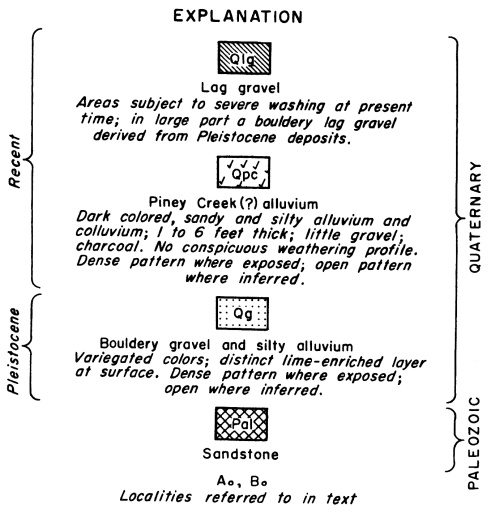
FIGURE 66—GEOLOGIC MAP OF LODAISKA SITE
[Pg 91] Overlying the bouldery gravel and the variegated alluvium is a dark-colored, sandy and silty alluvium (Qp on the map), 1 to 6 feet thick, that looks quite like the Piney Creek alluvium in the Denver area. Both the Piney Creek and this alluvium are of Recent age. Fossil bones were found in the alluvium at two places near the site (A and B on the map). At A, 1 foot below the surface, articulated bones were found; at B, a single bone was found and it was not in place, but from a plowed surface on the upland. At this locality a chert flake was found also. The bones were examined by Edward Lewis of the U. S. Geological Survey and C. B. Schultz and L. G. Tanner of the University of Nebraska State Museum and Geology Department. Their identifications are as follows:
Locality A, fragments of a vertebra, femur, epiphysis, and ribs of Bison bison (Linnaeus) of Recent age, and
Locality B, the badly weathered astragalus of a large bovid, either Bos Taurus or Bison bison (Linnaeus) of Recent age.
The unconformity at the base of the dark-colored alluvium is well exposed at the localities indicated on the map.
Fragments of charcoal were found in the alluvium 200 feet upstream from the site. This alluvium probably correlates with the pre-ceramic layers of the occupation levels at the site, which, as reported by Lewis in an accompanying paper, also contains vertebrate remains of Recent age.
The youngest deposit, a bouldery gravel confined to the present washes, is a lag concentrate of the boulders and cobbles that are left by washing out finer grained sediments from the Pleistocene deposits. This deposit, and the arroyo-cutting with which it is associated, probably developed throughout the period of the ceramic levels.
REFERENCE CITED
Hunt, Chas. B., 1954 Pleistocene and Recent deposits in the Denver area, Colorado: U. S. Geol. Survey Bull. 996-C, p. 91-140.
[Pg 92]
By Robert J. Rodden
Mechanical and chemical analyses of the deposits of the LoDaisKa Site were made in an attempt to establish whether or not any paleosols or ancient weathered zones were present. No clear profile development could be observed in the field and it was hoped that laboratory analysis might confirm this impression. The occurrence of such features might serve for correlation between sites in the area and aid in interpreting the paleoclimatic and geomorphic history of the deposits (Miller and Leopold, 1953).
Samples for laboratory analysis were collected from two different parts of the site. Those upon which most of the present conclusions are based were taken in continuous two-inch intervals down a vertical face in Square M11 (see Figs. 7 and 10), very near the back wall of the rockshelter. They were not collected until after much of the site had been excavated and it was only near the rear wall that a relatively complete section could be obtained. Rodents had disturbed the upper levels and only the profile from 38-102 inches below baseline was studied. Because the location of this sample might very well reflect the influence of the overhang on the particle size distribution of the deposits, another sample section was taken in front of the shelter. Stratigraphic relations and similarities in the archaeological materials suggested that the deposits extended essentially horizontally from the front to the back of the site, and that correlations for six-inch horizontal levels were generally warranted. The samples from Square J8 were collected in continuous six-inch intervals from a point 38 inches below baseline. The expected horizontal variation with respect to particle size distribution was, in fact, not borne out by the results of this second sampling. A comparison of the median diameter and sorting coefficients of the samples suggests that both samples are generally representative of the deposits and of variations within them (see Figs. 67, 68):
| Median diameter of 7 samples from | |
| the back of the shelter (M11) | 0.61-0.75mm. |
| Median diameter of 4 samples from | |
| the front of the site (J8) | 0.60-0.70mm. |
| Average sorting coefficients of | |
| 7 samples from M11 | 2.20 |
| (relatively well-sorted) | |
| Average sorting coefficients of | |
| 4 samples from J8 | 2.18 |
One would not expect that the results of the chemical analyses would be appreciably affected by the location of the sample. [Pg 93]
Particle-size fractions, in millimeters;
expressed in percent of
total weight of sample.
| 2.00 | 2.00 - 1.00 | 1.00 - 0.71 |
0.71 - 0.50 | 0.50 - 0.351 | 0.351 - 0.25 |
0.25 - 0.177 | 0.177 - 0.125 | 0.125 - 0.088 |
0.088 - 0.062 | 0.062 | |
|---|---|---|---|---|---|---|---|---|---|---|---|
| 38-40 | 12.46 | 20.50 | 11.79 | 10.28 | 8.97 | 10.17 | 5.65 | 5.45 | 4.46 | 3.19 | 5.78 |
| 40-42 | 9.67 | 18.18 | 11.67 | 11.63 | 9.17 | 11.67 | 6.59 | 6.03 | 4.99 | 3.26 | 6.18 |
| 42-44 | 9.61 | 19.22 | 12.69 | 11.49 | 9.43 | 10.75 | 5.99 | 5.68 | 4.57 | 3.18 | 5.99 |
| 44-46 | 5.22 | 16.99 | 12.08 | 11.78 | 9.81 | 12.14 | 6.86 | 6.82 | 5.52 | 4.04 | 7.18 |
| 46-48 | 11.59 | 19.56 | 12.12 | 11.34 | 9.11 | 10.72 | 5.64 | 5.15 | 4.18 | 2.84 | 5.79 |
| 48-50 | 11.60 | 20.28 | 12.37 | 11.93 | 9.76 | 10.89 | 5.63 | 5.15 | 2.89 | 2.62 | 5.15 |
| 50-52 | 8.28 | 19.70 | 11.84 | 11.84 | 10.16 | 11.91 | 6.45 | 6.13 | 4.75 | 3.26 | 4.84 |
| 52-54 | 11.42 | 20.22 | 11.91 | 10.96 | 9.14 | 11.08 | 6.09 | 5.58 | 4.67 | 3.15 | 5.12 |
| 54-56 | 14.33 | 20.44 | 11.84 | 11.23 | 8.65 | 10.45 | 5.61 | 5.23 | 4.14 | 2.77 | 4.19 |
| 56-58 | 10.30 | 21.69 | 11.77 | 11.35 | 9.20 | 10.81 | 5.86 | 5.57 | 4.57 | 3.02 | 5.24 |
| 58-60 | 16.89 | 24.64 | 11.88 | 10.54 | 8.62 | 9.50 | 4.35 | 3.68 | 2.88 | 2.23 | 4.02 |
| 60-62 | 8.24 | 20.08 | 11.99 | 11.61 | 9.74 | 11.86 | 6.32 | 5.87 | 4.67 | 3.68 | 4.48 |
| 62-64 | 5.49 | 22.90 | 12.42 | 11.05 | 8.51 | 10.08 | 5.16 | 4.90 | 3.81 | 2.78 | 3.96 |
| 64-66 | 10.51 | 22.60 | 12.93 | 10.57 | 9.46 | 11.17 | 6.00 | 5.78 | 4.33 | 2.76 | 3.60 |
| 66-68 | 9.43 | 19.53 | 12.27 | 11.57 | 10.00 | 12.74 | 6.79 | 6.23 | 4.38 | 2.66 | 3.46 |
| 68-70 | 14.23 | 23.83 | 13.13 | 11.22 | 8.63 | 9.38 | 4.84 | 4.26 | 3.25 | 2.33 | 4.35 |
| 70-72 | 8.14 | 18.47 | 11.80 | 11.25 | 8.55 | 10.64 | 6.15 | 6.11 | 5.06 | 3.94 | 9.09 |
| 72-74 | 7.38 | 18.95 | 11.33 | 11.13 | 8.00 | 10.96 | 6.21 | 6.15 | 5.19 | 4.23 | 9.72 |
| 74-76 | 10.42 | 22.84 | 12.38 | 10.90 | 8.04 | 9.28 | 5.13 | 4.67 | 3.90 | 3.20 | 7.62 |
| 76-78 | 10.87 | 19.63 | 11.92 | 11.63 | 8.78 | 9.60 | 5.29 | 4.93 | 4.04 | 2.97 | 9.86 |
| 78-80 | 11.42 | 21.31 | 12.33 | 11.10 | 8.84 | 9.45 | 5.15 | 4.71 | 3.83 | 2.80 | 8.42 |
| 80-82 | 10.77 | 17.36 | 11.40 | 10.96 | 9.01 | 10.33 | 5.84 | 5.52 | 4.59 | 3.38 | 10.05 |
| 82-84 | 7.49 | 21.36 | 12.75 | 11.80 | 9.50 | 10.88 | 5.70 | 5.02 | 3.82 | 6.57 | 8.26 |
| 84-86 | 6.73 | 15.60 | 12.35 | 13.82 | 12.79 | 16.23 | 7.83 | 5.78 | 3.40 | 1.69 | 3.18 |
| 86-88 | 9.80 | 20.03 | 12.32 | 12.32 | 10.86 | 13.50 | 6.59 | 5.12 | 3.06 | 1.55 | 2.50 |
| 88-90 | 20.57 | 26.22 | 12.92 | 10.31 | 7.38 | 7.68 | 3.51 | 2.73 | 1.84 | 1.21 | 4.41 |
| 90-92 | 9.22 | 25.22 | 13.73 | 11.55 | 8.48 | 9.36 | 4.66 | 4.19 | 3.09 | 2.18 | 7.40 |
| 92-94 | 16.17 | 26.24 | 13.94 | 10.33 | 7.63 | 7.68 | 3.85 | 3.35 | 2.47 | 1.79 | 6.48 |
| 94-96 | 13.87 | 19.98 | 12.52 | 12.28 | 10.62 | 12.19 | 5.50 | 4.10 | 2.45 | 1.29 | 2.36 |
| 96-98 | 14.62 | 19.87 | 11.85 | 12.02 | 10.58 | 12.16 | 5.84 | 4.60 | 2.81 | 1.55 | 3.19 |
| 98-100 | 9.98 | 21.28 | 12.61 | 12.60 | 11.25 | 13.05 | 6.29 | 4.95 | 2.94 | 1.57 | 3.00 |
| 100-102 | 13.75 | 23.24 | 9.20 | 13.73 | 11.31 | 12.00 | 4.93 | 3.77 | 1.82 | 0.77 | 1.20 |
Distribution (weight percent) of particle-size fractions for samples from Square M11, LoDaisKa site. Samples taken in continuous two-inch intervals from 38 inches below baseline.
[Pg 94]
Particle-size fractions, in millimeters;
expressed in percent of total weight of sample
| 2.00 | 2.00 - 1.00 | 1.00 - 0.71 |
0.71 - 0.50 | 0.50 - 0.351 | 0.351 - 0.25 |
0.25 - 0.177 | 0.177 - 0.125 | 0.125 - 0.088 |
0.088 - 0.062 | 0.062 | |
|---|---|---|---|---|---|---|---|---|---|---|---|
| W1 | 9.21 | 19.71 | 11.54 | 10.53 | 8.88 | 11.12 | 6.19 | 6.19 | 5.06 | 3.31 | 5.25 |
| W2 | 16.32 | 20.19 | 11.99 | 10.93 | 8.43 | 9.70 | 4.85 | 4.46 | 3.53 | 2.28 | 3.32 |
| W3 | 28.25 | 25.09 | 11.02 | 8.32 | 6.00 | 6.56 | 3.20 | 2.99 | 2.25 | 1.07 | 1.98 |
| W4 | 17.98 | 23.49 | 12.39 | 10.83 | 8.98 | 9.94 | 4.41 | 3.54 | 2.17 | 1.28 | 0.89 |
| W5 | 7.16 | 18.90 | 11.67 | 11.49 | 9.97 | 12.39 | 6.27 | 5.67 | 4.21 | 2.66 | 3.92 |
| W6 | |||||||||||
| W7 | 14.00 | 19.37 | 11.38 | 11.45 | 9.53 | 8.75 | 9.12 | 4.62 | 2.46 | 0.85 | 0.56 |
| W8 | 13.48 | 18.44 | 11.66 | 12.29 | 11.55 | 13.51 | 6.44 | 5.53 | 3.45 | 1.77 | 2.00 |
| W9 | 12.32 | 16.36 | 10.68 | 11.08 | 10.98 | 14.18 | 7.56 | 5.76 | 3.34 | 1.72 | 3.01 |
| W10 | 10.11 | 16.27 | 10.72 | 12.54 | 12.11 | 15.34 | 7.02 | 5.06 | 2.86 | 1.68 | 2.46 |
Distribution (weight percent) of particle-size fractions for samples from Square J8, LoDaisKa site. Samples taken in continuous six-inch intervals from 38 inches below baseline.
The two levels represented in the section from M11 extend over the whole area of excavation and make up most of the deposits of the site. A late Pleistocene bouldery gravel, with which is included some variegated silty and clayey alluvium, is separated from the overlying dark-colored sandy and silty “alluvium” by a definite erosional break representing an unknown interval of time (Hunt, this report). There is a higher red sand layer and a younger bed of dusty brown fill which is found just below the surface; both of these are relatively quite thin and extend only over part of the area of the site. As the dark-colored homogeneous sands and silts made up most of the deposits of the site, and contained most of the cultural remains, they will be our particular concern.
The results of sieve analyses made on the samples from the front and back of the site have been summarized in Tables VIa and VIb; the breakdown into the various particle size fractions is by weight. This was done to 1) describe the physical nature of the deposits and 2) to determine the nature of textural variation of the samples. [Pg 95]
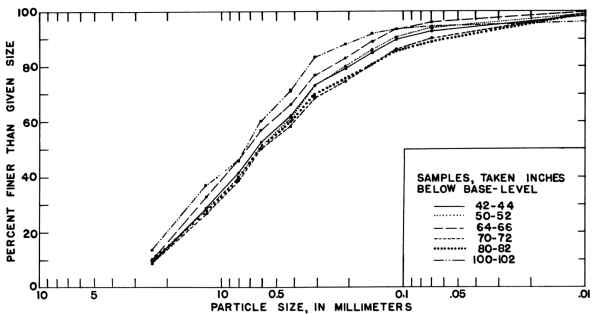
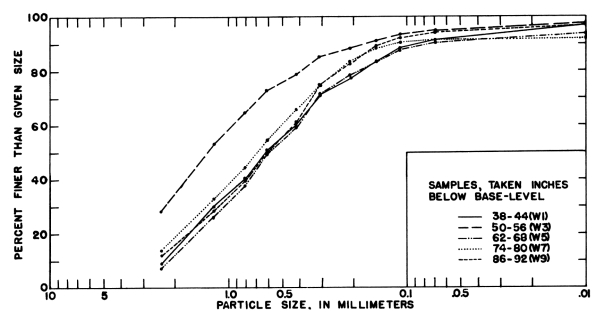
Figure 67— Above: Size-distribution curves for typical samples of the deposits of the LoDaisKa Site, Square M11.
Below: Size-distribution Curves for typical samples of the deposits of the LoDaisKa Site, Square J8.
[Pg 96] Local differences and variations in the parent rock and relief have a profound effect on soil characteristics (Thorp, 1941). In the present instance, there is no evidence of any appreciable change in the relief of the area immediately surrounding the site since the beginning of human occupation. The site is located towards one end of the relatively steep slope of outwash debris from the Fountain Formation which forms the overhang and extends upslope above the site. The deposits which make up the site are also the product of slope wash and of weathering of the overhang; they are some six feet above the level of the stream in Strain Gulch. The height of the deposits above modern stream level makes it seem most unlikely that the site was ever flooded in Recent times (Hunt, personal communication—Irwin and Irwin). Accordingly, the deposits would be a colluvium rather than alluvial in nature and would be derived from the overhang. Mechanical analyses of several samples of the Fountain Sandstone from the overhang suggest that the sandstone as it is found above the site is quite homogeneous, although it varies in color from white to maroon (see pg. 99 of this report):
| Diameter in mm. | Percent by weight |
|---|---|
| 2.00 | 19.33% |
| 2.00-1.00 | 16.51% |
| 1.00-0.71 | 8.64% |
| 0.71-0.50 | 8.33% |
| 0.50-0.351 | 8.61% |
| 0.351-0.25 | 8.89% |
| 0.25-0.177 | 5.51% |
| 0.177-0.125 | 5.68% |
| 0.125-0.088 | 4.69% |
| 0.088-0.062 | 3.37% |
| 0.062 | 10.40% |
| 99.96% |
These results compare closely with the analyses of the deposits making up the site, and suggest that weathering of the parent material was primarily dissolution, probably accompanied by some mechanical disintegration. [Pg 97]
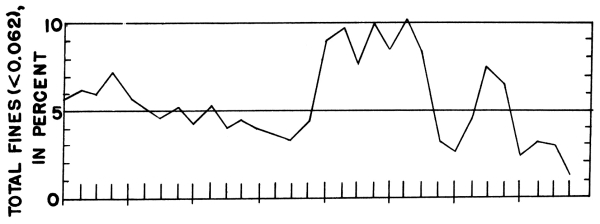
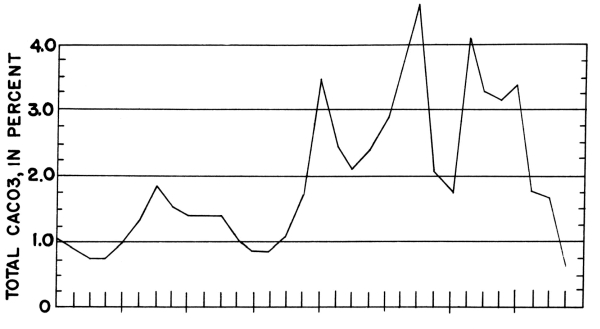
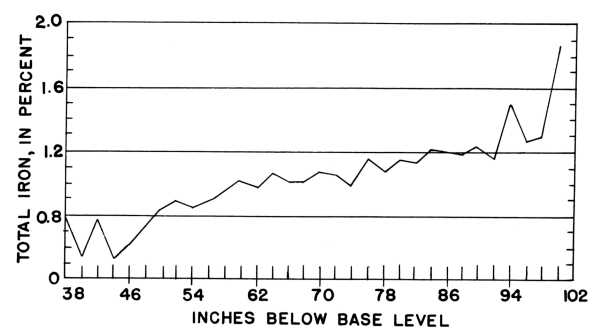
Figure 68— Above: Changes in relative importance (weight percent) of fine silt and clay fraction with depth below 38 inches below baseline, LoDaisKa site.
Center: Changes in concentration of total calcium carbonate with depth below 38 inches below baseline, LoDaisKa site.
Below: Changes in concentration of total soluble iron with depth below 38 inches below baseline, LoDaisKa site.
[Pg 98] Representative particle size distributions of the deposits are shown in the cumulative curves in Fig. 67. The median diameters and sorting coefficients, as we have already noted, suggest a uniform distribution of particle sizes, with the exception of the sample (W3) from depth 52-58 inches below baseline in front of the site. The median diameter of this sample is 1.32 mm., considerably larger than that (0.60-0.70 mm.) for the rest of the deposits. A line of much larger rocks at this level gives evidence of a period of rock fall, although this does not seem to extend to the very back of the shelter, and is not represented in the sample collected there. The human occupation of the site is uninterrupted, and there is no suggestion that this fall reflects any change in the mode of deposition or any change in climate. Increased aridity may have brought about an important increase in aeolian deposition in the area during some period of occupation, but the location of the site in a sheltered valley makes it unlikely that this would be indicated by the deposits. Any significant change in the relative importance of the coarse and fine fractions—suggesting perhaps such a change in deposition—would be reflected in the median diameters of the samples (Jenny, 1941). The similarity in the median diameters of the particles from the deposit gives evidence of a relatively uniform mode of deposition.
The amount of uncombined carbonate and “free” or acid-soluble iron oxide in the clay and silt fraction (finer than 0.062 mm.) of the samples from the back of the shelter (M11) was determined by chemical analysis. The results of these analyses have been summarized in Fig. 68, where the percentage of the fines by weight has also been plotted. The uncombined oxides and carbonates (iron oxide and calcium carbonate) are present in the fine fractions especially in the form of an adsorbed coating on the surfaces of the particles, and also as precipitates acting as cementing materials to bind them together (Carroll, 1958; Deb, 1958; Barshad, 1958). The free iron oxides were obtained by dissolving the sample in 10% HC₁ (by volume) and digestion over a steam bath. It is assumed that any dissolution of the clay minerals is insignificant and that the amount of soluble iron determined is truly representative of the uncombined iron oxide in the sample (Barshad, 1958). The amount of carbonate was determined in the form of CO₂, by digesting the sample in 0.1N HCl; it is assumed that all of the carbonate occurred in the form of calcium carbonate.
A carbonate and iron oxide analysis was run on several samples of the Fountain sandstone which made up the roof of the rockshelter, in order to determine the amount of variation in the parent material:
| Sample | Percent Carbonate (by weight) |
sol. | Percent Iron (by weight) insol. |
total |
|---|---|---|---|---|
| Light | ||||
| No. 1 | 0.34% | 0.43% | 0.14% | 0.57% |
| No. 2 | 0.31% | 0.38% | 0.13% | 0.51% |
| Red | ||||
| No. 1 | 0.08% | 4.95% | 0.62% | 5.57% |
[Pg 99] The amount of soluble iron is quite variable in the parent material; it forms a coating on the primary minerals and gives the rock its red or maroon color. It is interesting to note that the soluble iron in the deposits, presumably derived from the Fountain sandstone, maintains a rather regular increase to a maximum at 102 inches below base-level. The amount of carbonate in the parent rock, by contrast, is certainly not enough to account for the variation which was found in the deposits and for the concentration of CaCO₃ at the particular levels. In the present instance there seems to be a definite independence in the movement and location of concentration of the soluble iron and of the fine silt and clay, which seem to be associated with concentrations of carbonate. The calcium carbonate occurs in the form of a coating on the fine particles and, more important, as a cement binding the particles together. This was particularly noticed on the artifactual and bone materials from the deposits from 70 to 94 inches below baseline.
The differential accumulation of calcium carbonate in the profile is due to either variations in the texture of the deposits, with the greater accumulations occurring in the zones of finer particle size, or to the processes of weathering of the deposits (Miller and Leopold, 1953). The present study suggests that changes in the distribution of calcium carbonate and the fine silt and clay fractions in the deposits cannot be related to variations in the parent material, relief in the immediate area, or the mode of deposition. Concentrations of calcium carbonate may be associated with changes in the depth of the water table or in drainage conditions. There is no evidence that the water table ever came close to the surface in this area in Recent times; at present it is something more than 150 feet below the level of the site. Internal and external drainage conditions of the deposits have probably not changed since the beginning of human occupation of the shelter, being largely determined by the nature of the relief and parent rock.
It is possible that the particular accumulation of calcium carbonate and of fine silt and clay between 68 and 96 inches below base-level are the result of downward migration and concentration of the fine fraction and CaCO₃ due to weathering processes—defining a paleosol. Some change in climatic conditions, perhaps just sufficient to modify to some extent the nature of the vegetation cover (Nikiforoff, 1937) seems to offer one logical explanation for the distribution of calcium carbonate, and of the fine silt and clay fraction—the products of soil development in semi-arid environments (Bryan and Albritton, 1943). It is hoped that x-ray and mineralogical analysis of the samples will definitely establish whether or not we are dealing with a buried soil.
If we do interpret the results of the chemical analyses as indicating a period of increased aridity over conditions as they now exist in [Pg 100] the area, one could establish a terminus post quem for the archaeological complexes below approximately 64 inches below baseline. Accordingly, the artifactual materials with Great Basin influences and the earlier Duncan types may date from some time late in the Altithermal. This interpretation would not be completely out of keeping with a dating of the archaeological materials on typological grounds.
Acknowledgments
The author is particularly indebted to Dr. C. J. Rodden for his interest and assistance in the chemical analyses, and to Prof. John P. Miller for his suggestions and helpful criticisms of the preliminary draft of this manuscript.
References
Barshad, I., 1958 Soil Development: Univ. of Calif., Berkeley, 69 p.
Bryan, K. and Albritton, C. C., 1943, Soil phenomena as evidence of climatic change: Amer. Jour. Sci., 241, 469.
Carroll, D., 1958, Role of clay minerals in the transportation of iron: Geochimica et Cosmochimica Acta, 14, 1.
Deb, B. C., 1958, The movement and precipitation of iron oxides in podzol soils: reprint.
Hunt, C. B., 1954, Pleistocene and Recent Deposits in the Denver Area, Colorado: U.S.G.S. Bull. 996-C, 140 p.
Jenny, H., 1941, Factors of soil formation, a system of quantitative pedology. McGraw-Hill Book Co., Inc., New York.
Knight, S. H., 1929, The Fountain and the Casper formations of the Laramie Basin: Contri. from Dept. of Geology of Columbia Univ., XL, No. 5, 82 p.
Miller, J. P. and Leopold, L. B., 1953, The use of soils and paleosols for interpreting geomorphic and climatic history of arid regions: Res. Council of Israel. Spec. Publ. No. 2, 453.
Miller, J. P., and Wendorf, D. F., 1958, The alluvial chronology of the Tesuque Valley, New Mexico: Jour. Geol., 66, 177.
Nikiforoff, C. C., 1937, General trends of the desert type of soil formation: Soil Sci., 43, No. 2, 105.
Simonson, R. W., 1954, Identification and interpretation of buried soils: Amer. Jour. Sci., 252, No. 12, 705.
Thorp, J., 1941, The influence of environment on soil formation: Soil Sci. Soc. Amer. Proc., 6, 39.
[Pg 101]
By Edward Lewis
Cynthia and Henry Irwin excavated the rock shelter at the LoDaisKa Site on the Otto Sanger property by Strain Gulch near Morrison, Colorado 1956-1957. The vertebrate fossils were identified by the Upper Cenozoic Research Group: C. B. Schultz, T. M. Stout, and L. G. Tanner of the University of Nebraska, and Edward Lewis of the U.S. Geological Survey. Minor elements of the vertebrate fauna identified by them include 1 amphibian bone fragment, 2 lacertilian reptile vertebrae, and 16 bird bones and fragments of undetermined genera and species. All the other vertebrate remains were mammalian and include:
From one to seven individuals are represented by each of these names except Odocoileus, which accounts for the great majority of the specimens. We conclude that the people who were responsible for this deposit lived, while at this site, on a diet in which venison, probably from the Mule Deer (Odocoileus hemionus), predominated. There are surprisingly few Bison bones, and just one specimen each of “Elk” and Bighorn.
All of this fauna still lived in the same general area in historic times; it is a Recent fauna. The symbol (†) marks genera and species known to occur in the fauna of the Piney Creek alluvium (Hunt, 1954, p. 114-117).[5] These elements of the Piney Creek fauna have previously been reported from the nearby Denver area by Hunt (1954, p. 118), and have been identified by the Upper Cenozoic Research Group in the collections [Pg 102] made by Scott[6] from the nearby Kassler area, and by Hunt[7] from the dark-colored, sandy and silty alluvium that occurs along Strain Gulch near the Sanger Site. It seems reasonable to believe that the age of the main deposit in the shelter, below the ceramic occupation layer, is approximately equivalent to the age of the dark-colored, sandy, silty alluvium and that of the Piney Creek alluvium.
| A | B | C | D | E | F | G | H | ||||
|---|---|---|---|---|---|---|---|---|---|---|---|
| 12 | 24 | 36 | 48 | 60 | 72 | 84 | 95 108 | ||||
| Amphibian | 2 | 1 | |||||||||
| Reptile | 2 | ||||||||||
| Bird | 3 | 2 | 11 | ||||||||
| Lagomorphs, sp. undet. | 4 | 1 | |||||||||
| Lepus | 18 | ||||||||||
| Rodentia, undet. | 2 | ||||||||||
| Cynomys | 4 | 1 | 1 | 20 | 3 | 1 | |||||
| Citellus | 3 | 1 | |||||||||
| Tamias and Eutamias | 1 | 2 | |||||||||
| Thomomys | 2 | ||||||||||
| Castor (canadensis) | 2 | ||||||||||
| Peromyscus | ?3 | ||||||||||
| Microtine | 2 | 4 | |||||||||
| Carnivore, undet. | 1 | 1 | |||||||||
| Canis | 1 | ||||||||||
| Mephites | 1 | ||||||||||
| Taxidea | 1 | 1 | |||||||||
| Felis | 3 | ||||||||||
| Cervus | 1 | ||||||||||
| Odocoileus | 26 | 18 | 32 | 42 | 44 | 70 | 17 | ||||
| ?Bos | 6 | ||||||||||
| Bison (bison) | 4 | 5 | 7 | 11 | |||||||
| Ovis (canadensis) | 1 | 1 | |||||||||
[Pg 104]
By Walton C. Galinat
(Below Dr. Galinat has identified key specimens from the site from which data table was completed).
[Pg 105]
[Pg 106]
Authors’ Comments on Floral Remains
It is interesting to note the following uses of some of these plants by modern Indians in the general area.
For further information see: Chamberlain, 1911; Train, Henricks, and Archer, 1941; P. A. Vestal, 1952, P. A. Vestal, 1940 and the bibliographies appended to these works.
Authors’ Comments on Maize from LoDaisKa
Six specimens of Zea mays were recovered from the LoDaisKa Site. These were distributed vertically through the deposit, with 3 assigned to Complex D, 1 to Complex B, and 2 to Complex A. These few examples represent 3 different types of corn. In order to understand the significance of the LoDaisKa material, an attempt has been made to relate it to other prehistoric maize developments.
[Pg 107]
| 16 | 20 | 24 | 28 | 32 | 36 | 40 | 44 | 48 | 52 | 56 | 60 | 64 | 68 | |
|---|---|---|---|---|---|---|---|---|---|---|---|---|---|---|
| Boraginaceae Lithospermum ruderale |
1 | |||||||||||||
| Chenopodiaceae Chenopodium |
||||||||||||||
| Grayia Brandegei | ||||||||||||||
| Cyperaceae Carex |
||||||||||||||
| Scleria | 1 | |||||||||||||
| Fagaceae Quercus |
1 | 1 | 1 | 1 | 1 | 1 | 3 | 1 | 1 | |||||
| Gramineae Muhlenbergia |
1 | |||||||||||||
| Paspalum | ||||||||||||||
| Zea Mays | 1 | 1? | 1 | |||||||||||
| spp. | 1 | |||||||||||||
| Leguminoseae Lupinus perennis |
||||||||||||||
| spp. | 1 | |||||||||||||
| Lilliaceae Allium |
||||||||||||||
| Musci Polytrichum |
1 | |||||||||||||
| Pinaceae Juniperus spp. |
1 | |||||||||||||
| Rosaceae Cretaegus |
1 | |||||||||||||
| Prunus spp. | 1 | 2 | 4 | 5 | 1 | 1 | 1 | |||||||
| Umbelliferae Taenidia spp. |
1 | 1 | ||||||||||||
| 72 | 76 | 80 | 84 | 88 | 92 | 96 | 100 | 104 | 108 | 112 | 116 | 120 | |
|---|---|---|---|---|---|---|---|---|---|---|---|---|---|
| Boraginaceae Lithospermum ruderale |
2 | 1 | 1 | 1 | |||||||||
| Chenopodiaceae Chenopodium |
1 | 1 | |||||||||||
| Grayia Brandegei | 1 | ||||||||||||
| Cyperaceae Carex |
1 | 1 | |||||||||||
| Scleria | 1 | ||||||||||||
| Fagaceae Quercus |
3 | 4 | 3 | 2 | 1 | 1 | 1 | ||||||
| Gramineae Muhlenbergia |
|||||||||||||
| Paspalum | 1 | ||||||||||||
| Zea Mays | 1? | 2 | |||||||||||
| spp. | 1 | ||||||||||||
| Leguminoseae Lupinus perennis |
1 | ||||||||||||
| spp. | |||||||||||||
| Lilliaceae Allium |
1 | ||||||||||||
| Musci Polytrichum |
1 | 1 | 1 | ||||||||||
| Pinaceae Juniperus spp. |
|||||||||||||
| Rosaceae Cretaegus |
1 | 1 | |||||||||||
| Prunus spp. | 1 | 5 | |||||||||||
| Umbelliferae Taenidia spp. |
|||||||||||||
[Pg 108]
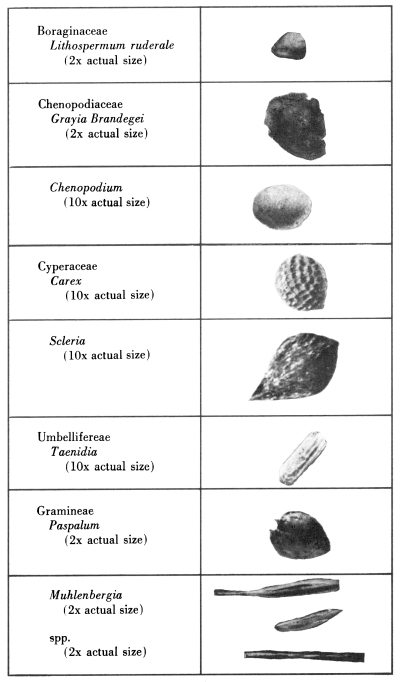
Figure 69—Floral Remains.

Figure 70—Floral Remains.
[Pg 109]
[Pg 110] Maize (Zea mays) was originally thought to have descended from teosinte, (Euchlaena), a wild plant occurring in Mexico. Now however, most authorities believe that a primitive maize originated as a distinct plant. (Mangelsdorf and Reeves, 1939). Teosinte, according to their hypothesis is a later hybrid of maize and its distant relative, Tripsacum. (A common species of Tripsacum is Gama grass.) Pollen studies of deep cores taken in Mexico City indicate that wild maize may have grown in that area well back into the last iinterglacial. (Barghoorn, Wolfe and Clisby, 1954).
From these obscure beginnings, maize underwent considerable development and diversification, and later in many cases mixed with teosinte. One of the basic races which evolved is represented by a modern Mexican type called “Chapalote”. (Wellhausen et al., 1952). The three specimens assigned to Complex D at LoDaisKa were identified as belonging to the Chapalote type. W. C. Galinat has reviewed the early distribution of Chapalote as follows: “The present-day Mexican race of maize called ‘Chapalote’ was one of the basic races in North America in prehistoric times. A re-examination of the actual cobs, photographs or descriptive literature covering 14 sites in northwestern Mexico and the southwestern United States suggests, that the archaeological maize from this area was either pre-Chapalote, Chapalote or a more evolved and more tripsacoid derivative called ‘Basketmaker’ corn. The Mexican states with prehistoric Chapalote are Michoacan (lava impressions), Sonora (Dark Cave), and Chihuahua (Swallow Cave, Slab Cave, Tau Cave, Olla Cave). In the region now the United States, Chapalote occurred in Arizona (Richards Cave, Tonto Cave, Painted Cave), Colorado (Cottonwood Cave, LoDaisKa Cave), and New Mexico (Bat Cave, Tularosa Cave, Cebollita Cave).”[8]
In investigating interrelationships one criterion to consider is the degree of evolution of the Chapalote: Specimens from LoDaisKa are less primitive than the pre-Chapalote pod-pop corn from the first stratum of Bat Cave (Dick, n.d., and Mangelsdorf and Smith, 1949). At the other extreme they are less evolved than the material from Cottonwood Cave. (Hurst, 1948). They are closer to some of the specimens from the pre-ceramic levels of Swallow Cave, Chihuahua (Mangelsdorf and Lister, 1956).
A second criterion for comparison is the amount of mixing with teosinte. Several archaeological sequences in this area show a rather sudden alteration in maize type due to an introgression of teosinte, e.g. Bat Cave, Swallow Cave, Tularosa Cave. Mangelsdorf and Lister (op. cit., p. 173-4) conclude that “a very marked change in the maize of northwestern Mexico and adjoining area of New Mexico occurred at about 750 ± 250 A.D.” The LoDaisKa specimens show no evidence of teosinte introgression. In this they approximate most closely the pre-ceramic material from Swallow Cave, maize from Strata II and III of Bat Cave and early levels of Tularosa Cave. [Pg 111]
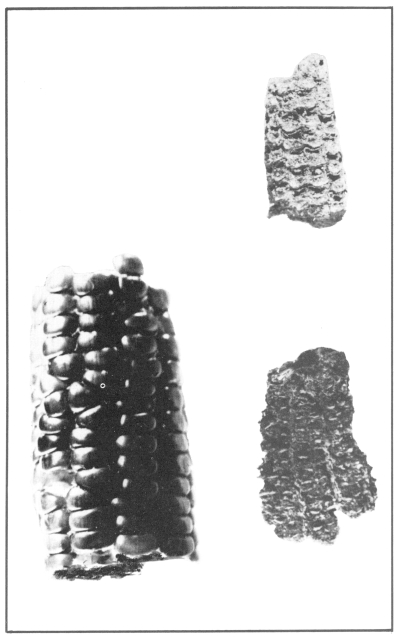
Figure 71—Zea mays, Chapalote type.
Above, fragments of cobs from LoDaisKa Site.
Below, Modern Chapalote maize. (Lent by W. C. Galinat).
2× actual size.
[Pg 112]

Figure 72—
Zea mays, fragments of cob of popcorn(?).
2× actual size.
The fourth example of corn was assigned to Complex B. W. C. Galinat (this report) described it as a 16-rowed cob with very small kernels, “possibly a popcorn”. With only this cob preserved, little more can be determined. It is evidently more evolved than the previous specimens. According to P. C. Mangelsdorf, (Personal Communication, 1959), the high row number and small size are similar to a Mexican type called Conico, but it is more probable that the LoDaisKa variety is ultimately derived from a Chapalote-teosinte mixture. Teosinte introgression often involves a high degree of variability, which could include the small 16-rowed form. Kivett (1952a) reports popcorn from a Woodland Site in Nebraska, and Mangelsdorf (Personal Communication, 1959) believes that this is probably Chapalote.
It is probable that a second type of maize was also cultivated at this time. Two single component Woodland sites in the Morrison area have yielded a dent-type corn. (Irwin and Irwin, n.d.). [Pg 113]

Figure 73—
Zea mays, “dent” variety.
Left kernel from LoDaisKa site.
Right, modern (hybrid) dent maize.
Actual size.
The remaining two maize specimens consist of kernels rather than cobs and were assigned to Complex A. They were identified as a variety of dent corn. This is a much more evolved type, resulting from the crossing of a flinty starch corn with a softer type, and probably originally involving teosinte introgression. A dent maize is characteristic of sites of the Fremont Culture in Utah (Wormington, 1955). Its occurrence has been the subject of much discussion. Fremont maize shows some similarities to pyramidal dent corn of the Mesa Centrale (Mexico), and even more to Zapalote Chico, a type grown on the Isthmus of Tehuantepec. It is present in some Basketmaker sites, but not in the later Pueblo localities. Various authorities, (Nickerson in Wormington, 1955; Carter, 1945; Anderson, 1948) have expressed doubt that dent corn reached the Fremont area by any direct route through the Anasazi, Hohokam or Mogollon areas. A possible route via the Plains was suggested, but evidence was totally lacking because of the absence of perishables in most Plains sites. The Morrison area provides some support of the Plains hypothesis: Fremont peoples evidently did range into areas where dent corn was used and could have acquired it there. However, until much more evidence is available, the question must remain open.
[Pg 114]
By Donald R. Whitehead
A preliminary pollen analytical investigation has been attempted on material from the LoDaisKa Site in order to determine the feasibility of working with such sediments, and to see what culturally significant plants might be represented. Due to the extremely poor preservation in all but the lowermost levels no pollen diagram has been prepared. Such a diagram would be misleading, because many of the original constituents of the pollen flora might have been destroyed by differential degradation. A brief description of the investigation follows, with a discussion of the potentially significant grass pollen.
All samples were prepared by boiling for six minutes in 10% KOH, washing with 10% HCI to remove carbonates, boiling for ten minutes in about 30% HF, actolysing for one minute, staining with fuchsin, and mounting in silicone oil. For each sample a total of four slides was counted by making traverses at one millimeter intervals.
In order to attempt an identification of the various large grass pollen encountered, the long axis of each grain and the pore diameter (including annulus) were measured, and the ratio between the two plotted. Barghoorn, Wolfe, and Clisby (1954) have suggested that this ratio can be used to supplement size measurements in attempting to identify fossil pollen of the tribe Maydeae. However, one can not compare directly the size data from the LoDaisKa fossils with the data from modern pollen assembled by Barghoorn, Wolfe, and Clisby (l.c.). Christensen (1945) has shown that not only do recent and fossil grains of the same species differ in size (depending partly upon the type of sediment in which the pollen is preserved), but also, different methods of preparation greatly affect the size, often differentially with respect to fossil and modern pollen. The recent pollen measured by Barghoorn, Wolfe, and Clisby (l.c.) was prepared by acetolysis and mounted in glycerine jelly. By comparing the size of modern Corylus avellana pollen prepared and mounted in this manner (ca. 28, Christensen, 1945) with the size of fossil Corylus avellana pollen from a variety of sediment types prepared and mounted by the technique used in the present investigation (ca. 24, S. T. Andersen, [Pg 115] pers. comm.), one can arrive at a factor (7/6) by which the size of the fossils can be multiplied in order to compare more directly with the data presented by Barghoorn, Wolfe, and Clisby (l.c.). It should be emphasized that such an absolute comparison is dangerous, because there is no way of determining precisely how the environment of preservation at LoDaisKa has affected the pollen, and there is no guarantee that size changes of Corylus and Gramineae pollen are absolutely proportional.
For each grass grain both the long axis measurement and the pore axis ratio are tabulated in the results below. Only fully expanded grains were measured.
The provenience of the samples analyzed below is as follows:
All samples were taken at 6 inch intervals.
Samples W 1-10 were collected in Square J8, starting at 38 inches below baseline.
Samples E₁ 1-6 were collected in Square M11, starting at 38 inches below baseline.
Samples E₂ 3-7 were collected in Square P 9-10, starting at 62 inches below baseline.
Samples E₁ 1 - E₁ 5 (38-68″)
Preservation extremely poor, only badly corroded pine pollen, a
few Compositae grains, and many plant fragments (mostly coniferous tracheids).
It is interesting to note that many of the plants identified from their megascopic remains by Walton C. Galinat are likewise represented in the pollen flora (e.g., Allium, Quercus, Juniperus and chenopods). As Galinat has also identified several fragments of Zea Mays, it was hoped that pollen of Zea might be found in some of the oldest levels. Unfortunately, none of the fossil grass pollen can be definitely identified as that of Zea. It seems obvious that the three largest grass grains (over 70ₘ) are too large to be Tripsacum, but whether they represent teosinte or Zea can not be established. The pore of two of these was obscured by detritus, and that of the third was greatly distorted. Thus no ratio could be established.
The remainder of the grass grains seem to fall within the limits of the genus Tripsacum (size extremes 33.6ₘ to 64ₘ, and ratio extremes 1:3.0 to 1:4.8), although the pore-axis ratio of some appears to be too large. However, the possibility must be left open that these smaller grains might not be Tripsacum. As yet there is very little pollen size data available for the grasses of North America. Geisler (1945) has measured pollen from 32 species and of these, Zizania aquatica has the largest grains (range 38ₘ-50ₘ). It is important to note that she did not employ acetolysis, so that this range is on the small side. In Europe, Firbes (1936) has presented pollen size data [Pg 118] for 103 species of grasses, and of those he studied, Avena, Secale, Triticum, Hordeum, and Elymus possess pollen as large as that of Tripsacum. Hence it would appear to be necessary to study intensively the pollen of most of our native grasses in order to establish size and other morphological criteria for identifying the smaller LoDaisKa grass pollen.
As the preservation is distinctly better in the lower levels of the deposit, a careful and detailed pollen analytical investigation, with recourse to adequate reference material might be profitable.
Acknowledgments
The present investigation was carried out in the Laboratories of the Geological Survey of Denmark while the author was sponsored by a Fulbright Fellowship. The author is particularly indebted to Svend Th. Andersen for his suggestions and helpful criticisms of the manuscript.
Bibliography
Barghoorn, E. S., M. K. Wolfe, and K. H. Clisby,
1954.
Fossil Maize from the Valley of Mexico.
Bot. Mus. Leaflets,
Harvard University 16: 229-240.
Christensen, B. Brorson, 1945.
Measurements as a
Means of Identifying Fossil Pollen.
Danmarke Geologiske Undersgelse IV
R., Bd. 3, Nr, 2.
Firbes, F., 1937.
Der pollenanalytische Nachweis
dos Getreidebaus.
Zeitschrift für Botanik, Bd. 31: 447-478.
Geisler, F., 1945.
A study of Pollen Grains of
Thirty-two Species of Grasses.
Butler Univ. Bot. Studies 7: 65-73.
Below we shall summarize the life habits of two ethnographically known groups who lived near the Plains-Great Basin fringe. This is done in an effort to present a brief outline of the type of life people in the Morrison area could have lived. It is designed to serve as a guide for interpretation of the archaeological remains, and should provide insight into areas of social and religious action. The first group, the Ute, are known to have lived for a time in the region; the second, the Pawnee, were never in the area proper, but do represent the sort of pottery-using, corn-growing Indians that had occupied it in the past.
This use of comparative ethnology and the reconstruction which follows are in the nature of a theory, a theory of methodology. Too often, as J. O. Brew (1946) has pointed out, archaeological fact gathering has run riot ahead of the interpretation of these facts. Brew quoted C. C. Kluckhohn in this respect: “In any case the alternative is not between theory and no theory or a minimum of theory, but between adequate and inadequate theories.... For I am afraid that many of our anthropologists who are most distrustful of theory are like Molière’s character who spoke prose without knowing it, for a complex theoretical [Pg 119] viewpoint is usually implicit in some of the most apparently innocent statements of facts.” (Brew, 1946, p. 45; but for full context see Kluckhohn 1939). We have striven, however, to remain aware of the assumptions involved.
The Ute were among the first Indians to get horses from the Spanish. Subsequently they moved about rather freely and were rather quick to adopt the white man’s culture whenever this was present in their area. There are almost no early accounts of the Ute. They had neither the spectacular aspects of the true Plains Indians, nor lands close to the trails frequented by pioneers and early explorers. On the other hand, they did not enjoy the isolation of many of the Great Basin tribes which preserved their ways of life into comparatively recent times. Thus ethnography of the Ute is relatively scant except for a few accounts and short articles. There are three principal works. The first is Robert Lowie’s Notes on Shoshonean Ethnography (1924), based primarily on observations at Ignacio, Navajo Springs and White Rock. The second is Omer Stewart’s “Culture Element Distribution: XVIII, Ute, Southern Paiute”, (1942), while the third is Edward Gifford’s Culture Element Distribution XII: Apache-Pueblo (1940). Another short paper by Ralph Beals (1935) on the ethnology of Rocky Mountain National Park adds to the picture, though he draws heavily on Lowie’s work. Finally there is a collection of articles gathered by the Durango Public Library and edited by H. S. Daniels (1941). This is composed of a series of interesting papers by people intimately connected with the area surrounding the present Ute reservation. J. Alden Mason’s article “Myths of the Uintah Utes” (1940) contains numerous myths which may yield scraps of ethnographic material if care is used in selection. Other short works can be found in the bibliography and will be referred to in the text.
One of the greatest problems facing the Ute and Shoshone on mountain fringes was adaptation to several different ecological biomes. Their success is attested to by the fact that the Ute spread all over Colorado and southern Wyoming except the Plains.
The adoption of the horse resulted in significant changes in Ute culture. In general, the use of horses affected hunting methods and locomotion. Where it brought the Ute into intimate contact with Plains Indian cultures, many of their old Basin traits were replaced by borrowed artifacts and techniques. For example, articles of rawhide replaced basketry in most cases (Steward, 1940, p. 422). However, very little is known about the quasi-Plains Ute, as mountain lands were quickly appropriated by whites. Buffalo were exterminated from mountain [Pg 120] parks in Colorado by 1870. The works cited refer to isolated groups on the western fringe which retained an essentially pre-horse culture.
The people we deal with then have the “gathering small game” traits of Steward’s Western Subarea of the Intermontane Region. In addition, uplands and mountain regions afforded some larger game. This dual economy was probably a great factor in their adaptability, and it was undoubtedly a close approximation of that of protohistoric and prehistoric inhabitants of the area.
Except for the ecologic variation cited above, Ute culture was fairly uniform over a wide area. Because of this and the general limitation of data, it will be treated as a whole.
Seeds and berries of almost every description were gathered, mainly by the women of the camps. According to Lowie, among the neighboring Paviotso, men often participated in gathering piñon nuts, a fundamental element in the diet. Stewart’s data suggests that this was probably true of the Ute. Sunflower seeds were boiled; acorns were gathered and treated to render them edible. Fruits were exploited where available. These products were gathered in large baskets, certain of them being reserved for storage. Edible roots were dug up with the aid of a digging stick. Other gathering devices included notched poles, throwing sticks, and seed beaters.
Among the animals hunted, Lowie mentions buffalo, elk, deer, and rabbits; eagles were snared from pits. In Mason’s Myths moose and bear are mentioned particularly. Possibly mountain sheep and antelope should be included in this list. Small game was important, such as quail and rodents, i.e., prairie dogs and squirrels. Stewart lists a number of insects eaten as part of the diet, which were roasted and parched then often stored.
Buffalo were surrounded by a circle of men and shot. Deer were often driven into a deep pit between converging arms of a sagebrush enclosure. Deer, antelope and buffalo decoy masks were often used. Rabbits and other small game were hunted by driving them into nets of bark fiber. Rodents were smudged out, and special blunt arrows were often used in shooting prairie dogs. Mountain sheep were pursued until cornered and then shot with arrows.
Fish were also undoubtedly a common article of diet. John Dewey, a Ute, told Mason about taking fish by means of arrows and fish lines, while Lowie mentions fish shooting and describes grass rafts for the Uintah, and Ute fish weirs.
For all hunting and fishing, ritual observances and purification were important. Gifford mentions ceremonial sweat houses in this connection, while Stewart lists a number of important taboos. [Pg 121]
Hand stones and grinding slabs were employed for preparing seeds and berries. Some pounding was done. Seeds could be roasted underground or could be made into a kind of gruel. Meat, according to McCall (Daniels, ed., 1941), was roasted over the fire or jerked. In this connection some statements of E. G. Palmer concerning the Paiute are of interest. The Paiute were very similar in culture to the Ute and before 1700 were probably indistinguishable from them (Schroeder, 1953). In particular Palmer mentions cooking by heating rocks, covering the desired edibles with wet grass and sprinkling them with water to create a kind of steam bake. About their food in general Palmer says, “As to food the Pah Utes will eat anything that will not prove absolutely poisonous soon after being swallowed.”
Gifford notes roasting and eating of both yucca and cacti. He also lists the use of surface salt and clay for flavoring. Small animals were pounded up whole and cooked. Bone was cracked for marrow or ground up and eaten if possible.
Prior to the use of small skin tepees, the Eastern Ute used a conical or domed-shaped shelter of brush. These were used even after white contact, but usually only for summer habitation. The door faced east. Gifford and Stewart both note that the Ute used available rockshelters and lean-tos on hunting trips. C. T. Hurst in 1943 excavated an overhang containing evidence of Ute habitation. According to several sources, sweat houses were built.
Lowie reports that the Ute used fire drills only rarely though an informant told Mason that they did not use such devices. Obviously every effort was made to keep the fire going but apparently if one’s fire went out, one borrowed a light from a neighbor. Perhaps in an emergency fire tools could have been made.
Concerning the stone technology of the Ute we will quote a section from Powell (1875; noted in Lowie, 1924). “Obsidian or other stone of which the implement is to be made is first selected by breaking up larger masses of the rock and choosing those which exhibited the fracture desired; then the pieces are baked or steamed—perhaps I might say annealed—by placing them in a damp earth covered with a brush fire for twenty-four hours, then with sharp blows they are still further broken down into flakes approximately the shape desired. For more complete fashioning a tool of ... horn is used.” He also states that a small skin cushion was employed in the hand, and that often a few especially [Pg 122] skilled people would exchange their products for other items. Barber (1876) notes that a Ute hunter could differentiate between the types of stone projectile points used by various tribes. This is of special interest to the archaeologist for it indicates that point styles for such a group were intentional and fairly consistent over a period of time. Stone knives, scrapers, rough flakes and drills are listed by Gifford and Stewart in addition. According to Gifford’s informant, stone axes were polished. Arrowheads were stemmed or stemless, while the shafts were marked by rills engraved along the length. These were feathered and painted.
Lowie reports that the Ute made some pottery, and Opler (1941) found further evidence to support the claim. However, the production appears largely limited to cooking vessels, and stone boiling was popular. Stewart notes the occurrence of unfired figurines made for children.
In skin preparation, the flesh was first removed with a serrated scraper. For especially tough hides an adze-shaped scraper was used. Hair was removed with a split bone, the skin then moistened, stretched and smoked. According to Stewart this was done by the women. Some skins were painted with designs. Gifford and Stewart both report the use of skin shields.
Before white contact, an informant told Mason, the Ute used juniper bark and sagebrush fiber for blankets. Sinew was employed for thread, while pine pitch and horn served for glue. Baskets made by coiling were manufactured, as were twined mats. Important types were conical gathering baskets, water bottles, flat trays and dippers. Willow was the principal material used.
The Ute used rabbitskin and deerskin blankets as well as those of fiber. Men wore moccasins, a loincloth and some kind of garment for the upper part of the body, and possibly leggings in the winter. Women wore a type of skirt, moccasins, and possibly a shirt. Some Shoshones, probably including the Ute, wore sandals. However, these would be less suitable in rocky uplands than in mesa country. Various carrying devices such as bags or blankets were used. Cradles of two types were listed by Gifford.
Barber (1876) notes the extensive use by both sexes of ornaments and charm bags of red powder, possibly hematite. Gifford and Stewart both mention the use of paints and list beads, feather decoration and bone ornaments. Some people were tattooed and some had their ears pierced. [Pg 123]
Lowie mentions one game played by the Ute. This is a hand game with guessing sticks and counters. Douglas and Jeancon (1930) cite others such as a hoop and stuffed ball game. Juggling games seem to have been popular also. Stewart lists a number of additional games. There were dances for both sexes accompanied by drums and notch-stick vibrators. Other musical instruments used may have included rattles of deer hooves, whistles, and possibly musical bows.
Society was probably arranged in bilateral exogamus kin groups. Inheritance may have been patrilineal. Marriage was a rather casual arrangement, the ceremony simple. Immediate residence was patrilocal, or at the father’s hut. Later, the couple built their own shelter. There was some polygamy, Steward (1938) notes that society was organized bilaterally in most places in the Intermontane Area. Relative equality of the sexes resulted from their approximately equal economic importance. If bison hunting and warfare tended to give northern Shoshone and Ute men an advantage, no formal institutions had developed to indicate it. Social organization was Neo-Hawaiian (Murdock, 1949) according to Stewart’s kin term list.
Some Ute recognized one especially powerful god represented by the sun, and many lesser gods and spirits. Individuals attempted to win their favor through magic. Myths and legends which featured these beings were told at night around low camp fires, but only during the winter according to Gifford. He also notes the naming of the sky as female, the earth as male, while various constellations were also designated. There was some development of the culture-hero idea in the person of Coyote among the Uintah Ute. Various tales of how Coyote obtained fire for man and helped him in other ways were related to Mason (1940). Ceremonies or rituals were probably held in open places, most likely in the form of dances. Medicine men or shamans were important figures. They were learned in the myths, and practiced as healers, using charms and herbs, some of which had true medicinal value. In addition the shamans were skilled at setting bones. They may have gotten their power from dreams or trances. During certain of what are termed life crises, birth, puberty, marriage, death, there were taboo observances. Certain foods were not eaten during pregnancy, while both Gifford and Stewart mention a special hut where girls were secluded during the first menses.
The Ute considered certain deeds to be “right or wrong” but there was no formal set of laws or authority to support moral judgment. [Pg 124]
The Ute language forms part of the Ute-Chemehuevi division, the southernmost of three divisions constituting the Plateau Branch of the Shoshonean stock of the Uto-Aztecan family. This northern orientation of language agrees well with certain cultural traits. There is very little structural resemblance with neighboring groups such as would be of interest in cultural interpretation. The language is characterized by an impression of phonetic softness rather than harshness; but of vagueness and lack of distinctness. (See Kroeber, 1910; Sapir, 1931; Stewart, 1957).
The dead were usually buried in rock crevices or were cremated. Supposedly their possessions were destroyed at this time, and their name became taboo in common usage.
The Pawnee of Nebraska are commonly regarded as characteristic of the semi-sedentary agricultural peoples of the Central Plains. However, ethnographic material about them is surprisingly sparse. Because they already had the horse by the late 17th century there is no record of them in completely aboriginal conditions. The most complete work is a monograph by J. B. Dunbar published in 1880, based on a series of articles in the Magazine of American History. Besides this there are the early accounts of the Lewis and Clark Expedition (see Grass, 1904) and that of J. T. Irving (1835). More specialized works are those of G. B. Grinnell (1912) and A. Lesser (1933). Subsequent studies are brief, and for the most part oriented toward nineteenth century historical events (e.g., Hyde, 1951). Wedel has included some information in his works on Pawnee archaeology (1938) and Central Plains subsistence (1941). Further brief articles may be found in the bibliography.
Maize played an important part in the economic life of the Pawnee. Most of the infrequent tillage was done by hoes consisting of bison scapulae lashed to bent or forked sticks. Hoeing was done only once or twice a year. The small cultivated patches, ranging in size from one-fourth to four acres, were usually located in the loose alluvium along creek bottoms. In addition to corn, beans, squash and watermelon were grown. All agricultural work was done by the women. They also gathered a large number of tubers, plants, berries, and fruits to supplement the diet. These included wild plum, huckleberry, chokecherry, sand cherry, wild potato, ground-bean and others. [Pg 125]
The products of the chase were also of great importance. The principal animal sought was the bison. One or two large scale hunting trips were organized yearly. The entire population of the earth lodge village moved to designated hunting areas. In pre-horse times the main method of hunting was the surround, although some hunters probably also worked singly, as they did in later times. The only weapon regularly used was the bow and arrow. The most important of these hunts was conducted in the early summer and ended just in time to harvest the crops.
Although the bison was the major subsistence animal, many other animals were hunted, especially for skins. Elk, deer, and antelope were taken by surrounds and “still hunting” or stalking. Beaver and otter were snared for their pelts; bears, cougars, and skunks were valued for both meat and hides. Prairie chickens and quails were hunted by boys with long withes.
After the harvest, maize was cut from the cobs, boiled, roasted, or dried, and stored in large bell-shaped pits. Other vegetable foods were similarly treated. Meat was dried and/or smoked.
Corn was often pulverized in a wooden mortar. It was then boiled, or made into cakes cooked in the ashes or on hot flat stones. Fresh corn was also parched or boiled as hominy. Corn, beans and squash, fresh or dry, were prepared by boiling and seasoned with tallow. Fresh meat was either cooked in the ashes, broiled, or boiled with vegetables. Dried meat was eaten raw or boiled. Most of the cooking was done in large pottery vessels manufactured locally.
During the winter the Pawnee inhabited large villages of stationary earth covered lodges. These measured 40 feet in diameter and 16 feet in height at the maximum. Such structures housed several related families. They were constructed as follows: the topsoil was removed and a framework erected. Inclined short poles were placed to form walls. Poles set on the inner and outer framework circles came to a blunt peak, forming the roof. Brush and willow were used for horizontal filling. Finally, hay and sod were heaped over the structure. Entrance was by means of a passage some 12 feet long. In the center was a fire basin about three feet in diameter. The floor was hardened by trampling and beating, and mats were spread over it. Sleeping places were near the walls on slightly raised platforms of willow rods, and were often partitioned off with skins or mats. [Pg 126]
Summer dwellings were tepees, 12-17 feet in diameter. Twelve to 20 poles formed the framework, and the cover was of bison hide, with openings for the entrance and smokehole. On the ground around the central hearth were laid mats and hides. Sweat houses were used in all seasons. These consisted of a frame of willow withes about six feet in diameter, covered with skins. Heated stones were sprinkled with water to produce steam.
The man’s costume was relatively simple, consisting primarily of breechclout and moccasins, with an additional skin robe in cold weather. For special occasions, the men wore elaborate shirts and headdresses of eagle feathers. Women wore moccasins, tight skin leggings, a skirt and a shirt suspended from the shoulders by thongs. Women wore their hair braided; the men had a horn-like scalp-lock. Paint was the main form of personal adornment. The types preferred were ochre, red and white clay, and yellow coloring obtained from flowers of a species solidago. These pigments were commonly mixed with bison fat or water.
There is very little descriptive material on the technology of the Pawnee. The manufacture of most of the utilitarian objects devolved on the women. Pottery was manufactured by the paddle and anvil technique. According to Grinnell (1912) a wooden or basketry mold was sometimes used for the base. Temper was of crushed rock. They wove mats of rushes, baskets of bark, and ropes of buffalo hair. Wooden mortars, pestles, bowls, dippers and spoons were shaped by burning and scraping. Bison horn was also employed for spoons. A stiff grass (Stipa funcea) was used for necklaces. Hide dressing and the making of clothing occupied a considerable portion of their time. A needle of deer metacarpal was used. Canoes were seldom made.
The men confined their technological interests to weapons for hunting and war. Bows were commonly four feet long and were made of “bois d’arc” (Maciura canadensis), hickory, “coffee bean” (Gymnocladus canadensis) and juniper. Formerly bison rib and elk-horn bows were also in use. Sinew backing was common. Arrow shafts were usually of dogwood (Cornus stolonifera). These had a series of three grooves running their length, which were variously explained as helping the flow of blood and keeping the arrow in the wound. These grooves were made with a very small chisel-like instrument. No information is available concerning flint working, but each tribe or large sub-group made a distinctive type of projectile point. Much care was lavished on this equipment and the accompanying skin quiver. Spears and rawhide shields were also manufactured. [Pg 127]
Trade was not extensive among the Pawnee themselves, or between them and neighboring tribes. However, this situation may be relatively recent in origin, due to the hostilities arising from increased white pressure. The main articles traded were “bois d’arc”, eagle feathers, pipe stone, and corn.
The Pawnee were divided into four sub-tribes or bands. Each of these consisted of a number of villages, and each village was also an endogamous matrilineal clan. Authority was vested in a hereditary chief and council of “leading men”. Band unity was maintained by large scale religious ceremonies and meetings of band councils, composed of the village chiefs. Similar mechanisms operated at a higher level to achieve a loose tribal organization.
The religious organization of the Pawnee was more highly developed and more sophisticated than that of most of the other Plains tribes. At the top of the supernatural pantheon was Tirawa, the creator. Below him were two classes of spirits—those of the earth and those of the heavens. The former were usually identified with animals and were the guardians of the people as a whole; the latter represented natural phenomena and were usually identified with stars. Foremost among these were the Morning and Evening Stars, representing the male and female principles, and parents of the first earth being.
Ceremonial action centered around collections of sacred objects—medicine bundles—which were believed to have been presented to the people in ancient times by the “gods”. Ceremonies connected with these usually involved a sacrifice or offering, or a ritual dramatization of the mythical receipt of the bundle. The most famous of these ceremonies was the annual sacrifice of a young girl to the Morning Star. Other important ceremonies revolved around the ever important corn and buffalo.
Shamans were organized into a secret society and power was received through instruction by an elder member. They were mediums and diviners and officiated in ceremonies. Each owned an ornate medicine bundle containing herbs and charms, such as fossil bones, etc. There were also “medicine men” who specialized in healing. Sickness was believed to be caused by intrusion of a foreign object or malign spirit, which was removed by sucking and chanting. Various plants were utilized for [Pg 128] medicine, including Artemisia bedoviciana, Acorus calamus, Monarda fistulosa, and fructata, Mentha canadensia and Argemona mexicana.
The Pawnee language is a branch of the Caddoan family of the Hokan-Siouan stock.
Willey and Phillips (1958) have pointed out the difficulty and illogicality of attempting to date artifacts exclusively by their affiliation. Of course, if distinct horizon-markers such as special forms of pottery are present, perhaps the technique is warranted. The remains at the LoDaisKa Site do not contain any such limited horizon markers. Moreover, dating of much of the associated materials in adjoining areas has, unfortunately, not progressed far enough to establish chronological limits for any forms. Therefore, it was felt that geological interpretation might be warranted. This was kindly undertaken by Mr. C. B. Hunt whose report appears above.
The pre-ceramic levels appear to correlate with the Piney Creek alluvium (see Hunt, 1954) and deposits equivalent geologically with the Tsegi Creek alluvium in the Southwest. Elsewhere, Hunt has stated that the Piney Creek may date about 1-2 millenia B.C., but is possibly older, (Hunt, 1955). The soil studies (this report) may indicate a somewhat greater age. Hunt feels that the ceramic levels for the most part correlate with a period of arroyo-cutting and washing that is assumed to be later than 1 A.D.
A series of samples for radiocarbon measurement was collected. These were taken from various areas of the site, some in relatively dry areas, others from more moist regions. Materials varied from seeds or plant fragments to charcoal. It was felt that these different materials would be helpful in indicating the effect of various factors in the C 14 method. The samples were then submitted to Dr. J. B. Griffin, of the University of Michigan. He kindly accepted the series. The outcome of the tests and those observations that accrue from the information will be published as soon as the data are available. A report should be due in a year. By this study it is hoped to establish fairly exact limits for certain cultures in the area. In the interpretations of these dates valuable evidence concerning cultural chronology and diffusion on the Plains may be gained.
The authors believe culture Complex A is related to what has been [Pg 129] termed the Fremont Culture of western Colorado and eastern Utah. Complex A appears to manifest itself between the surface (the erosional surface below a cow dung layer) and 44-48 inches below baseline. Complex A and the Fremont culture have a number of similarities. Foremost among these is pottery. All the plainware found is assignable to this complex. Although the total number of sherds is not large, one restorable vessel is represented. In shape, method of manufacture, temper, paste, color, and firing, this specimen approximated Wormington’s Turner Grey Variety II (Wormington, 1955). There are two points of difference between this and classic Fremont ceramics. First, it is a bowl, while most Fremont vessels are handled jugs. This is offset by the possibility that a second large sherd does come from a small pot or jug. Also Wormington (1955) and Taylor (1957) note the presence of bowl-forms at their sites. Second, much Fremont pottery is calcite tempered (Burgh and Scoggin, 1948; Wormington, 1955). However, Gunnerson (1956) has recently shown that choice of temper for the Fremont Culture is more a function of locality than of cultural preference.
A second correlation is found in the gaming pieces assignable to Complex A. The three decorated pieces illustrated are almost duplicated in some of Wormington’s illustrations and descriptions. Similar items have had a long history in the Southwest (Morris and Burgh, 1954).
Third, there is a similarity between class bb projectile points and certain Fremont points, particularly at Castle Park (Lister, 1951). Features include concavity of the edges, general narrowness, straight short bases, and frequent serrations. One of the points of Complex A is made on a curved flake, chipped only on one face. This is a rather distinctive type occurring also in Fremont sites. Wormington (1955), found some peculiar asymmetrical points like Fig. 27. She found no evidence of utilization as knives which their shape suggests.
The presence of dent corn, similar to that grown in Fremont localities is significant in indicating similarities in the ecologic orientation of the two groups.
Other artifacts included in the levels of Complex A are: Leaf-shaped and triangular knives, side, discoidal and serrated scrapers, expanding base drills, perforators, prismatic flakes?, 1 graver, small ovoid bifaces, utilized flakes, choppers/hammerstones, paint stones, splinter, sliver and headed awls, rib or scapulae knives, antler flakers, tubular beads, 1 tooth ornament, leather fragments, 1 wood arrow shaft, handstones and grinding slabs. End scrapers, perforators, prismatic flakes, small ovoid bifaces, sliver awls, perhaps antler flakers, and the tooth ornament are either extremely uncommon or absent at Fremont sites. These artifacts may be associated with culture Complex B. None are confined to the interval between the surface and [Pg 130] 44-48 inches below baseline. Evidently they were present before the occupation of the site by people of Complex A.
A word of caution is in order. Relatively speaking there are few artifact types assignable to Complex A. Pottery is especially scarce. However, projectile points of the type believed to be associated with it make up at least 40 percent of the total in the 44″-surface levels. We have tentatively identified it with the Fremont Culture on the basis of the evidence above. However, since so many distinctive traits of this culture are in the realms of architecture and perishable goods, we are necessarily dealing with a partial inventory. Without such features we can suggest but cannot prove.
One item of interest is the evidence that the Fremont people did reach eastern Colorado or at least trade with people of that area. A rather spectacular headband found in Castle Park (Burgh and Scoggin, 1948), was made from the feathers of a yellow flicker (Colaptes anratus luteus) which occurs only east of the mountains.
Since Complex A largely overlapped B, cultural reconstruction will have to be considered in the light of evidence from sites affiliated with it. This reconstruction will be based however, on evidence from LoDaisKa.
The economic life of the people probably revolved mainly about hunting and gathering. Animals hunted included birds, prairie dog, chipmunk, bighorn sheep, bison, and above all deer. The large number of projectile points attests to the importance of hunting. Gathering placed an emphasis on plum, acorn, and grass seeds such as Muhlenbergia. Corn also appears to have been grown. Characteristics of preservation have precluded the possibility of determining its importance in the diet of the people. One bone of the genus Canis was found. This may represent coyote or dog. Wormington (1955) found a bone of genus Canis which also could have been from a domestic dog. Since dogs were known in the Southwest from Basketmaker times, this is not an impossibility (Kidder and Guernsey, 1931). Pieces of leather suggest that this was used for clothing. There were also beads attesting to ornamentation. Necklaces and elaborate dress were characteristic of the Fremont people, as revealed by petroglyphs and various discoveries of clothing.
Amusement, or at least recreation, is indicated by the presence of gaming pieces. Considering the care used in making one of these objects they must have been fairly important in the cultural pattern. Great Basin people were often inveterate gamblers (Steward, 1940). Wormington (1955) has recorded a Cheyenne woman’s description of a game played with bone gaming pieces. [Pg 131]
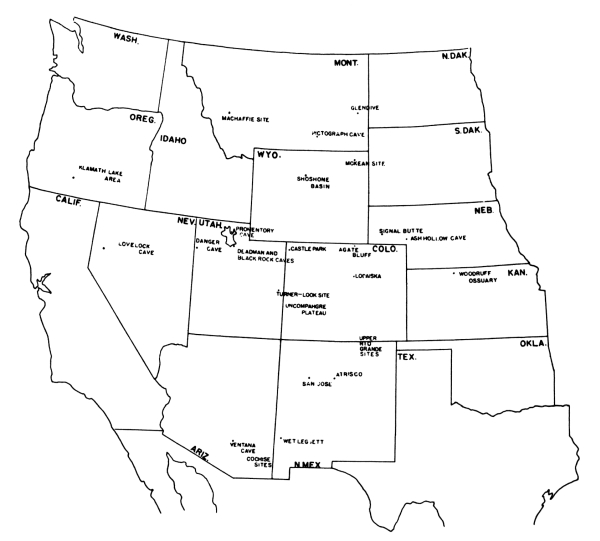
FIGURE 74—
LOCATION OF PRINCIPAL SITES
AND LOCALITIES
REFERRED TO IN THE TEXT.
[Pg 132] People of this complex appear to have been rather skilled in stone working. Chipped projectile points are usually executed with care, often achieving slender finely flaked forms. It is interesting to note that stone scrapers were apparently little used by Fremont people. Perhaps hides were prepared in other ways. Baskets were undoubtedly made and were probably important. The awls found can attest either to sewing or basket-making; the long slender awls would have been especially suited for the latter. Tubular beads were made by a process widespread in the West: incising and splitting. Pottery was roughly made and fairly thick, but not more so than some of Wormington’s (average thickness 5 mm.). Pottery of this rougher type is widespread in northern Fremont locales.
Concerning the possible socio-political situation some conjecture can be recorded. First, as Wormington (1955) pointed out, using data from Murdock (1949), “hunting is normally a male activity and it seems probable that agricultural pursuits were left to the women, and the corn plots may have belonged to them. The inheritance of corn plots by women may have served to unite nuclear families into extended families with matrilineal descent and matri-local residence. However, emphasis on hunting and possible warfare would tend to enhance the status of men and descent may have been bilateral or patrilineal.” For Complex A the latter would be especially important if the absence of quantities of pottery indicates less emphasis on agriculture and more on hunting. Certainly, however, the wild foods at both the LoDaisKa Site and in Castle Park show the continued importance of gathering activities usually associated with women.
The culture complex represented between roughly 24 and 53 inches below baseline appears to be a manifestation of the Woodland Culture, Orleans Aspect. The authors excavated several single component sites of this manifestation in the area (Irwin and Irwin, n.d.). The following artifacts, occurring in these sites and also in this depth range at LoDaisKa, appear characteristic of the culture: cordmarked pottery, corner-notched projectile points similar to those in Fig. 75, end scrapers, drills, small ovoid knives, spoke-shaves, awls (splinter or extremely small sliver types), large hafted “knives.” Large projectile types could have been used with a spear-thrower. There are also tubular beads, small stone triangles (possibly gaming pieces), 1 shaft-smoother, handstones and milling slabs. One decayed corn cob was found at 53-57 inches and may belong to the Woodland levels at LoDaisKa. This was a popcorn (see above). Dent corn has been found at other Woodland sites in the Morrison area (Irwin and Irwin, n.d.). Especially characteristic of this occupation was the pottery, small ovoid knives, and sliver awls. [Pg 133]
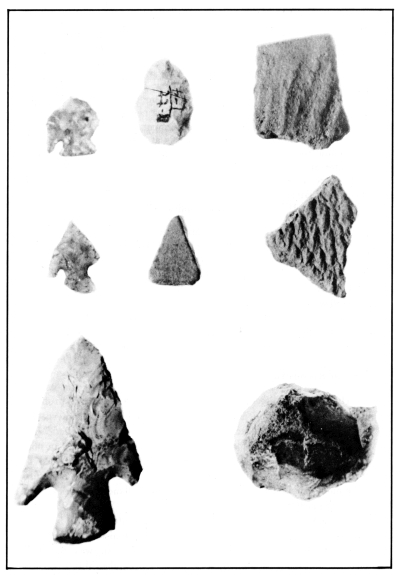
Figure 75—
Artifacts from single component Woodland sites
in the Morrison area. Actual size.
[Pg 134] Establishing a closer affiliation is more difficult. In essence, much of the material resembles that of Ash Hollow focus established in Western Nebraska and Northern Colorado (Kivett, 1952a; Irwin and Irwin, 1957). Specifically, pottery of Class I is similar in composition, cord application, thickness, rim styles, and absence of decoration. However, Class II has several features reminiscent of the Keith focus pottery (Kivett, 1952b) being a thicker ware with a more granular structure. However, the Harlan cord-roughened pottery, assigned by Kivett to the Keith focus, is calcite tempered and has no diagonal cord-marking. Kivett has pointed out that clastics may have been used in areas where calcite does not occur, or more desirable temper is at hand. The absence of side-notched points in Woodland levels at LoDaisKa contrasts with Ash Hollow focus sites where 30% are usually of this variety. This constitutes another similarity to Keith focus sites, such as the Woodruff Ossuary, where such forms do not occur. Class III pottery is not present in Plains Woodland sites. It may be a local variation since it is similar to II in all but cord application.
In connection with this complex, there is a C 14 date for Keith materials of 611 ± 240 A.D. (Wedel and Kivett, 1956). For Ash Hollow Cave tree ring estimates (Champe, 1946) place occupation at 1000-1150 A.D. However, a carbon sample from Woodland materials in the Denver area yielded a date of 800 ± 150 A.D. (Hunt, 1954). Ash Hollow Focus materials appear to share traits with both Valley (Hill and Kivett, 1940, Kivett 1952a, 1952b and Keith Foci). The authors feel the manifestation at Morrison is basically similar to Ash Hollow but with a few more traits in common with the Keith Focus.
The economic life of the people of culture Complex B probably revolved around hunting, limited agriculture, and gathering of specific foods, mainly plums and acorns. Foods were ground on milling slabs with handstones and perhaps, as with the Pawnee, were cooked in pots, or made into cakes fried on a hot slab. Agriculture is indicated by remains of corn at LoDaisKa and at nearby sites of the same culture. In the more classic manifestations of Plains Woodland Culture evidence is slim. Squash remains occurred at Sterns Creek (Strong, 1935) and popcorn at the Lawson Site (Kivett, 1952a). Wedel (1934) felt corn could not grow west of the 99th meridian in prehistoric times. For the Upper Republican Culture an example of corn was found in northern Colorado by the authors, (1957). In the Morrison area several occurrences were noted (see above) in connection with the Woodland Culture. [Pg 135]
Animals hunted were mainly deer and bison, with smaller animals such as prairie dogs, gophers and birds also represented. Perhaps the importance of bison at the site is misrepresented because in dealing with such large animals it is possible that only the meat was brought into camp (for an example of this see Clark, 1952).
Clothing was probably of skin. Numerous scrapers attest to the importance of hide dressing. Tubular beads and a tooth pendant provide evidence of interest in self-ornamentation. Paint stones may have served for pigment. Mixed with grease this could have been used for bodily decoration, though ethnologic parallels suggest other objects were also painted (see above).
A considerable amount of skill in stone working must have been necessary to produce the small delicate projectile points, presumably used with arrows. Some much larger points suggest a continued dependence on the spear or spear-thrower. Drills may have been used to manufacture ornaments or perform more utilitarian functions. Pottery was durable and primarily utilitarian. Variation in pattern was practically non-existent, but the fineness of cord-marking shows some noticeable difference. Bone awls were mostly of the splinter type and rather poorly made. Perhaps baskets were made, but these may not have been too important. Awls could have been used in their manufacture or for sewing.
Concerning the socio-political organization, some inferences can be made. A possible sketch of the “way of life” can be found by examining Pawnee culture as outlined above. Cultivation may have been in small patches worked by women. Hoeing and weeding were probably spasmodic. In view of the absence of bell-shaped storage pits or other such facilities, we can probably infer that crop supplies were consumed in a few seasonal feasts in the characteristic Basin style rather than stored in the Plains manner to conserve for future needs. Despite this, corn plots must have anchored the population to some extent. The presence of pottery suggests a more or less settled way of life. Plains social structure tended to be patrilocal, though there were exceptions. A greater emphasis on hunting, such as was apparently present at LoDaisKa, would increase the chance of such a development.
Despite the fact that the site was fairly small, there is a good deal of evidence of Plains Woodland Culture in the area, and we can assume some kind of inter-component interaction.
Cultural Complex C occurs primarily between the depths of 50 to 72 inches below baseline. The definition is based on the occurrence of a cluster of traits similar to those found in a previously defined unmixed [Pg 136] culture. A certain amount of the apparent overlap is due to the telescoped nature of the stratigraphy, which aggravates the effects of trampling and other disturbances. It is not possible on the basis of the available evidence to determine the relationship of Complex C to those traits which are not consistent with the culture. They may represent traits adopted by the C people, or they could be remains of intermittent occupation by other groups, (see above).
The closest affiliation of Complex C is to the lower level of the McKean Site, (Mulloy, 1954a), Signal Butte I, and related sites. The most significant typological similarities occur in the projectile point categories. The most numerous type at the site is the shouldered, concave based point, (24 examples), designated “Duncan” by Wheeler (1952). “Duncan” points are very common at the McKean Site. Somewhat less well represented at the LoDaisKa are the McKean lanceolate types. Though the general similarity to the McKean type material is undeniable, certain differences occur uniformly. Most noticeable is the discrepancy in size, McKean specimens being consistently larger. The largest LoDaisKa examples approximate the smaller or medium-sized McKean points. The small LoDaisKa points are completely out of the range of McKean specimens, but certain of them do resemble types from Signal Butte I, (Strong, 1935). Such differences and similarities may reflect distance and local stylistic variation, functions of the points in different economies, or perhaps chronological difference.
A second trait which was found to be useful in defining Complex C is the end scraper. Though common at all depths above 72 inches, it is almost completely absent below and aids in segregation of the complexes, especially C and D. Many such scrapers were found at McKean and Signal Butte.
The third important trait of technological as well as typological significance is the striking of prismatic flakes, presumably from prepared cores. As in the case of projectile points, most of the examples are smaller than those which occur at McKean. On the other hand, they appear to be more regular with a greater percentage that have trapezoidal sections and roughly parallel sides. Some of these have been worked and utilized as gravers, cutting edges, and possibly scrapers. In this respect they approach, though do not equal, the classic northern prismatic flake assemblages. For example, they approximate the lower part of the size range and the slightly rougher section of the material from Anangula Island, (Laughlin and Marsh, 1954).
The vertical distribution of stone-filled hearths is not confined to the limits of Complex C. However, those features may be related to those at McKean where they are large and well-defined. Grinding stones were also important at both sites. [Pg 137]
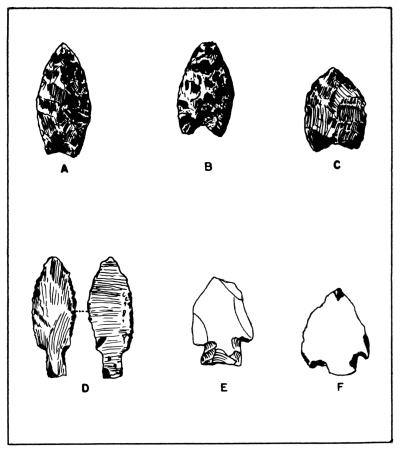
Figure 76— Projectile points from Signal Butte illustrated for comparison. A-C. Signal Butte I, presumably IA. D-F, flake points, presumably IC. A-D, drawn from photostats courtesy of R. Forbis, E-F by R. G. Forbis.
Relations with Signal Butte I are most evident in the projectile point category, especially in the size average. A communication received from R. G. Forbis, to whom we are deeply indebted, indicates that the modal weight of the Signal Butte McKean points is about .56 that of those at the McKean Site. Further, the collections from Signal Butte contain three flake points. One striking example of a flake point in the shape [Pg 138] of a “Duncan” was found at LoDaisKa, (Fig. 15, type A). Other flake points of varying form (listed as xx) occur in Complex C levels. Some of these are not dissimilar to that of Signal Butte I, but Dr. Forbis feels that these may belong to a later phase than the McKean points. The main differences lie in the relative scarcity or perhaps absence of straight stemmed or “Duncan” types at Signal Butte I[9], and the occurrence of flared stemmed varieties or “Hanna” points. The former are numerous at LoDaisKa, the latter absent. There is a good possibility that Signal Butte I should be divided into two or three phases, with McKean points earliest, (Bliss, 1950b, and R. G. Forbis, personal communication).
Relations to other known sites may also be noted. Not only the stemmed and lanceolate points, but side-notched and certain corner-notched types are found in Deadman Cave, Stansbury Island, and Danger Cave (Smith, 1952; Jameson, 1958; Jennings, 1957). The total range, however, differs considerably. There is also some similarity to materials of the earlier levels of Birdshead Cave, (Bliss, 1950a).
The stemmed “Duncan” types have rather wide morphological similarities. As far away as Texas, middle levels of certain sites yield similar materials (Pearce, 1932, pp. 46-47). Pedernales points of the Edwards Plateau Aspect are roughly comparable (Suhm, Krieger, Jelks, 1954, p. 468; Kelley, 1947, 1959). At the other extreme, Thomas Kehoe (1955) reports finding “Duncan-like” points at the Billy Big Springs Site in Montana. Lister (1953) has suggested that a generalized form of indented-based, stemmed point is a horizon marker in the West and Southwest.
A large number of the artifacts that occur with the above are of little diagnostic value. However, some of them are probably associated culturally and formed part of the total artifact inventory. These include: leaf-shaped and triangular knives, end and side scrapers, and discoidal and serrated forms, one expanding base drill, perforators, a few small ovoid bifaces, utilized flakes, chopper/hammerstones, one bone ornament, paint stones, headed and splintered awls, used bone splinters, one bone knife, and one wood shaft.
The economy of the people of Complex C was probably oriented toward a combination of hunting and gathering. The former is evidenced by the presence of animal bones and the frequency of projectile points. The mule deer, Odocoileus hemionus, which represented nearly 75% of the faunal remains, appears to have been the animal most hunted. The projectile points are considered to have been used in connection with atlatls. Stalking and snaring were probably prevalent methods, although [Pg 139] a surround or drive might have been practical in certain seasons when the animals gathered into larger herds. The small number of bison bones indicate that bison were also occasionally hunted. There is a surprising lack of bones of small game, these being even less numerous than in Complex D. Other animals included an undetermined carnivore and some bird bones.
Numerous milling stones and hand stones as well as plant remains attest to the continued importance of vegetable products in the diet. The plants utilized include acorns, sedges, wild plums, chenopods and Umbellifereae. Wads of moss may have been used for padding etc.
There is no information on any structures. Probably none were used since the overhang provided rather good shelter. Large stone-filled hearths may have been used for large scale roasting, as Mulloy (1954a) hypothesized for the McKean Site.
Technologically the Complex C occupants possessed sufficient skill to adapt to the environment with little evidence of elaboration. Clothing was probably scant except for cold weather, and was possibly of skins. In stone work, projectile points were functional, and made rather roughly with little pressure retouch. A proliferation of scraping tools and utilized flakes was probably a by-product of the emphasis on hunting, and suggests that many skins were prepared. A certain amount of technological “know-how” was required to manufacture the relatively fine prismatic flakes. In bone work the commonest tools were awls made on a splinter of bone worked only on the functional end. One bone appears to have been used for flint flaking.
Despite the apparent emphasis on utility there is a certain amount of evidence on the aesthetic side. The people had beads for adornment, made of sections of bird bone. Fragments of hematite and limonite indicate that they also practiced painting of some sort, perhaps on their bodies and tools or hides.
The occurrence of pieces of worked mica may have some magico-religious significance. Similar specimens were found in Danger Cave (Jennings, 1957) and the pieces may indicate Great Basin affiliation. However, the greatest concentration of these is between 50 and 72 inches. These might have been used as charms, or have been part of shamanistic paraphernalia. Other inferences drawn from ethnology would suggest the importance of beliefs connected with hunting.
There is no direct evidence of a socio-political nature. The size of the site and the type economy represented indicate a small semi-nomadic group. The possible overlap in cultural groups suggests either intermittent occupations alternating between groups of different cultural complexes, or the close proximity and strong influence of such groups. In the field of social organization, many modern hunting-gathering groups exhibit bilateral kin organization. On the [Pg 140] other hand the especial importance of large game would render the men’s position of greater consequence, and the affiliation of the material culture is oriented toward the Plains where patrilineal organization is rather common.
The authors believe that the culture (Complex D) represented at LoDaisKa from 55 inches below baseline to the top of the late Wisconsin Alluvium (erosional surface), is a manifestation of the Desert Culture as described by Jennings (Jennings and Norbeck, 1955; Jennings, 1957). This exists in its purest form below 72 inches but there is a persistence of some forms during the beginning of Complex C. Certain types characteristic of the complex continue above 55 inches; they occur, however, in diminishing quantities. There are two possible reasons for this: 1) that the shelter continued to be occupied by people of this affiliation; 2) that the materials worked up by the process of re-use or trampling and mixing of the floor. There is ethnological evidence that different tribes recognized each other’s projectile points and often collected them (Brew, 1946). To avoid confusion we shall treat this culture as it is manifested in its purest form below 72 inches. Where specific shift or other phenomenon does occur between 72-55 inches, it will be noted.
Traits characteristic of this complex are the following: projectile points of various forms, (to be discussed below), triangular knives, especially the second type described above, a few flake knives, side, discoidal, serrated, and a very few end scrapers, Uncompahgre scrapers, drills, perforators, utilized flakes, chopper/hammerstones, paint stones, splinter awls, awls with heads (especially some very large forms), a notched rib, used bone splinters, antler flakers, gaming pieces (undecorated), tubular beads, a tooth pendant, worked mica, wood shafts (large), a limestone pendant, one quartz crystal and one clay ball. Other artifacts found in the level include a few prismatic flakes perhaps fortuitous or intrusive, and above 60 inches a few small projectile points that are, by any criterion (e.g. Fenenga 1953), arrowheads. Typologically these show the greatest resemblance to forms found in Level 3 in Hells Midden (Lister, 1951). However, since there appear to be no allied traits they are felt to be intrusive. At least they provide no proof of the presence of this culture.
We will discuss cultural affinities in terms of projectile points with an eye to establishing possible lines of cultural influence from various geographical areas. We do not suggest that in most cases more than an idea was transmitted.
The Desert Cultures represent, according to Jennings, a “life way”, a specific economic approach to living in a certain environment. Though [Pg 141] the Morrison biome differs in some respects from that of the classic “Desert Cultures”, the nature of the problems faced and the kinds of cultural response invoked are remarkably similar. Typological similarities to Danger Cave materials include a high degree of correspondence between class D projectile points and Jennings’ category W31. This form is also found at Medicine Rock Cave, Oregon (Cressman, 1956, Fig. 41) and Kawumkan Springs Midden (type 7a, Ibid.). It was also present at Deadman Cave, (Smith, 1952) and at Wormington and Lister’s (1956) Uncompahgre sites (Fig. 42 ff). Hurst (1944, 1945) named points of this type Tabeguache points. Points of a rather similar form occur in Ventana Cave in the Chiricahua-Amagosa II level (Haury, 1950) as a minor type, and become more common in the San Pedro materials.
Below we shall compare the LoDaisKa materials of this complex to three archaeological manifestations, since cultural ties seem to be closest with these. These are: Ventana Cave, Danger Cave, and sites of the Uncompahgre Complex, especially the Taylor Site. Reference will be made to other areas for specific items.
The similarities between type D projectile points and class W31 at Danger Cave have already been noted. Other similar forms include Class E forms and W25, 26. Class J may or may not be identified with W18 and W19; since large corner-notched forms are widespread they may not have enough distinctive features to be of value in site correlation. They are also present at Deadman Cave. There are five points (Class G) very similar to W38 (distribution Levels DIII-V at Danger Cave). If W8 and W10 are connected with McKean lanceolate and Duncan forms this is a good correlation point with the overlapping Complex C at LoDaisKa. There is a similarity between W16 and Class C, and W22 resembles Class I forms.
The only important projectile point category of Danger Cave Levels DIII-IV which is lacking at LoDaisKa is the series W28, 29, 30, corner-notched forms with deep basal notches.
In other tool types there is an amazing similarity between the triangular knives of Type I rather characteristic of Complex D at LoDaisKa and Jennings’ W48 and especially W52. Since one of those at LoDaisKa is obsidian, it is conceivable that it was traded from Utah or the surrounding area. At both Danger Cave and LoDaisKa the relative scarcity of end scrapers is noticeable. Other shared traits include flake knives, straight drills, a few gravers, the possible foreshaft from LoDaisKa, splinter awls and “headed” awls (it is interesting to note that DIV types were less well made than LoDaisKa or DIII types). One-hand manos and slab milling stones are found at both localities. However, the peculiar four-plane type does not occur at Danger Cave. [Pg 142] Abrading stones, present at Danger Cave, are not found in Complex D. It is of interest to note that both sites contained worked mica, ochre and paint pigments. Nothing is known concerning basketry at LoDaisKa.
There are numerous similarities between the projectile points of Ventana Cave and those of LoDaisKa. Type H resembles Haury’s expanding stemmed, round tanged, convex based form. These are distributed vertically throughout the levels of both Ventana and LoDaisKa, but are almost entirely absent at Danger Cave. Points of Class C very closely resemble Haury’s expanding stemmed sharp tanged convex based or straight based types. These are the second most numerous type as low as level VI at Ventana. There are some points with oblique tangs that may be related to Class I or J. However, the best marker is Class C2. The first point figured in the group is identical with points of the class loosely termed Pinto Basin. Both this and the second two can be duplicated in Ventana Cave, or at the San Jose Site (Bryan and Toulouse, 1943). Nearer to LoDaisKa, Renaud (1942, 1946) has found similar points in the Upper Rio Grande.
In both LoDaisKa Complex D and Ventana Levels II-III there are triangular, convex-edged blades, side and discoidal scrapers. End scrapers, especially snub-nosed forms are comparatively rare at both sites. There are drills and/or perforators, including what we have termed gravers, choppers, and utilized flakes. Hematite appears together with quartz crystals. Awls are found: both headed and splinter forms are represented. At both sites the former are the most numerous type during the interval under discussion. At LoDaisKa there was no category of “sawed” awls as at Ventana. Rib scrapers or knives are also an interesting feature. There are in addition, tubular beads of bird and mammal bone, and antler flakers. One additional and notable similarity is to be found in handstones. These are all of the one hand variety. Due to a peculiarity of usage, a median line developed creating four grinding planes. This was probably caused in rocking the mano when pushing it forward and then back. Occasionally a specimen is noted where the user had rotated it 90° when reversing it, creating median lines on opposite faces perpendicular to each other. As Haury (1950) pointed out, this phenomenon is a special feature of the Cochise Culture. It occurs at Ventana Cave and in the LoDaisKa Site. Both flat slab milling stones and those with slight basins are found.
A third comparison can be made with the nearby Uncompahgre Complex (Wormington and Lister, 1956). Similarities to Danger Cave, sites of the Middle Horizon of the Plains and to the Cochise Culture are reflected in the Uncompahgre Complex, as summarized by the authors. Certain forms of projectile points, especially the type called Tabeguache by Hurst, are found in the Taylor Site in levels 4, 8, and [Pg 143] 10. Another similar form is the round based, round barbed type (Class II), also found in Ventana Cave. There are certain small points from these levels, possibly arrowheads, which bear resemblance to projectile points of levels 1-3 at the Taylor Site, and forms of Level 2 at Hells Midden.
Generally asymmetrical large ovoid bifaces or knives are common in the Uncompahgre Complex, as they are here. The stemmed drills, straight drills, gravers, and perforators of the general class that we have called awls, are common in both the Uncompahgre and Complex D. There are other similarities in serrated scrapers, and the rarity of end scrapers. A triangular notched pendant found at LoDaisKa is probably analogous to certain flat pieces of soft stone that were used as ornaments on the Plateau. The four-planed manos noted above are also found here. An interesting artifact, the Uncompahgre scraper, was first described by Wormington and Lister in their report. Such pieces also occur at LoDaisKa. Whether they occur elsewhere is not known, since it is possible they were present in other areas but have not been recognized. At the Taylor Site there were storage pits as at LoDaisKa. One notable discrepancy is the lack of awls with heads at sites of the Uncompahgre Complex.
Before closing this discussion, we should take note of a possible broader relationship of Complex D, that is within the continent-wide framework of an Archaic horizon. While we have limited specific correlation to Desert cultures, other similarities do exist in total tool assemblage and specific point types with a number of Eastern Archaic sites, such as Modoc Rock Shelter (Fowler, 1959). Jennings (1957) has admirably summarized the relations of manifestations of the Desert cultures with sites of the Eastern Archaic, and further inquiry should be made in this direction. Perhaps when Archaic sites between LoDaisKa and the Mississippi are discovered, a gradual blending of Eastern Archaic-Desert Culture will be noted. A recent publication for Oklahoma by R. Bell (1958) gives hope in this regard. Since corn was present at Bat Cave (Dick, 1952), a site with certain Chiricahua Cochise affinities, it is not unreasonable to assume corn diffused to LoDaisKa from New Mexico or Arizona.
There can be little doubt that the people of Complex D led a life similar to that described by Jennings for the Desert Cultures. The term “Desert” is a little misleading, since the Morrison Biome is not in any sense of the word a desert. However, the vegetation is of the Sonoran type, a type with great variation characterized by fairly low rainfall, [Pg 144] scrubby bushes and few trees. The proximity of the mountain forest biome supporting deer and other large animals, probably led the people to greater dependence on these at the expense of small game. This hypothesis is supported by the faunal charts. The multitude of grinding stones, and the presence of edible floral remains attest to the continued importance of gathering. Another factor is present, for floral remains and the pollen record indicate the presence of maize in early times at LoDaisKa. At another site in southwestern New Mexico, Bat Cave (Dick, n.d.) was recorded one of the earliest occurrences of maize in North America. At Bat Cave preservation was better than at LoDaisKa and a more complete record was found. There is a clear resemblance between certain projectile points of Bat Cave (e.g. Datil points) and Chiricahua and Ventana forms, and those of LoDaisKa mentioned above. Perhaps maize was grown by the people of Ventana Cave also. It remains to be seen, however, how much difference the cultivation of small amounts of corn made in social and economic life. We are inclined to agree with Willey and Phillips (1958), who suggest that it was indeed little. In their hunting and gathering activities these people must have lived a life very similar to that of the Ute, outlined above. For theoretical considerations, the light shed on prehistoric life by these primitive cultures of the historic period cannot be overemphasized. The characters are different, but all the evidence suggests that the play was much the same with only minor variations.
Cists from Complex D suggest that seeds and perhaps corn were stored. Fire areas are sometimes large and deep. Perhaps these were traditional cooking areas. The many rocks scattered in the pits suggest that stone boiling or baking was practiced, and flat slabs may have been used for cooking cakes. Food was ground on basin or flat metates with one-hand manos. Lowie (1924) cites ethnological evidence for the use of different kinds of grinding stones for different foods in the Great Basin cultures. Perhaps a similar custom gave rise to the peculiar four-plane and ordinary type manos in equal proportions at LoDaisKa. Hunting methods included the use of the atlatl, or spear-thrower, and possibly, though no evidence is at hand, snares. Perhaps the use of bolas is recorded by the clay ball described above. Long bone awls suggest that basketry was important.
In technology the people had rather well formed projectile points. The flaking technique employed was probably largely percussion supplemented by pressure. In general, tools were smaller than those from other sites that exhibit typological parallels. This could have been partly due to ecologic conditions or perhaps to a scarcity of stone. Wide use of rough quartz and metamorphic rock suggest that the latter factor was [Pg 145] operative. Obsidian was obtained through trade or visits to other areas. For sources of obsidian, one must look either to the vulcanism of northern Wyoming, Southwestern Colorado, New Mexico or Utah. Peoples occupying other sites of this time period also appear to have engaged in trade (see Jennings, 1957; Haury, 1950).
Bone was widely used for scraping, cutting and piercing. The exact method of cutting bone is not known; but there are gravers and utilized flakes that could have been used.
Ornaments suggest that interest in self adornment was not lacking. Hematite and ochre indicate that there was some use of paints and pigments. A piece of chlorite was found that, if ground and mixed with grease, could have made a spectacular kind of paint. Worked mica again may have had ornamental or ceremonial uses.
In the magico-religious field, one can probably infer some of the religious practices of the Basin hunters and gatherers, from those of the recent Ute. An interesting feature is the occurrence of a rather large, well formed, smokey colored quartz crystal. Perhaps as Haury suggested (1950), such crystals were picked up for beauty, but another possibility is that they were a part of a shaman’s paraphernalia. Certain California and Louisiana Archaic sites contain many of these, and they are assumed to have had some sort of magico-religious function. It would be surprising not to find at least a part time shaman in such a culture, although regalia such as sucking tubes are lacking.
Conjectures concerning social organization can be briefly set forth. It is probable that the people had a more or less bilateral form of kinship. As Murdock (1949) and others have noted, where economic division of labor is nearly even, a more or less bilateral organization tends to develop, with at most only mild matri-or patrilineality. From ethnologic parallels for Basin peoples this seems plausible. But use of ethnological evidence for single traits at this chronological level is extra-hazardous. What effect the little agriculture practised had is a moot question. As we have pointed out concerning the people of Complex A, small plots of corn would have required at least semi-annual gatherings, and would have temporarily placed the society on a relatively stable footing. Possibly the proceeds of a harvest were used for a gala feast or ceremony. However, the presence of cache pits suggests that something at least was stored.
Two oblong pieces of bone which appear to have been gaming pieces suggest that gambling existed as a form of recreation. Certainly, as Steward (1940) has noted, gaming was a constant feature of Basin cultures.
Just within sands and gravels attributed by Hunt to Late or Post-Wisconsin outwash, one fragmentary point and a few flakes were [Pg 146] found. Some charcoal, ash and burned bone occurred at the same level, extending in a lens about 2 inches lower. The point appears to the authors to be the basal section of what might be called morphologically a Plainview point (Krieger, in Sellards, Evans and Meade, 1947). Flaking was parallel. Another parallel-flaked point of a similar type was found higher up in the fill, and was undoubtedly a re-used piece (see Fig. 25). Both points are of quartzite, and both have ground edges. Five of the associated flakes were of a flinty material, 2 of grainy quartzite.
These artifacts probably represent a culture of the early Lithic Stage in the area, and are perhaps the earliest evidence of its occupation. The fill was so sparse, however, that no further evidence could be obtained.
Willey and Phillips (1958) have stated that traditions are culture elements extending over long periods of time and often transgressing various culture boundaries present in an area. Traditions are not horizon-markers but may serve to unify a given series of occupations in a locality (e.g. painted pottery is a tradition in the Southwest.)
At LoDaisKa there are few such distinctive elements that transgress cultural periods other than rather common functional tools such as scrapers, but these few may be worth noting. One of these concerns a special type of handstone with four working planes as described above. These are present from complex A through D. Another tradition concerns the use of local stone. In general finer flinty types were used for knives, gravers and some types of scrapers, while grainy quartzite was most often used for projectile points. Distance from sources probably influenced the use of flinty types. The nearest quarry area appears to be about fifteen miles away; beds of quartzite are found somewhat closer. It is probable that access to both supplies led the people to use flinty type where a good cutting edge was important, but grainy varieties for tipping weapons. The grainy structure of quartzite makes it break less cleanly on the edges but renders it less likely to snap on sudden impact.
Another tradition lies in the use of small points. Many of the projectile point forms may be identical in general characteristics with points from other areas which are apparently culturally connected, but they are consistently a little smaller. Perhaps such a phenomenon was a by-product of the scarcity of material. In this connection one should note that in all the cultures common native rock quartz was almost [Pg 147] invariably employed for large chopping tools. Another point of interest is the almost total absence of cores. Raw material when found was usually in the form of large flat flakes. The initial roughing out must have taken place at the source.
Another tradition is the use of mica for “ornaments” extending from Complex B through D. A tradition for the area was the cultivation from early times of a certain amount of corn, as revealed by pollen analysis and a few specimens of seeds or cobs. However, the type of corn used was not the same throughout. Three major varieties were present.
There are two explanations for these local traditions: either a tradition was handed down from one cultural group to another through long periods of time, or the peculiar ecological position of the Morrison biome dictated such a course. Probably the answer lies in the combination of these; certainly for stone use the environment was an important factor, but for the handstone type, the environmental explanation does not seem entirely adequate.
Placed in a larger context, the sequence at LoDaisKa seems to reflect the interaction of geographical, cultural and environmental factors. Their relation poses a series of interesting questions.
The region is located geographically on the fringe between two well-known culture areas, the Great Basin and the Plains. At the same time, it is environmentally distinct from either, combining some characteristics of each, while preserving its own sub-montane biome. These factors determine the essentially marginal character of the area. For the same reasons, it should be especially sensitive to the forces of cultural dynamics and to changes in environment.
The sequence at the LoDaisKa Site reflects this situation. The shifting orientation of the cultures represented alternates between the Plains and Basin. This shifting may be an essentially cultural phenomenon, possibly reflecting events in the nuclear culture areas. Alternatively, there may be evidence of climatic fluctuation at the site, and environmental change could have been an important factor.
It remains a question whether this was, at least briefly, a contact area for Plains and Basin cultures. From the available material it is not possible to determine whether groups of divergent affiliation ever inhabited the area synchronously. The considerable overlapping of the culture units seems to point in this direction; but, as indicated above, this phenomenon may be partially due to the telescoping of the stratigraphy. This plus certain traditional continuums provide possible evidence of the influence of these groups on each other. [Pg 148]
Further research may provide answers for some of these questions. Accurate dating by Carbon 14 will of course be invaluable in setting the LoDaisKa sequence in proper relation to known Recent developments in the West. Continued paleobotanical and geological study will help clarify the chronological and environmental situation. Investigation of single component sites in the area should provide a concrete regional sequence and supply more data on the kind of cultural phenomena represented here.
This suggests a few of the problems to be solved and indicates the great amount of research which remains to be done.
[Pg 149]
ANDERSON, E.
1948 Racial Identity of the Corn from Castle Park. In Burgh and Scoggin, the Archaeology of Castle Park Dinosaur National Monument. Univ. of Colorado Series in Anthropology, No. 2. Boulder.
1954 Personal communication in Wormington. A Reappraisal of the Fremont Culture. Denver Museum of Natural History Proceedings, No. 1. Denver.
ANTEVS, E.
1955 Geologic-climatic Dating in the West. American Antiquity, Vol. 20, No. 4, Part 1, pp. 3, 17, 35. Salt Lake City.
BARBER, E. A.
1876 Language and Utensils of the Utes. Bulletin, U. S. Geologic and Geographic Survey of the Territories. Vol. 11, No. 3. Washington.
BARGHOORN, E. S., M. K. WOLFE, and K. H. CLISBY
1954 Fossil Maize from the Valley of Mexico. Bot. Mus. Leaflet Harvard Univ. 16, pp. 229-264. Cambridge.
BEALS, R.
1935 Ethnology of the Rocky Mountain National Park, the Ute and Arapaho. National Park Service, Berkeley.
BELL, R. E.
1958 Guide to the Identification of Certain American Indian Projectile Points. Oklahoma Anthropological Society, Special Bulletin No. 1. Oklahoma City.
BLISS, WESLEY
1950a Birdshead Cave, a Stratified Site in Wind River Basin, Wyoming. American Antiquity, Vol. 15, No. 3, pp. 187-96. Menasha.
1950b Early and Late Lithic Horizons in the Plains Anthropological Papers. University of Utah, No. 11, Salt Lake City.
BREW, J. O.
1946 Archaeology of Alkalai Ridge, Southwestern Utah. Peabody Museum Papers, Vol. XXI. Cambridge.
BROECKER, W. S. and J. L. KULP
1956 The Radio Carbon Method of Age Determination. American Antiquity, Vol. 22, No. 1, pp. 1-11. Salt Lake City.
BRYAN, K., and J. TOULOUSE
1943 The San Jose Non-Ceramic Culture and its Relation to a Puebloan Culture in New Mexico. American Antiquity, Vol. 8, No. 3, pp. 269-80. Menasha.
BURGH, R. and C. SCOGGIN
1948 Archaeology of Castle Park, Dinosaur National Monument, University of Colorado Series in Anthropology, No. 2. Boulder.
CARTER, G.
1945 Plant Geography and Culture History in the American Southwest, Viking Fund Publications in Anthropology, No. 5. New York.
CARY, MERRIT
1911 Biological Survey of Colorado. Biological Survey Bureau, North American Fauna. Washington.
CHAMBERLAIN, R. V.
1911 The Ethnobotany of the Gosiute Indians. American Anthropologist. Memoir 2, Part 5. Menasha. [Pg 150]
CHAMPE, J.
1946 Ash Hollow Cave, A Study of Stratigraphic Sequence in the Central Plains. University of Nebraska Studies, No. 1. Lincoln.
CLARK, J. D. C.
1952 Star Carr, A Mesolithic Site. Cambridge University Press. Cambridge.
1957 Archaeology and Society, Harvard University Press. Cambridge.
COON, C. S.
1950 A Reader in General Anthropology. New York.
CRESSMAN, L. S.
1942 Archaeological Researches in the Northern Great Basin. Carnegie Institution of Washington Publication No. 538. Washington.
1956 Klamath Prehistory. Transactions of the American Philosophical Society, New Series, Vol. 46, Part 4. Philadelphia.
DANIELS, H. S.
1941 The Ute Indians of Southwestern Colorado. Durango Public Library Museum. Durango.
DAUGHERTY, R. D.
1956 Early Man in the Columbia Intermontane Province. University of Utah Anthropological Papers, No. 24. Salt Lake City.
DAVIS, E. M.
1956 Archaeological Survey of the Big Sandy Reservoir Area, Southwestern Wyoming. Notebook No. 2, Laboratory of Anthropology, University of Nebraska. Lincoln.
DICK, H. W.
n.d. Archaeology of Bat Cave. Ph.D. Dissertation, Harvard University (manuscript). (Cambridge.)
1952 Evidences of Early Man in Bat Cave and on the Plains of San Augustine, New Mexico. In Selected Papers of the 29th International Congress of Americanists, pp. 158-63. Chicago.
DOUGLAS, F. H. and J. JEANCON
1930 The Ute Indians. Leaflet No. 10, Denver Art Museum. Denver.
DUNBAR, J. B.
1880 The Pawnee Indians, Their History and Ethnography. Magazine of American History, Vol. 4, No. 4, pp. 241-281.
FENENGA, F.
1953 The Weights of Chipped Stone Points: A Clue to Their Functions. Southwestern Journal of Anthropology, Vol. 9, No. 3, pp. 309-323. Albuquerque.
FENNEMAN, N. M.
1931 Physiography of Western United States. McGraw-Hill. New York.
FLINT, R. F.
1957 Glacial Geology of the Pleistocene Epoch. Wiley and Sons. New York.
FORBES, LITTON
1882 Les Utes du Colorado. Bulletin de La Societé D’ anthropologie (L.C.) de Paris. Tome cinquieme, troisieme serié. Paris.
FORBIS, R. G.
1959 Personal communication.
FORBIS, R. G., and J. SPERRY
1952. An Early Man Site in Montana. American Antiquity, Vol. 18, No. 2, pp. 127-33. Salt Lake City. [Pg 151]
FOWLER, MELVIN L.
1959 Modoc Rock Shelter: An Early Archaic Site in Southern Illinois. American Antiquity, Vol. XXIV, No. 3, pp. 257-270.
GALINAT, W. C.
1958 Maize Genetics Cooperation—News Letter, No. 32 for March 15, 1958.
GIFFORD, E. W.
1940 Apache-Pueblo, Culture Element Distribution IV, Anthropological Records. Berkeley.
GILMORE, M. R.
1913 The Aboriginal Geography of the Nebraska Country. Mississippi Historical Association, Vol. 6, pp. 317-31.
1919 Uses of Plants by the Indians of the Missouri-River Region. 33rd Annual Report, Bureau of American Ethnology. Washington.
GRASS, P.
1904 Grass’s Journal of the Lewis and Clarke Expedition (reported from the 1811 edition. J. K. Hosmer, ed.) A. C. McClury and Co. Chicago.
GRIFFIN, J. B.
1953 Archaeology of the Eastern United States. University of Chicago Press. Chicago.
GRINNELL, G. B.
1912 Pawnee Hero Stories and Folk Tales. New York.
GUNNERSON, J.
1954 Fremont Ceramics. In Papers of the Third Great Basin Archaeological Conference. Utah University Anthropological Papers, No. 22. Salt Lake City.
1956 Plains-Promontory Relationships. American Antiquity, Vol. 22, No. 1, pp. 69-72. Salt Lake City.
HARRINGTON, H. D.
1954 Manual of the Plants of Colorado. Sage Books. Denver.
HAURY, E. W.
1950 The Stratigraphy and Archaeology of Ventana Cave, Arizona. University of Arizona, University of New Mexico Presses. Tucson and Albuquerque.
HEIZER, H. F.
1958 Guide to Archaeological Field Methods. Third Revised Edition, National Press. Palo Alto.
HEWES, GORDON W.
1952 California Flicker-Quill Headbands in the Light of an Ancient Colorado Cave Specimen. American Antiquity, Vol. 18, No. 2, pp. 147-54. Salt Lake City.
HILL, A. T. and M. F. KIVETT
1940 Woodland-like Manifestations in Nebraska. Nebraska History, Vol. XXI, No. 3, pp. 146-243.
HUNT, C. B.
1954 Pleistocene and Recent Deposits in the Denver Area. Colorado Geological Survey Bulletin, 996-C. Washington.
1955 Geology of the Taylor Site. In Wormington and Lister, 1956, op. cit.
HURST, C. T.
1944 Excavation in Cave II, Tabeguache Canyon, Montrose County, Colorado, 1943. Southwestern Lore, Vol. 10, No. 1, pp. 2-14, Gunnison.
1945 Completion of Excavation of Tabeguache Cave No. II. Southwestern Lore, Vol. 11, No. 1, pp. 7-12. Gunnison. [Pg 152]
HURST, C. T., and E. ANDERSON
1949 A Corn Cache from Western Colorado. Am. Antiq., Vol. XIV, No. 3, pp. 161-167.
HYDE, G. E.
1951 Pawnee Indians. University of Denver Press. Denver.
IRVING, J. T.
1835 Indian Sketches, Taken During an Expedition to the Pawnee Tribes. Carey, Lea and Blanchard. Philadelphia.
IRWIN, C., and H. IRWIN
1957 Archaeology of the Agate Bluff Area. Plains Anthropologist, No. 8. Lincoln.
n.d. Woodland Cultures of the Denver Area.
JAMES, E.
1932 The Archaeology of East Texas. American Anthropologist, N. S., Vol. 34, pp. 607-687. Menasha.
JAMESON, SYDNEY J. S.
1958 Archaeological Notes on Stansbury Island. University of Utah Press. Salt Lake City.
JENNINGS, J. D.
1957 Danger Cave. Memoirs of the Society for American Antiquity, No. 14. Salt Lake City.
JENNINGS, J. D. and E. NORBECK
1955 Great Basin Prehistory: A Review. American Antiquity, Vol. 21, No. 1, pp. 1-11. Salt Lake City.
KEHOE, T.
1955 (Billy Big Springs Site). In Museum Notes and News, Museum of the Plains Indian. Browning.
KELLEY, J. C.
1947 The Cultural Affiliations and Chronologic Position of the Clear Fork Focus. American Antiquity, Vol. 13, No. 2, pp. 97-109. Menasha.
1959 The Desert Cultures and the Balcones Phase: Archaic Manifestations in the Southwest and Texas. American Antiquity, Vol. XXIV, No. 3. Salt Lake City.
KELLEY, J. C., T. N. CAMPBELL, and D. J. LEHMER
1940 The Association of Archaeological Material with Geological Deposits in the Big Bend Region of Texas. Bulletin Sul Ross Teachers College. Vol. XXI, No. 3. Alpine.
KIDDER, A. V.
1932 The Artifacts of Pecos. R. S. Peabody Foundation Papers, Yale University Press. New Haven.
KIDDER, A. V., and S. J. GUERNSEY
1931 Archaeological Exploration in Northeastern Arizona. Bureau of American Ethnology, Bulletin 65. Washington.
KIVETT, M. F.
1952a Woodland Sites in Nebraska. Nebraska State Historical Society Publications in Anthropology, No. 1. Lincoln.
1952b The Woodruff Ossuary, a Prehistoric Burial Site in Phillips County, Kansas. River Basin Survey Papers, No. 3 Bureau of American Ethnology, Smithsonian Bulletin 154. Washington.
KLUCKHOHN, C. K.
1939 The Place of Theory in Anthropological Studies. Philosophy of Science, Vol. 6, No. 3, pp. 328-344. [Pg 153]
KRIEGER, A. D.
1944 The Typological Concept. American Antiquity, Vol. 9, No. 3, pp. 271-88. Menasha.
KROEBER, A. L.
1910 Notes on the Ute Language. American Anthropologist, N. S., Vol. X. pp. 74-87. Lancaster.
1939 Cultural and Natural Areas of Native North America. University of California Publications in American Archaeology and Ethnology, Vol. 38. Berkeley.
1953 (ed.) Anthropology Today: an Encyclopedic Inventory.
LAUGHLIN, W. S. and GORDON H. MARSH
1954 The Lamellar Flake Manufacturing Site on Anangula Island, in the Aleutians. American Antiquity, Vol. XX, No. 1, pp. 27-39. Salt Lake City.
LESSER, A.
1933 The Pawnee Ghost Dance. Hand Game. Columbia University Contributions to Anthropology, No. XVI, pp. 1-337. New York.
LINTON, RALPH
1922a The Thunder Ceremony of the Pawnee. Field Museum Papers, Leaflet No. 5. Chicago.
1922b The Sacrifice of the Morning Star by the Skidh Pawnee. Field Museum Papers, Leaflet No. 6. Chicago.
LISTER, R. H.
1951 Excavations at Hells Midden, Dinosaur National Monument. University of Colorado Studies, Series in Anthropology, No. 3. Boulder.
1953. The Stemmed Indented Base Point, a Possible Horizon Marker. American Antiquity, Vol. 18, No. 3, pp. 264-5. Salt Lake City.
LOUD, L. L. and M. R. HARRINGTON
1929 Lovelock Cave. University of California Publications in American Archaeology and Ethnology, Vol. 25. Berkeley.
LOWIE, R. H.
1924 Notes on Shoshonean Ethnography. Anthropological Papers of the American Museum of Natural History. Vol. XX, Part II. New York.
MacWHITE, EOIN
1956 On the Interpretation of Archaeological Evidence in Historical and Sociologist Terms. American Anthropologist, Vol. 58, No. 1, pp. 2-26. Menasha.
MALOUF, CARLING
1940 Prehistoric Exchange in the Northern Periphery of the Southwest. American Antiquity, Vol. 16, No. 2, pp. 115-122. Salt Lake City.
MANGELSDORF, P. C. and R. G. REEVES
1939 The origin of Indian Corn and its relatives. Texas Agricultural Experiment Station, Bulletin 574.
MANGELSDORF, P. C. and C. E. SMITH, JR.
1949 New Archaeological Evidence on Evolution in Maize. Bot. Mus. Leaflet. Harvard University 13: 213 247. Cambridge.
MANGELSDORF, P. C. and R. H. LISTER
1956 Archaeological Evidence on the Evolution of Maize in Northwestern Mexico. Bot. Mus. Leaflet, Harvard University 17: 151 178. Cambridge.
MANGELSDORF, P. C.
1959 Personal Communication. [Pg 154]
MARTIN, P. J. B., E. BLOEHM, HUGH C. CUTLER, R. GRANGE, JR.
1952 Mogollon Cultural Continuity and Change: The Stratigraphic Analysis of Tularosa and Cordova Caves. Fieldiana: Anthropology, Vol. 40. Chicago Natural History Museum. Chicago.
MASON, J. A.
1940 Myths of the Uintah Utes. Journal of American Folklore, Vol. XXIII, No. LXXXIX.
MORRIS, E. and R. BURGH
1954 Basketmaker II Sites Near Durango, Colorado. Carnegie Institution of Washington, Publication 604. Washington.
MORSS, NOEL
1931 The Ancient Culture of the Fremont River in Utah. Peabody Museum Papers, Vol. 12, No. 3. Cambridge.
MULLOY, W.
1952 The Northern Plains. In Archaeology of the Eastern United States. Edited by J. B. Griffin, pp. 124-380. Chicago.
1954a The McKean Site in Northeastern Wyoming. Southwestern Journal of Anthropology, Vol. 10, No. 4, pp. 432-460. Albuquerque.
1954b Archaeological Investigations in the Shoshone Basin, University of Wyoming Publications, Vol. 16, No. 1, pp. 1-70. Laramie.
MURDOCK, G. P.
1949 Social Structure. Macmillin, New York.
NICKERSON, N. H.
1953 Variation in Corn Cob Morphology Among Certain Archaeological and Ethnological Races of Maize. Ann. Missouri Bot. Garden, No. 40, pp. 79-111. St. Louis.
1954 Personal Communication in Wormington, A Reappraisal of the Fremont Culture. Denver Museum of Natural History Proceedings, No. 1. Denver.
OPLER, M. K.
1939 Southern Ute Pottery Types. The Master Key, Vol. XIII, No. 1, pp. 161-63. Southwest Museum, Los Angeles.
1941 The Southern Utes of Colorado. In Linton, R. (ed.), Acculturation in Seven American Indian Tribes, pp. 119-203. New York.
PALMER, E. G.
1866-1877 The Utah Utes, ed. by R. Heizer. Utah University Anthropological Papers, No. 17. Salt Lake City.
PEARCE, J. E.
1932 The Present Status of Texas Archeology. Bull. of the Texas Archeological and Paleontological Society, Vol. 4, pp. 44-54. Austin.
POWELL, J. W.
1875 Exploration of the Colorado River. Smithsonian Institution, Washington.
RENAUD, E. B.
1931 Archaeological Survey of Eastern Colorado. University of Denver. Denver.
1932 Archaeological Survey of Eastern Colorado, Second Report. University of Denver. Denver.
1942 Reconnaissance in the Upper Rio Grande Valley, Colorado and Northern New Mexico. University of Denver Archaeological Series, No. 3. Denver.
1946 Archaeology of the Upper Rio Grande Basin in Southern Colorado and Northern New Mexico. University of Denver, Archaeological Series, No. 5. Denver. [Pg 155]
ROCKWELL, WILSON
1956 The Utes—A Forgotten People. Sage Books. Denver.
SAPIR, E.
1931 Southern Paiute. American Academy of Arts and Sciences. Boston.
SAYLES, E. B. and E. ANTEVS
1941 The Cochise Culture. Medallion Papers, No. 29, Gila Pueblo, Globe.
SCHROEDER, A. H.
1953 Statement on the Early History and Archaeology of the Gunnison River Basin. Southwestern Lore, Vol. XIX. No. 3, pp. 3-11. Boulder.
SELLARDS, E. H., GLEN L. EVANS and GRAYSON MEADE
1947 Fossil Bison and Associated Artifacts from Plainview, Texas, with Description of Artifacts by Alex D. Krieger. Bulletin Geological Society of America, Vol. 58, pp. 927-954.
SHAPIRO, MEYER
1954 Styles. In Kroeber, 1953, op. cit.
SMITH, E. R.
1952 Archaeology of Deadman Cave; A Revision. University of Utah Anthropological Papers, No. 10. Salt Lake City.
STEWARD, J. H.
1937 Ancient Caves of the Great Salt Lake Region. Bureau of American Ethnology, Bulletin 116. Washington.
1938 Basin-Plateau Aboriginal Socio-political Groups. Bureau of American Ethnology, Bulletin 120. Washington.
1940 Native Cultures of the Intermontane (Great Basin) Area. Smithsonian Miscellaneous Collections, Vol. 100, pp. 445-503. Washington.
STEWART, O. C.
1942 Ute—Southern Paiute, Culture Element Distribution, VI Anthropological Records. Berkeley.
1957 Shoshonean Indians. The Encyclopedia Americana, pp. 754-55. New York.
STRONG, W. D.
1935 An Introduction to Nebraska Archaeology, Smithsonian Miscellaneous Collections, Vol. 93, No. 10. Washington.
SUHM, D. A., A. D. KRIEGER and E. B. JELKS
1954 An Introductory Handbook of Texas Archaeology. Bulletin Texas Archaeological Society, Vol. 25. Austin.
TAYLOR, D. C.
1957 Two Fremont Sites and Their Position in Southwestern Prehistory. Utah University Anthropological Papers, No. 29, Salt Lake City.
TAYLOR, W. W.
1943 A Study of Archaeology. American Anthropological Association Memoir No. 69. Menasha.
TRAIN, P., J. R. HENRICKS, W. A. ARCHER
1941 Medicinal Uses of Plants. Bureau of Plant Industry, U. S. Department of Agriculture. Washington.
UNDERHILL, RUTH M.
1953 Red Man’s America. University of Chicago Press. Chicago. 1958 Personal Communication.
VESTAL, P. A.
1940 Notes on a Collection of Plants from the Hopi Indian Region of Arizona. Botanical Leaflets, Harvard University, Vol. 8, No. 8. Cambridge. [Pg 156]
VESTAL, P. A.
1952 Ethnobotany of the Ramah Navajo. Peabody Museum Papers, Vol. 40, No. 4. Cambridge.
WARREN, E. R.
1942 Mammals of Colorado. Kansas University Publications.
WEDEL, W. R.
1934 Contributions to the Archaeology of the Upper Republican Valley, Nebraska. Nebraska Historical Magazine, Vol. XV, pp. 132-290. Lincoln.
1938 The Direct-Historical Approach in Pawnee Archaeology. Smithsonian Miscellaneous Collections, Vol. 97, No. 3, Washington.
1941 Environment and Native Subsistence Ecology in the Central Great Plains. Smithsonian Miscellaneous Collections, Vol. 101, No. 3. Washington.
WEDEL, W. R. and M. F. KIVETT
1956 Additional Data on the Woodruff Ossuary, Kansas. American Antiquity. Vol. 21, No. 4, pp. 414-416. Salt Lake City.
WELLHAUSEN, E. S., L. M. ROBERTS and E. HERNANDEZ X.
in collaboration with P. C. MANGELSDORF.
1952 Races of Maize in Mexico. The Bussey Institution of Harvard University. Cambridge.
WHEELER, R. P.
1952. A Note on the “McKean” Lanceolate Point. Plains Archaeological Conference News Letter, Vol. 4, No. 4, pp. 45-50. Lincoln.
1957 Duncan and Hanna Points. Plains Anthropologist, No. 1, pp. 7-14. Lincoln.
WHITING, A. F.
1939 Ethnobotany of the Hopi. Museum of Northern Arizona, Bulletin No. 15. Flagstaff.
WILLEY G. R. and PHILLIP PHILLIPS
1958 Method and Theory in American Archaeology. University of Chicago Press. Chicago.
WORMINGTON, H. M.
1955 A Reappraisal of the Fremont Culture. Proceedings, No. 1, Denver Museum of Natural History. Denver.
1957 Ancient Man in North America. Fourth Revised Edition. Popular Series, No. 4, Denver Museum of Natural History. Denver.
WORMINGTON, H. M. and R. H. LISTER
1956 Archaeological Investigations on the Uncompahgre Plateau in West Central Colorado. Proceedings No. 2, Denver Museum of Natural History. Denver.
ZINGG, H. M.
1939 The Ute Indians in Historical Relation to Proto-Azteco-Tanoan Culture. University of Denver Contributions to Ethnography, No. 2. Denver.
Footnotes:
[1] No available temperature or snowfall records for Morrison. Morrison lies about 18 miles west of the Denver Record station and is slightly higher. Temperatures do not differ appreciably from Denver. Data was collected in 1941-1956 for Morrison, 1905-1957 for Denver.
[2] Publication authorized by the Director, U. S. Geological Survey.
[3] Publication authorized by the Director, U. S. Geological Survey.
[4] Apart from the fact that this specimen may represent Bison bison rather than ?Bos taurus, the possibility exists that it is an accidental, late Recent association introduced by outside agency, as would be the case in a burial by a carnivore or man.
[5] Hunt, Chas. B., 1954, Pleistocene and Recent Deposits in the Denver Area, Colorado: U.S. Geol. Survey Bull. 996-C, p. 91-140.
[6] Scott, Glenn R., Geology of the Kassler Quadrangle, Colorado; manuscript in preparation.
[7] Hunt, Chas. B., Geology of the LoDaisKa site, p. 89, present publication.
[8] Reprinted with the author’s permission from Maize Genetics Cooperation—News Letter, No. 32 for March 15, 1958.
[9] American Journal of Science, Vol. 257, No. 1, Jan. ’59, p. 21 “Lamont Natural Radiocarbon Measurements V.” Dates are now available for Signal Butte, Ia: L 385 B, 4550±220 years and Signal Butte Ic: L 385 D, 4170±250 years. However, they may suggest that there is little time lapse between the cultures of Signal Butte I.
Transcriber’s Notes:
The illustrations have been moved so that they do not break up paragraphs and so that they are next to the text they illustrate.
Typographical and punctuation errors have been silently corrected.
Many of the captions for the figures have expressions like “"Actual size, 2x Actual size, ½ Actual size”, etc. These are included in the captions for this e-book for consistency with the original. The should not be taken literally because the size of the actual image is subject to many variables in an e-book.
This eBook is for the use of anyone anywhere in the United States and most other parts of the world at no cost and with almost no restrictions whatsoever. You may copy it, give it away or re-use it under the terms of the Project Gutenberg License included with this eBook or online at www.gutenberg.org. If you are not located in the United States, you will have to check the laws of the country where you are located before using this eBook.